

FREE Vol. 19 No. 1 (2) • October (2) 2011 • www.indianlink.com.au • FORTNIGHTLY SYDNEY Sydney • Melbourne • Adelaide • Brisbane • Perth • Canberra Indian Link Radio 24/7 on the net Log on to www.indianlink.com.au Indian Link 24/7 Radio 18000 15 8 47 2011Diwali Shine a light together Level 24/44 Market St, Sydney 2000 • GPO Box 108, Sydney 2001 • Ph: 18000 15 8 47 • email: info@indianlink.com.au

2 <> OCTOBER (2) 2011 INDIAN LINK

OCTOBER (2) 2011 <> 3 NATIONAL EDITION

4 <> OCTOBER (2) 2011 INDIAN LINK
INDIAN LINK
PUBLISHER
Pawan Luthra
EDITOR
Rajni
Anand Luthra
ASSISTANT EDITOR
Sheryl Dixit
MELBOURNE
Preeti Jabbal
CONTRIBUTORS
Usha Ramanujam Arvind, Raka Mitra, Malli Iyer, Uttam Mukherjee, Priyanka Tater, Astha Singh, Ritam Mitra, Hasnain Zaheer, Rani Jhala, Noel G deSouza, Farzana Shakir, Saroja Srinivasan, Roy Lange, Petra O’Neill, Sandip Hor, Minnal Khona
ADVERTISING MANAGER
Vivek Trivedi
02 9262 1766
ADVERTISING ASSISTANT
Nitika Sondhi 02 9279 2004
GRAPHIC DESIGN AND LAYOUT

Melissa Walsh
Indian Link is a fortnightly newspaper published in English. No material, including advertisements designed by Indian Link, maybe reproduced in part or in whole without the written consent of the editor. Opinions carried in Indian Link are those of the writers and not necessarily endorsed by Indian Link. All correspondence should be addressed to
Indian Link
Level 24/44 Market St, Sydney 2000 or GPO Box 108, Sydney 2001
Ph: 02 9279-2004 Fax: 02 9279-2005
Email: info@indianlink.com.au
An Indian summer
There is a link between the Rugby World Cup and the Indian community in Australia. Once the rugby is over, it officially marks the start of the cricket season. For those who love their cricket (and who from the Indian community does not), this summer will be big. Not only India, but Sri Lanka too will be on these shores and fighting it out for dominance in all forms of the game, the short version of the 50 overs a side, the shorter Twenty20 version and the purist version of the Test matches. But before the opening balls are bowled, the journey to the Indian summer (quite literally) down under starts right now.
Diwali, dhan teras and all the adjoining festivals are creating a buzz in the community. Mandirs and gurudwaras are visited to seek blessings and celebrate Diwali. Diwali cruises and parties of all sorts are being organized, from salubrious affairs at hotels such as Four Seasons, to those in grand function locations and council community halls, as we gather to share and celebrate the friendships which we have built up in our life here, our adopted homeland. There are parties which are held at friends’ homes with the customary pot meals followed by the annual chaar patti (not sure if the poker reforms will apply here!) There are all reasons to celebrate and also give thanks to God for a safe and healthy year. These get-togethers are also a time to reflect on the goodness around and inherent in all of us; also
BY PAWAN LUTHRA
how we can share our blessings with others. As a mega event, the Hindu Council Diwali Mela promises to unite the community and make it the biggest annual gathering of the Indian community in Australia.
The Festival of Lights will find new expression not only at the Indian Parliament, but also at the Federal Parliament with special wishes from the Australian Prime Minister Julia Gillard. And in keeping with the spirit of Diwali, Parramasala, the Festival of South Asian Arts kicks off in the City of Parramatta with over a week of cultural activities ranging from dance, music, movies and art. In its second year, Parramasala focuses on the contribution which artists from South East Asia have made on the world stage, getting together in acknowledgement of the great multicultural mix that exists in Sydney, especially in the Parramatta area. The large numbers of Indians and Asians enjoying these various performances will be great motivation to the organizers, to introduce bigger and better programmes in future years.
The Indian summer then goes into an extended season of sports with commentary from ABC Radio and

viewing from Channel 9, bringing the exploits of players such as Tendulkar (surely on his last official tour down under), Australian nemesis VVS Laxman and master captain MS Dhoni. Australia’s Michael Clarke will be keen to show his skills as captain in his first true test on home soil. The relationship between India and Australia, both on the ground and off the pitch has been quite aggressive in the past, with combat between these two countries brings out the best (and also the worst) in them. This time round, it should be no different. Let’s hope, as a distinguished Indian captain once said, that both teams play in the spirit of the game.
So, hang on to your hats, start tucking into the Diwali sweets, open your mind to an endless array of arts and get ready to play your own version of Twenty20 cricket in your backyard, as we are in for a season of fun and festivity. Enjoy!
A very happy Diwali to you.
OCTOBER (2) 2011 <> 5 NATIONAL EDITION www.indianlink.com.au EDITORIAL
What’s On
FESTIVAL
Diwali Cruise
Sun 23 Oct
Australia Hindi Indians Association (AHIA) announces a Diwali celebration on Sydney Harbour. Open this year to non-members. Board 5.00pm sharp at Huntleys Point Wharf, Gladesville.
Details Pravesh Babhoota 0422 008 907.
Diwali Cruise
Fri 28 Oct
Agasteena Patel and Sonam Patel announce a Diwali celebration on Sydney Harbour, onboard the three-level Vagabond Spirit. 8pm to midnight.The four hour cruise will include vegetarian dinner with unlimited soft drinks, Bollywood DJ and music, exciting raffles and other surprises.
Details Agasteena 0421 523 414, Sonam 0413 560 046.
Diwali Night
Sat 29 Oct
The Institute of Chartered Accountants of India (Australia chapter) will hold its annual Diwali night at, Cherrybrook Community and Cultural Facility, Shepherds Drive, Cherrybrook, 7:00 pm.
Details Shilpa Kulshrestha 0414 997 061 or visit www.icai.org.au
Grand Diwali Dinner
Sat 5 Nov
India Club announces Diwali Dinner with entertainment and special prizes. 6.15pm at Castle Grand Pioneer Hall, 1-17 Castle St, Castle Hill.
Details Shubha Kumar 02 9873 1207.
Chinmaya family get together for Diwali
Sat 29 Oct
Satsang, bhajans and family games plus sparklers. 5.30pm to 7.30pm at Chinmaya Sannidhi, 38 Carrington Road, Castle Hill. Details 02 8850 7400, or visit www. chinmaya.com.au
SPIRITUAL
Global Organisation of Divinity
(GOD) Annual Talks GOD weclomes
Bhagyaji, senior disciple of Sri Muralidhara Swamiji to resent public talks as follows:
Sat 5 Nov
Glory to the Sadguru, Dundas Community Centre, Dundas 6.30pm - 9.00pm
Tue 15 -Thur 17 Nov
Practical spirituality in modern times, Cumberland High School Carlingford, 7.30pm - 9.00pm
Fri 18 Nov
Happiness in every moment, Sydney Mechanics’ School of Arts (280 Pitt St, Sydney) 7.00pm - 8.30pm
Details Jayanthi Ramanan 0430 487 781
HOLI MELA 2012
23-25 Mar 2012
Bharatiya Vidya Bhavan Australia announces the 10th anniversary of its annual Holi Mahotsav at Sydney’s Darling Harbour. The three-day long festivities will include events for school groups, musical performances, art exhibitions, cultural diversity workshops, yoga and meditation sessions, and the playing of Holi with coloured powder. Details 1300 242 826.
BOOK LAUNCH
Software for your Soul
By Dr Muthukrishnan
Thur 10 Nov
Adyar Bookshop, 99 Bathurst St Sydney, 6.30pm.
Details Adyar bookshop 02 9267-8507 or Dr Muthukrishnan 02 4736-6900.
Srinivasa Ramanujan: A Tale of Agony and Ecstasy By Sydney Srinivas
Fri 4 Nov
Strathfield Council Library, 65-67 Rochester Street, Homebush, 6:30pm.

Details 02 8762 0222 or Dr Srinivas 0402 375 275
SPORT
Council of Indian Australians, together with Hornsby Ku-ring-gai and Hills District Cricket Association, invites cricket players of Indian origin for their 2011/12 cricket season. Competitive cricket games are available for all ages.
Details visit www.hkhdca.com.au
EXHIBITION
One Hundred Flowers
1 Sep 2011 – 2 Jan 2012
The exhibition One hundred flowers (Art Gallery of NSW), is a selection of works that have been added to the Gallery’s Asian collection over the last five years. Covering many centuries, the wide selection of art on show represents high points of artistic expression across countries and cultures as diverse and distant as Tibet and Indonesia. Outstanding among the displays is a stunning 13th-century Nepalese gilt bronze figure
of Padmapani, recently acquired with the assistance of many generous donors. Other gilt bronzes on display also exemplify the quality and spirituality attained by Himalayan metal craftsmen. From India is a selection of exquisite miniature paintings, vibrant textiles and finely embroidered blouses (choli) worn by royal women of Kutch in Gujarat province.
In association with the exhibition One hundred flowers, Jackie Menzies, head curator Asian art, presents two exhibition talks, on 19 & 26 October 5.30pm, as part of the Gallery’s Art After Hours program.
Details 02 9225 1744 or visit www.artgallery.nsw.gov.au
Love Lace
Until April 2012
Powerhouse Museum presents groundbreaking lace works in a variety of materials. Indian artists Yogesh Purohit and Golnar Roshan are featured.
FUNDRAISER
Bollywood Beatz and Eatz
Sat 3 Dec
The Curries By Candlelight Committee presents a Bollywood themed fundraiser for Hornsby Hospital. 6.30pm at Hornsby War Memorial Hall, 2 High St, Hornsby. Details Shalini 0410 485 522, Kath 0422 215 389.
6 <> OCTOBER (2) 2011 INDIAN LINK


OCTOBER (2) 2011 <> 7 NATIONAL EDITION

8 <> OCTOBER (2) 2011 INDIAN LINK

OCTOBER (2) 2011 <> 9 NATIONAL EDITION
Going for the
Celebrate the festive season with warmth, light, beauty and a touch of creativity
 BY SHERYL DIXIT
BY SHERYL DIXIT
Yes, it’s Diwali once again, the Festival of Lights, a time to celebrate the triumph of good over evil, of light over darkness. For several of us, Diwali is the epitome of our Indian tradition and culture, and we strive to create the same sense of festivity that symbolizes the celebration back home. But although it’s not quite possible to recreate the same magic, to adorn the house in quite
the same majesty, or even find the time to make the range of sweet and savoury delights… it is possible to celebrate the festival with one of its most simple, yet significant symbols – light!
Modern times
In our time-depraved existences, sometimes it’s hard to get into the mood of the festival, particularly when it falls in the middle of the week. Yes, the weekend is a good time to invite over family and friends, but preparing for the event can still be a chore. But instead of scrapping the inclination altogether, it is possible to adapt what we have to suit
the occasion, as long as we keep the spirit of Diwali alive and kicking. So what if you have to substitute chocolates for homemade burfi, it’s still something sweet! So what if your decorative lights look suspiciously like Christmas ones, at least your house is lit up! And if traditional diyas are a chore to prepare and a possible fire hazard if left untended, you can always fall back on the option of votive candles and tea-lights, or those very convenient LED battery tea-lights. So what would you create that had a personal touch and still upheld the symbolism and traditions of Deepavali?
Light: A symbol of purity and truth
By USHA RAMANUJAM ARVIND

Diwali or Deepawali is called the ‘Festival of Lights’ for good reason. Light is representative of all that is pure, bright, true and honest; it is universally considered as the giver of life. The lighting of the lamp is an essential aspect of nitya karma (daily ritual) for Hindu traditionalists, be it the conventional diya or its more contemporary avatars (including electric look-alikes). For many, it is a habit or a rigorously upheld custom; for others, it is a moment of reflection or even refreshing start to yet another day with all its ups and downs.
As with every other tradition in Hinduism, the lamp has a profound meaning, full of symbolic overtones. The following invocation contains a few answers: Asatoma sat gamaya
(Brihadaranyaka Upanishad)
The verse is a prayer to lead mankind from illusion and ignorance to an understanding of truth, from darkness to light, and from fear and death to immortality. When this awareness dawns on man, he transcends his mere physical existence to perceive the Brahman or the Supreme Being.
Deconstructing the diya
During Deepavali, by lighting a myriad of lamps, every Hindu renews his prayers for an enlightened world. Light, no doubt, is the basis of every civilisation, ancient and modern, pagan and scientific. On a mundane level, it shows us the
Candle creations
Candle ensembles, when prepared in simple, yet stunning designs can light up your home and adorn the room with brightness and joy. You can exercise your creativity without the need to traipse through umpteen Indian stores over an equal number of suburbs, trying desperately to find diyas and candles with Indian motifs. Everything that you need could be found at home, with a bit of input from your kitchen, wardrobe and your local dollar shop. Think of it as an exercise in creativity to bring forth something unusual and innovative that will make you proud!
way to dispel darkness and carry on with our everyday life. On a symbolic level it banishes the inner darkness. By lighting the lamp, we hope to see clearly and strive for perfection both internal and external. The diya (clay container) is believed to metaphorically represent vairaagya (detachment); the wick stands for concentration, and the matchstick symbolises tatva gnana or spiritual awareness. The oil used to fill the lamp represents inner purity and love. Only when these four elements work in conjunction, can the lamp of wisdom be lit.
It is no less interesting to note that the flame of the lamp, no matter where it is located, is constantly directed upwards and thus also represents the path to wisdom, divinity and ultimately moksha or liberation.
10 <> OCTOBER (2) 2011 INDIAN LINK
Tamasoma jyotir gamaya
Mrutyoma amritam gamaya
COVERSTORY
Photos: PartyLite Australia
glow
You will need:
consider? A piece to adorn the dining room have this identified, the next steps are easy. or candles
of what you would like to create. Work on options of material, like using crepe paper your stock of material to help
tinsel, paint and paintbrushes…make sure you have them all within reaching distance. Then identify your workspace, either a desk
1 large or medium sized glass vase (called hurricane jar or candle jar)

1 six to eight inch circular white velvet cloth
1 packet dull white pebbles or decorative stones
1 large white pillar candle


1 drinking glass (in which the candle will sit with at least a centimetre spare space on all sides)

Chunky gold jewellery (necklaces, chains, bangles, rings, bracelets)
Wipe clean the large vase and place the drinking tumbler in its exact centre, securing the bottom with a bit of double sided tape of blue tack. Next, empty the pebbles all around the bottom of the vase, but not in the tumbler. Carefully place the votive candle inside the tumbler/glass, making sure it sits in the centre with a space around, to catch wax droplets as the candle burns. Sort through your gold jewellery, and place each piece on the bed of pebbles, with the more elaborate ones placed on the outer rim where they can be displayed to advantage. Add each piece of jewellery to the next to form a layer that reaches the top rim of the tumbler, to effectively conceal it. Carefully place the candle at the centre of the white velvet circlet in the centre of your dining table and light just before your guests arrive.
luck and prosperity during the festival. And of course, it’s a wonderful way to show off
You could use different combinations to make this ensemble. Silver and
oxidized jewellery works well against a turquoise backdrop of pebbles. Let your imagination go and experiment with different permutations until you hit the one that you’ll love.
For a simpler, lighter version, use chocolates - heart-shaped ones, in one or two matching colours. To go even funkier, use whole walnuts, or dried apricots, or dried beans or simply dried flowers. Hey, how about multi-coloured jellybeans?
Apples for candles
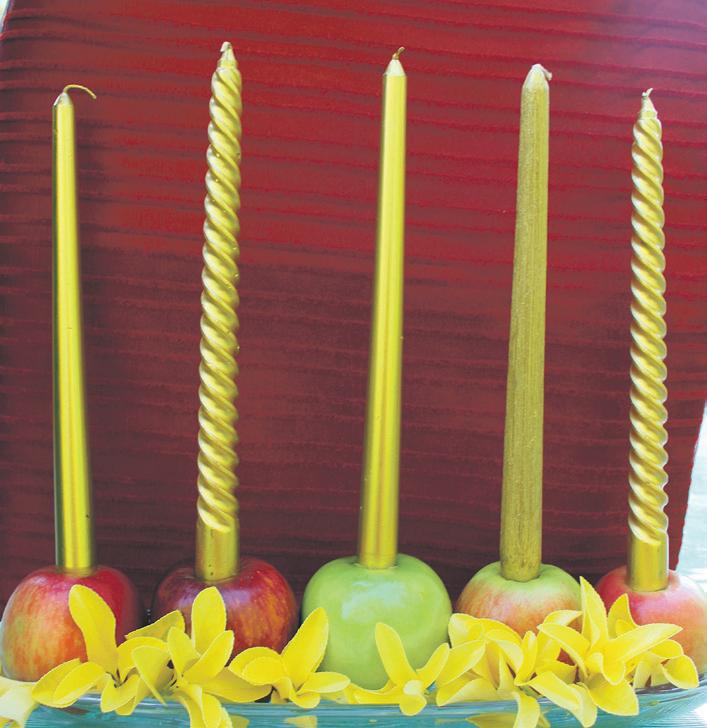
This is a simple, yet effective and very
Normally, the person who lights the lamp is the Griha Lakshmi or the woman of the house. She holds an important status for performing this daily ritual. With this simple act she starts the day, leading the way for other activities to follow. Likewise in Hindu temples, the Garba graha (sanctum sanctorum) is small and dark, quite unlike the bright and lavish exterior. The deity is visible only when the aarti is performed. It probably denotes that man has to give up the external trappings and direct his mind inwards towards the garba griha of his heart, guided by the lamp of knowledge.
Magical myth
The camphor, which burns itself out in the process of lighting up represents our vasanas or desires. In doing so it gives forth the fragrance of love and service to mankind. During the aarti, we close our eyes, contemplate and bend down to look inwards at the Aatman within us. Self realisation comes with knowledge. The jyoti denotes the Aatman (the self) and the aarti signifies that we (Aatma) are a part of God (ParamAatma) and we should always
contemporary design that will give your house a cheerful look.
You will need:
5 large apples (egs. Granny Smith, Red Delicious, Sundowner) that will sit up straight and are sturdy, not soft
_Serving dish or tray
_5 taper candles
_1 bunch seasonal flowers
Take each apple and gently remove the core with a circular core peeler. Make sure the hole in the apple is large enough to fit in the base of each candle. Wipe clean and dry the dish or tray and arrange the cored apples, securing them in place with some
Continued on page 12
contemplate (Dhyaanam) on him.
Caught up in the worldly rat race, we often forget to stop and ponder over life’s broader significance. Possibly for this reason, the Hindu calendar is dotted with numerous but very meaningful festivals. The legends of Narakasura, the dark demon ruler of Praagjyotisha Puram (land of darkness) and Ravana, the mighty king of Lanka reinforce these concepts of ignorance and knowledge. The ignorant is always re-born (Punarapi jananam punarapi maranam). God who is immortal is worshipped as Gnana Jyoti or Light of Wisdom. When Narakasura was killed, all those who suffered under him were overjoyed. Having led a life of darkness till then, both internally and externally, they celebrated the occasion by lighting lamps.
There is much significance in lighting lamps. The flame of one lamp can light an array of lamps. That one lamp symbolises the Paramjyoti (supreme effulgence). The others symbolise Jivana Jyothis (light in individual selves).
OCTOBER (2) 2011 <> 11
www.indianlink.com.au
Continued from page 11
within the centre of each apple, taking care to gently balance them. Cut stalks off seasonal flowers and arrange at the base of the apples, to cover the rest of the dish, to compliment the fruit. Place the ensemble carefully at the centre or your dining table or a side table.
Instead of using candles, you could use tea-lights but core the apples with a tealight corer (tea-light cutters for fruit are available from specialty stores). Similarly, you could use other fruit like Navel oranges, pomegranates or grapefruit, or even vegetables like cucumber, to add variety of colour and textures.

Tiered treasures
This is perfect for a dedicated Diwali ‘corner’ in your living room or foyer. It adds a touch of sophistication to the home, and gives it a festive feel without having to overdecorate.

You will need:
3-4 boxes of different heights
Silk or satin fabric in your choice of colour
6-8 white candles of different sizes and



a formation of your choice along the tiers, taking care not to crowd them together. Next, take the silver ornaments, filigree boxes, coins and puja items and place them in and around the candles, once again avoiding crowding them. Place the silver stones in and around the formation, and place the flowers at the top and bottom tier. Finally, gently sprinkle the silver rock dust around the ensemble, to give it a mystical look.

A touch of green
Placing candles in tiers on a tray filled with green sand and subtly decorated with flowers to match creates a stunning effect.

Flower floats

Submerged flowers and floating candles in clear, cylinder vases are a visual treat. Coil silver decorative wire around a flower stem and slide it carefully down into a vase. Add water slowly, and the wire will help anchor the flower and keep it from floating to the top. Place floating candle on top of the flower.

Clever cluster
A large candle jar with a bunch of same-sized taper candles inside, all in the same colour, tied with a matching or contrasting ribbon would look great. But make sure the ribbon is placed closer to the base of the candles, to avoid it burning up too.


Delightful doily
Paint, colour or dye a paper doily, and fold it around a drinking glass, securing either with some thin wire or double sided tape. Place a tea-light in the glass and watch it glow! For a touch of adventure, make bandhni prints on the doilies, using a combination of food colours. You could also use lace for an enhanced effect, it’s also less messy to create!
www.indianlink.com.au

OCTOBER (2) 2011 <> 13 NATIONAL EDITION

14 <> OCTOBER (2) 2011 INDIAN LINK
FREE BUSINESS BRIEFING
Potential to earn +$100,000 p.a. while keeping your present job

Are you like most people who have studied various material on wealth creation, then got “fired-up” each time and pledged to go into business for yourself someday, but NEVER got around to it because you
• did not have the (large amount of) start-up capital that was required?
• Just couldn’t afford to give up your full-time job to do so due to existing commitments?
• Simply could not find the right opportunity (one with minimum outlay and maximum returns)?

If you are a motivated, self-starter who would seriously like to attain financial independence, earning a residual income with the potential to exceed *$100,000 p.a. in 2-4 years, starting part-time with relatively no financial risk, then call
(02) 82302521 (24 hrs)
And we’ll introduce you (without obligation) to one of the most lucrative business ventures of our time. This is a genuine, legal and high-integrity opportunity that is attracting people from all walks of life, including highly skilled professionals such as doctors, lawyers and business executives. It is definitely not for those looking for a ‘get rich quick’ scheme or rewards without effort-such things don’t exist.
Understand that if you don’t have, it’s because you don’t act. Call Now. (Serious enquires only)
CONTACT : DEEPIKA SHARMA
OCTOBER (2) 2011 <> 15 NATIONAL EDITION
The glory
Sydney’s Bengali community comes together to celebrate Durga Puja
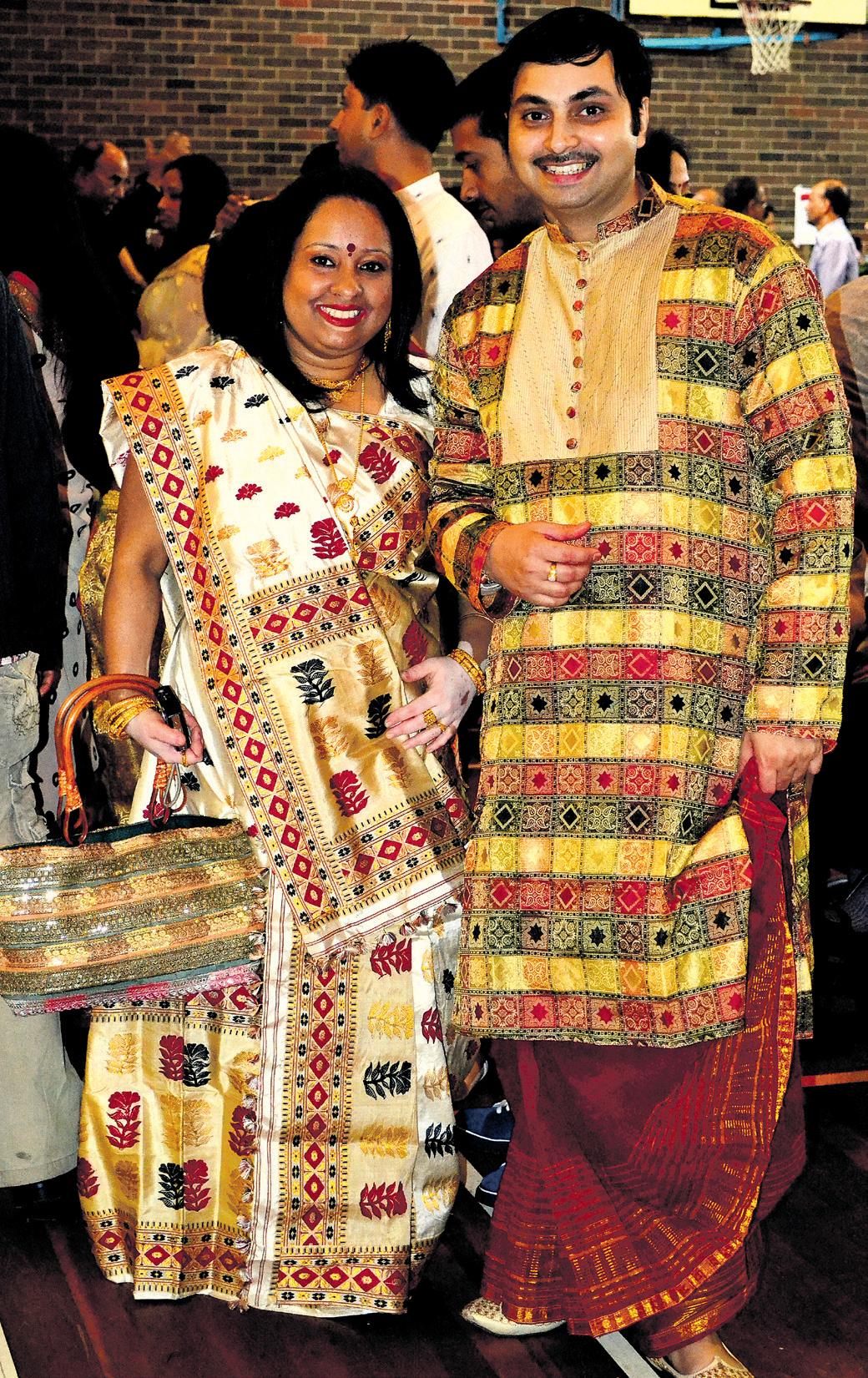 BY RAKA MITRA
BY RAKA MITRA
long weekend of October 1-3.
the city there were at least five different Durga Pujas, and just like Kolkata,
was lots of fun!
The festivities started with mahalaya, when the Goddess was invoked to destroy the evil demon Mahishasura. In Bengal, we would wake up at 4am to a two-hour musical extravaganza including a powerful recitation of the devi-mahatmyam or chandi path. Kakoli Mukherji organised a spectacular show to bring this integral piece of Bengali culture from CD to stage, and saved us the 4am start!


Durga Puja is by far the most important date on the Bengali calendar. The puja denotes the nine-day battle which ensues

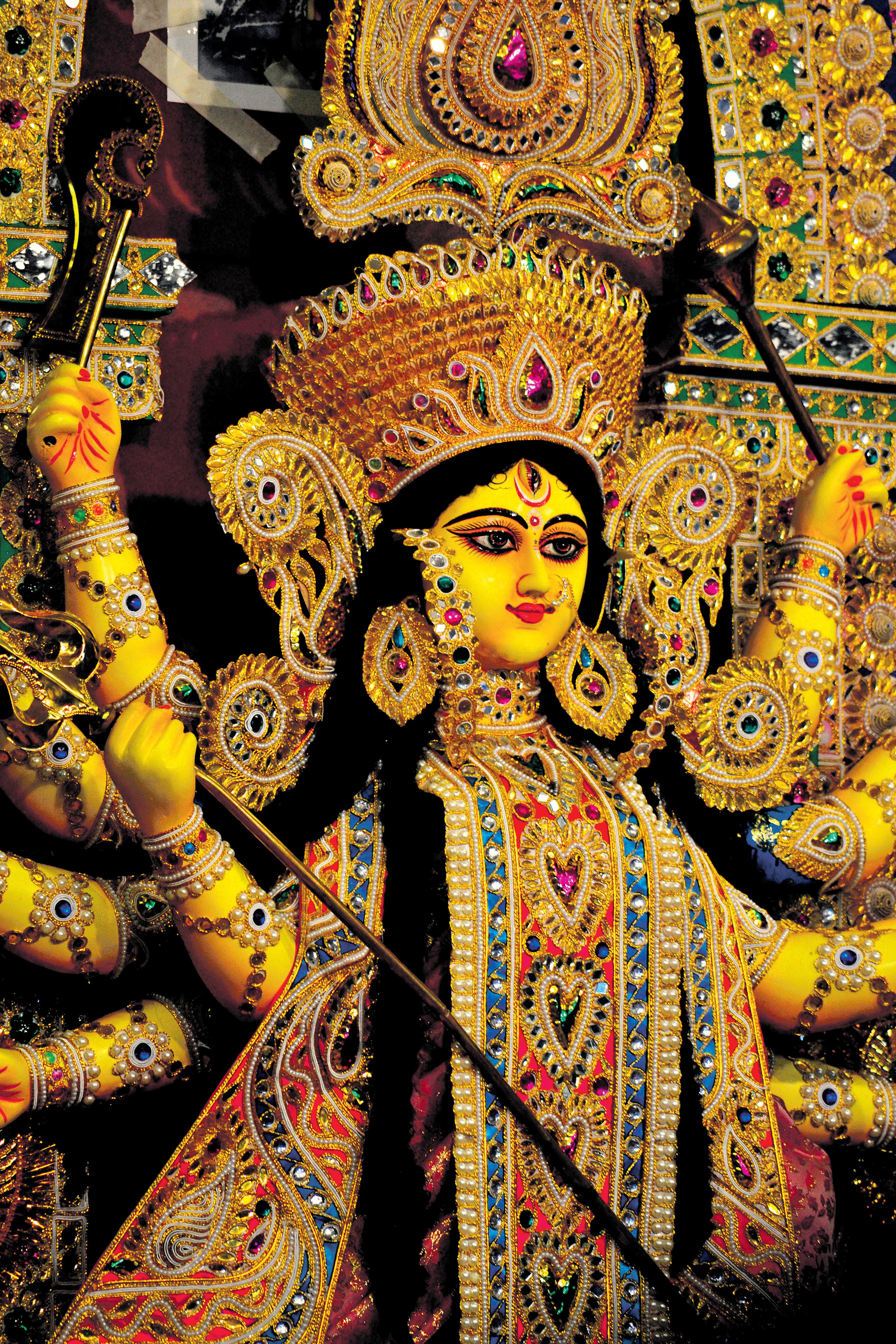
we celebrate Vijaydashmi (victory).
Durga Puja is a feast of culture, colour, art, food and laughter. Everyone wears new clothes - showcasing the latest trends in Bollywood glamour, dancing to the nostalgic beats of the dhak drums and singing out loud, "Bolo Durga maye ki - jai!" (All hail mother Durga!)
Amidst the fun and laughter, what really shines through is the community spirit. Anup Mukerji has been performing the puja for the Bengali Association of NSW for nearly 20 years. Ashish Bhattacharya of the Sydney Utsab puja not only created the idol with his own hands, he also cooked up a grand feast for over 1300 people! Partho Das from the Uttaran puja also handcrafted a stunning idol. Countless others helped with the cooking, serving and organising the magic that is Durga Puja. Children as young as 3 performed in the several cultural shows. With such spirited torch bearers for our culture, we can rest assured that the spirit Ma Durga will live on forever.
As the Bengali saying goes, "Asche bochor
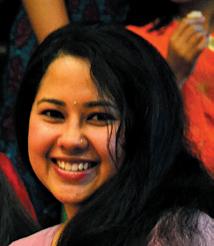

INDIAN LINK
Sounds of the festive dhak echoed through Sydney as Bengalis celebrated Durga Puja over the
Across
puja-hopping
FESTIVAL
Photos Agniva Chakraborty (www.agnichakraborty.weebly.com)
ofDurga




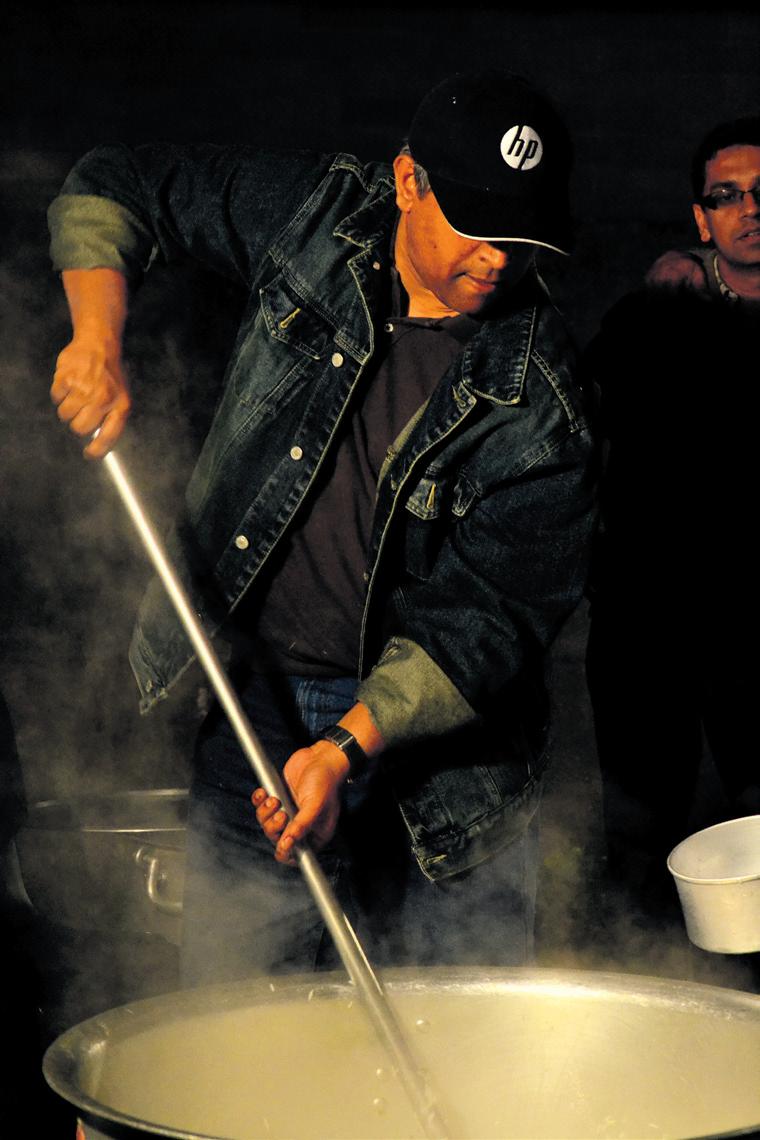
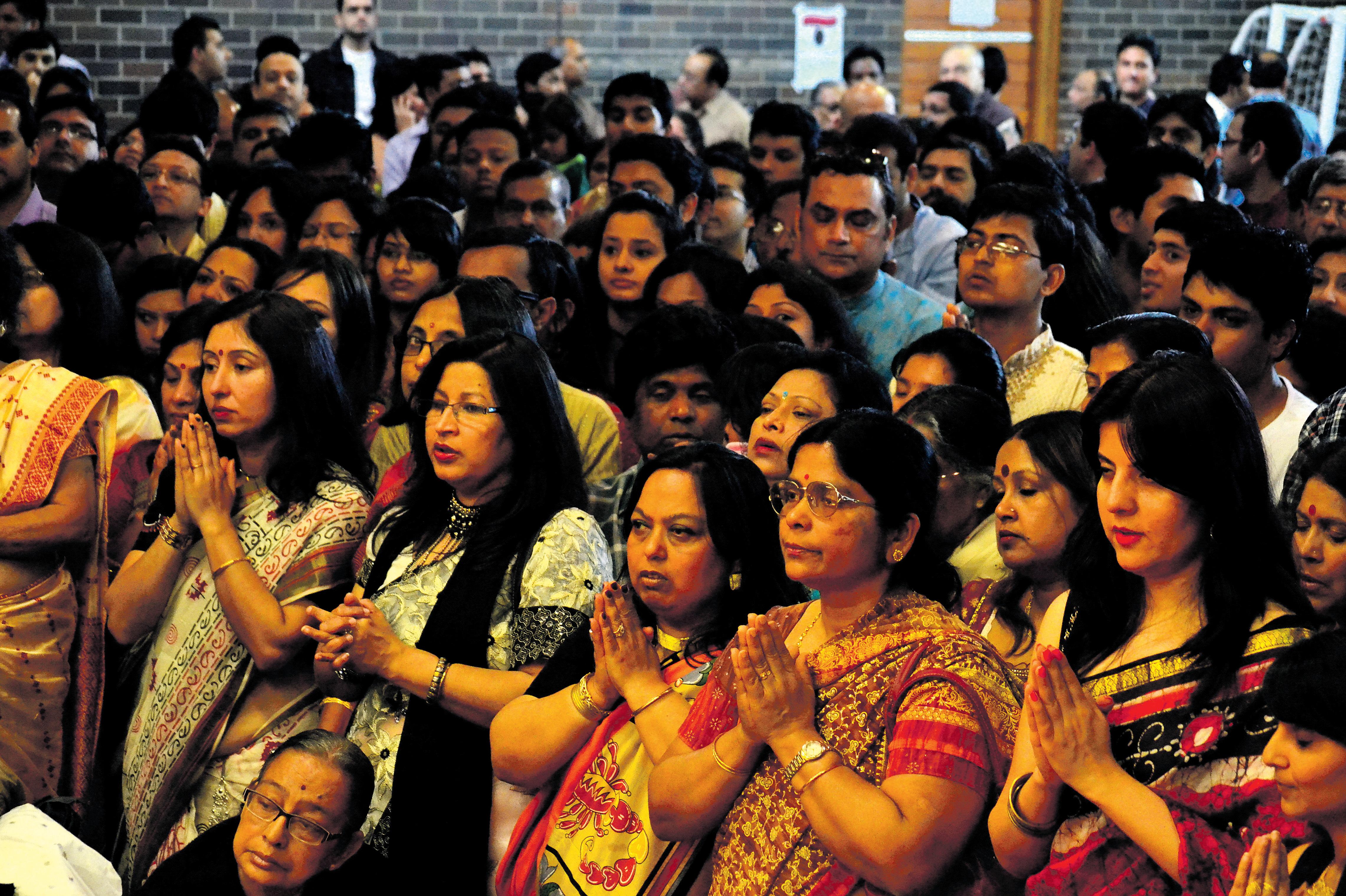


OCTOBER (2) 2011 <> 17
www.indianlink.com.au
Offering the best of travel,

this motto even today,” says Mehdi Juddani, Managing Director. When the agency began operations, they achieved this by negotiating with different airlines and acquiring small deals, which were then passed on to the customer. Very soon, the travel agency was ahead of the competition, and they continued to negotiate, building up their buying power and increasing their base of loyal customers.
Despite a volatile travel industry, lower airfares and diminishing margins, Best & Less Travel has survived, and in fact, even grown stronger. “This is due to their strong forward planning process and working to a business model they created, which allows the company to manage its costs and yet forward savings back to the customer,” stated Mr Juddani.
Best & Less Travel was founded by Mehdi Juddani in 1995, on realising that travel agents catering to the Indian subcontinent sector were setting high margins on their airfares, but not sharing their saving with their customers. It was a win-win situation for these travel agency operators, but the customer was at a loss, having to pay a premium price for tickets to the Indian subcontinent. “Best & Less Travel was founded with the goal and objective to provide the cheapest airfares to their customers, and we maintain

Best & Less Travel offer the cheapest airfares guaranteed to a range of destinations, whether it’s a trip back home, a long-awaited family holiday, a honeymoon or a roundthe-world trip of a lifetime. Helpful and thorough staff sort out all travel enquiries, offering a range of attractive options and related services. The agency’s website at www. bestandlesstravel.com.au displays the latest deals, and has a call-back facility of fifteen minutes if a customer chooses to speak directly to a representative. Alternatively, customers can call on 1300 GO BEST (1300 462 378), as friendly staff answer calls promptly and efficiently. The agency offers travel solutions for trips around the world, as well as tailor-made packages to suit the customer’s taste and budget.
Best & Less Travel has not gone unrecognised for their support of the travel industry. The agency has won many industry awards, including Singapore Airlines’ top agency awards five years in a row.
Over the years, Best & Less Travel has been actively involved in a range of community-oriented activities such as sponsoring charities, events and donating money, time and effort towards the betterment of the community. This is a measure of gratitude for the support and confidence its subcontinent customers have shown the agency.

Today Best & Less Travel is the largest travel agency operating for the Indian market, with three offices nationwide and employing over 35 staff.
Best & Less Travel has expansion plans for the future, with the aim of opening up more retail stores to cater to its increasing base of satisfied customers. It plans to introduce some new web initiatives too, helping make the online experience a more user-friendly and mutually beneficial one.
So if you are looking for the cheapest airfares, come to Best & L ess travel. Because no one does it cheaper than us.

18 <> OCTOBER (2) 2011 INDIAN LINK Close to Central station in Sydney, Sale $7500-$8000 a week, Profit more than $2000 a week, high margin. Very Low Rent with long Lease, Spacious Shop area 90sqm, currently Open 5.5 days but have approval for 7 days. Also have an internet cafe with 5 computers, does about 10 kg of coffee a week, very busy shop with future growth potential. Owner has other commitments. Students could be eligible to apply for PR or Business Visa.. Asking $125000 plus stock Contact Nitin on 0411455506 Cafe/Convenience FOR SALE Ladies are you struggling to get the right style hair cut? If YES, call now on 02 9760 1625 or 02 9760 1645 to book your appointment with one of our multi award winning expert Hair Stylists. Plus the FIRST 27 CALLERS with confirmed bookings will receive a Complimentary Consultation & Straight Hair Blow dry (save $67) www.fatanashairandbeauty.com.au Beauty (02) 9760 1645 LoveYourLook
cheap!
Advertorial

OCTOBER (2) 2011 <> 19 NATIONAL EDITION
The doll festival
BY MALLI IYER
From Baulkham Hills to Cherrybrook, from Parklea to Little Bay, from Blacktown to Astoria Park, it’s been an interesting journey for my wife Mythili and me. We visited several houses in Sydney to view their ‘golu’ creations, and each was special and unique.
We were impressed, not just by the creations and their magnificent array of dolls and statuettes, but also by the intricacy of detail and some clever creative elements that had been included to make each one different in its own right.
‘Golu’, also called ‘kolu’, ‘bombe habba’, ‘bommai habba’ or ‘bomala koluvu’, depending on which part of south India you come from, is an impressive array of dolls arranged on tiers or steps (usually oddnumbered at 7, 9 or 11), called are decorated beautifully against a backdrop of coloured or plain cloth, sometimes with lights to enhance the effect. The decorated with dolls at every tier, some of gods and goddesses, others of figurines, with at least a few wooden dolls. The display is usually a result of a collection that has grown through the years, sometimes
even with dolls that have been handed down through generations. Many have significance such as the mother-figure, women’s traits of fertility, home-building and family themes, and each is arranged to indicate the individual creativity of its builder. Some displays even have animal creations, in fact, anything that is significant of one’s life at that time. We viewed an interesting one which had a theme of cricket just besides it, leaving no doubt that the family is an avid exponent of the sport!
When visiting a home to view their golu, it is traditional to offer ladies and girl visitors prasad, kumkum and a small gift. Auspicious items like the ‘kumbha’ or pot of holy water, covered with silk cloth and decorated with a coconut and mango leaves are usually placed on the lowest tier.

At the end of Navaratri, the golu is



which the displays have been created.
Another highly artistic creation during the festive season which adds a lustre to the Navaratri/Saraswathi
The (golu) display is usually a result of a collection that has grown through the years, sometimes even with dolls that have been handed down through generations
1. Shubha Balachander and Kalpana Rao (Castle Hill)
2. Sarada Ayyar and Ritika (Blacktown)
3. Savitha Karthik (Parklea)
4. Suja Gunja (Concord)
5. Bhuvana Venkatramani and Jayasri Jagannath (Little Bay)


6. Soumya Sathyamoorthy and Shivaranjani (Baulkham Hills)

7. Dishanka Sekhar (Astoria Park)
8. Jayasri Jagannath (Cherrybrook)

9. Aruna Parthiban and Shalini (Baulkham Hills)
Left: Some of the Kolam (rangoli) patterns on display this year
20 <> OCTOBER (2) 2011 INDIAN LINK
FESTIVAL
While it’s not possible to authenticate the festival season to the extent it is celebrated back home, some traditions are kept alive by enthusiastic Sydney residents
Kolam is recognized as a sign of welcome to visitors, an intricate reminder of the age-old tradition of Indian hospitality.
1 2
Pooja in south India, are the intricate designs which are popularly called ‘ muggu’ (Telugu), ‘rangoli’ (Kannada) or ‘kolam’ (Tamil). These bear testimony to the folk art traditions in India that have







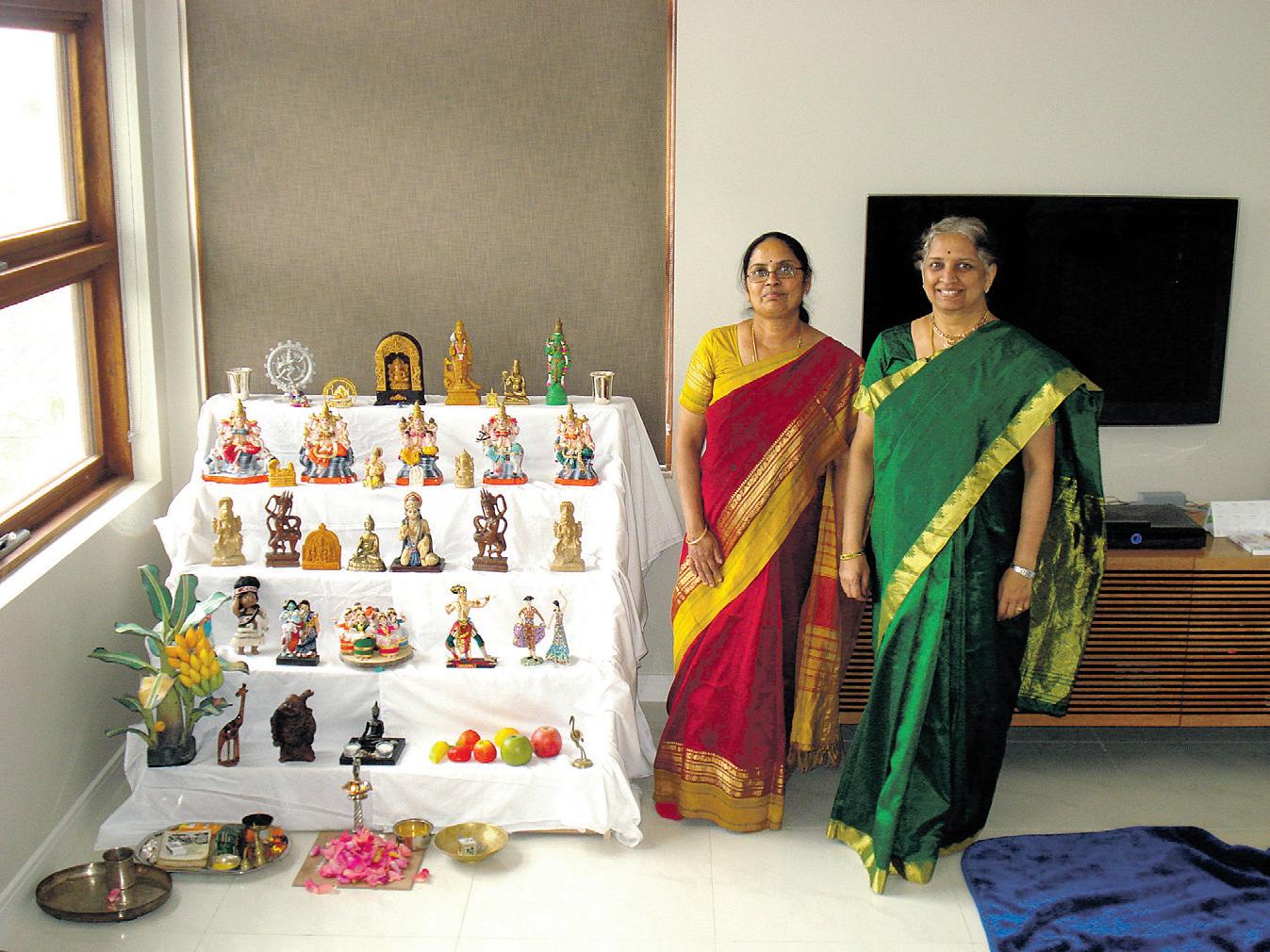
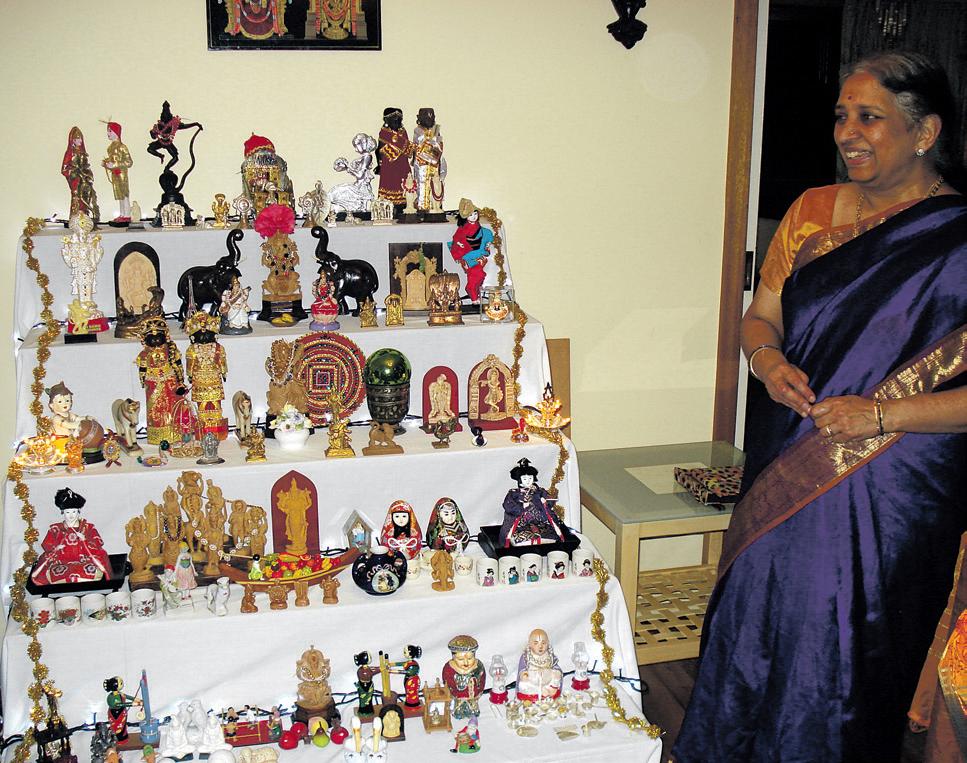




powder (dry or liquefied) that were woven into intricate patterns adorning the entrance to the house paved with cow dung before tiled courtyards were invented. This was done by free hand
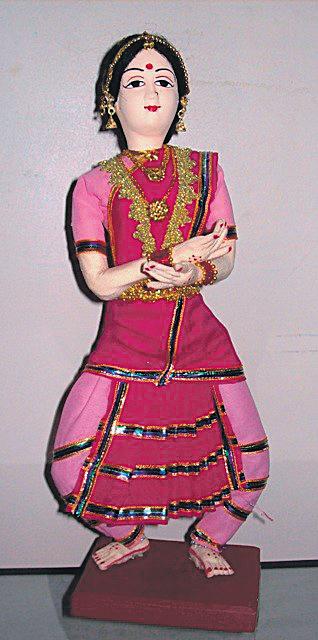
OCTOBER (2) 2011 <> 21 NATIONAL EDITION
www.indianlink.com.au 4 6 8 5 3 7 9
Diwali Milan
It’s an early Diwali celebration at Hornsby
BY RANI JHALA

A promised night of entertainment and fun proved true to its word, as a huge crowd gathered to celebrate Diwali at the Deepavali Milan event at Hornsby recently.
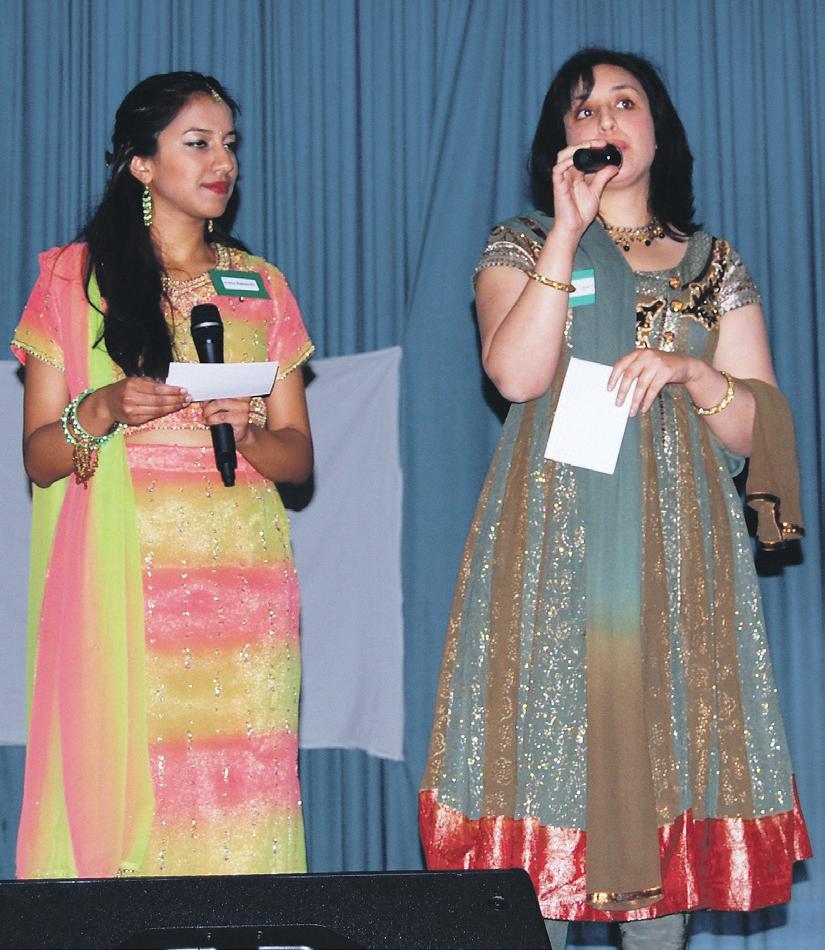


At the Hornsby War Memorial Hall venue, the women dazzled in their glittering garments and the men added elegance with their kurtas and bandh collar coats. It was especially lovely to see the children proudly don Indian attire and run around freely. Crossing nationalities and cultures, people of various backgrounds joined in the festivities. I couldn’t help notice a stunning woman walk past me, her blonde hair beautifully offsetting her purple sari, her bindi twinkling and her anklets chiming. Nearby sat a Newcastle woman with beautiful blue eyes, graceful in her brown sari, which she had draped in the Gujarati style. There were Christians, Hindus and Muslims, collected under a common roof to celebrate Diwali, the Festival of Lights, aptly conveyed by the display of fairy lights and lamps.
At the entrance was the symbolic diya, the remover of darkness, seated upon a colourful flower rangoli created by Mrs Jogmaya Narpatsingh. And around the reception area were the organising committee which consisted of Ms Kamini Sahni, Dr Shibani Sahni, Dr Ena Oberoi, Ms Kavita Mistry, Ms Veenu Singh welcoming each guest. The warmth that was expressed in their welcome, spread through the night and left with each of us, as we took the good will home, at the end of the evening.

The function began with the poojan and aarti done by Lt Col Virender Sahni and conducted by Panditji Narander Dave. The loudest accompaniment from the audience came when he recited the ever-beloved Twameva Mata Cha Pita Twameva. The little Aussie accents added a quaint touch, as the children joined in the recitation. After the pooja, we were entertained by a variety of dances, each beautifully choreographed and gracefully danced. The bharatnatyam dance by the Taal Dance Academy began the night’s show with a beautiful piece set to filmi music. This was followed by Matt Falloon and his magic show. Drawing participants from the crowd, he had the children engrossed for a good half hour. A short film on Hanumanji kept them further engrossed as they ate their dinner.
This was followed by more dances, by the Divaz group. The young dancers kept every eye glued to the stage as they swayed to Bollywood rhythms. Each item was lovely but the sublime one would have to be Ms Dola and her team moving to the song Radha Kaise Na Jaale from Lagaan. I caught up with her as she left and learnt that she runs a dance school. Pity I don’t have a daughter to send to her school.
When dance took a break, music kept us thumping our feet to the beat of the exuberant music of the three very talented singers – Mr Vinod Rajput, Ms Shobha
savour. Lucky dip and raffles were drawn by Mrs Maya Narpatsingh, Mr Vinay and Mr Vishal Gupta respectively. Poetry books were gifted by Ms Rekha Rajvanshi to the children. Finally Ms Shobha Ingleswar entertained the kids with a few more songs, giving the parents the opportunity to relax and watch their children dancing on the stage with Shobha and Kamini. In the background the DJ moved to the music he played. The two masters of ceremonies, Dr Ena Oberoi and Ms Astha Rajvanshi enlightened all with the introductions.

The kids probably best displayed the spirit of Diwali. Beaming with smiles, they befriended the children next to them, they jumped and they giggled, they laughed and they danced. And while they were loud, it
was a nice ‘loud’, which made the evening truly a family event. As Swati Arora later commented, “It was so hard to take the kids back home – they just wanted to stay and dance to the beats!” Rekha Rajvanshi expressed what many later repeated, “This program is unique in that it includes children and makes it a family occasion.” And where women gather, there can be no event without shopping. Here too, the ladies disappeared in pairs as the sari sale beckoned them with its glitter and colours.
And that spirit of Diwali was proved to me most definitely by a young teenager, Jayant. With my camera not giving me the shots I wanted, I approached a young man walking around with a camera around his neck. Hesitantly I asked for his help. With a beaming smile he not only gladly agreed to get me the shots of the night but so sweetly took two photos of ‘this Aunty’.
With things running so smoothly and to clockwork, it was easy to overlook the incredible work that was put in by the organising committee and their friends. Well fed, highly entertained and spiritually blessed, we finally left taking with us, happy memories. It had been such a wonderful
night and I had been very proud of myself for having resisted the dessert after dinner. We bid goodbye and were farewelled with a warm hug from Shibani along with our prasad – a lovely besan ka ladoo. Oh well! It was Diwali, a night of celebrations and festivity. I could only fight temptation so much: the ladoo was consumed with relish.
22 <> OCTOBER (2) 2011 INDIAN LINK
www.indianlink.com.au DIWALISPECIAL
Photos: Jayant Babbar and Pratima Jadhav
Management and staff of Jet Airways (India) Ltd.
Wish you all a Happy Diwali

World Class service with Warm Indian Hospitality



OCTOBER (2) 2011 <> 23 NATIONAL EDITION
Parentof the Year
Neelam Nagrath is felicitated for her community work at her daughter’s high school
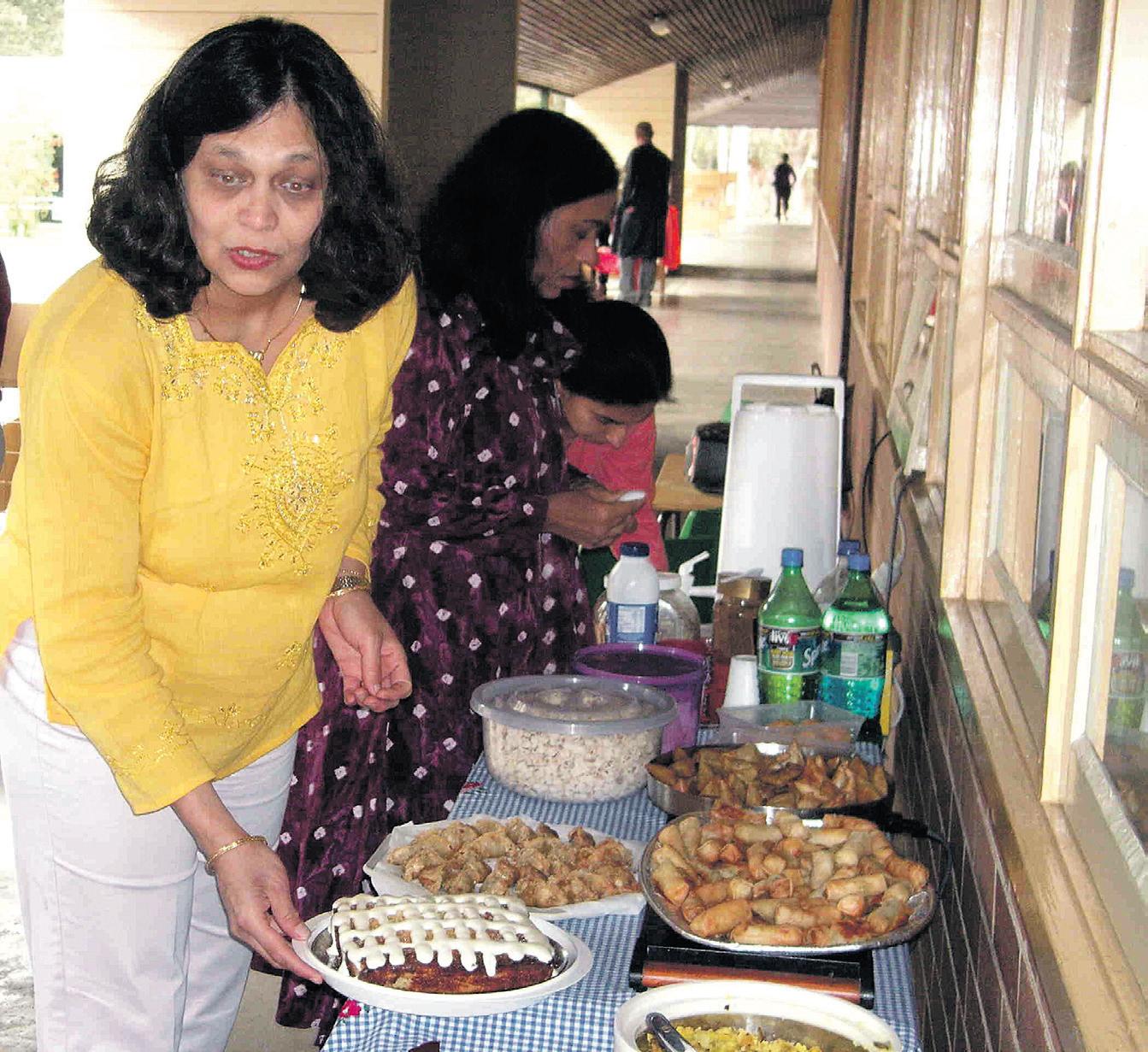 BY RAJNI ANAND LUTHRA
BY RAJNI ANAND LUTHRA
Hornsby’s Neelam Nagrath has won the NSW Department of Education and Training’s Parent of the Year award for 2011.

Neelam has been at the Hornsby Girls High School’s P&C Association since 2007 when her daughter Prachi joined the school in Year 7.
Principal Rob Phillips (now retired), who nominated her for the award, said in The Hornsby Advocate after she won, “Neelam has been instrumental in galvanizing the diverse members of our school community to be active participants in all facets of school life… She has significantly contributed to the growing sense of cohesion, harmony and teamwork in our community, efforts which have brought immeasurable benefits to our students, parents and staff”.
“Rob was always very committed to parents’ involvement in the school,” Neelam says. “The P&C at Hornsby Girls’ has been very strong. Our school has been winning the Parent of the Year Award for the last six years running!”
Neelam believes strongly that as parents we are partners in the education of our children. “Today the school takes a holisitic approach to the kids’ development – there’s equal emphasis on academics, sport, music… there are so many activities that parents are encouraged to get involved to help ease the process”.
She adds, “I’ve also observed that the more we as parents are involved with the school, the more comfortable our kids are at school”.
But it is not only about the kids. “Being part of the P&C, I’ve had open channels of communication with the school and with the wider community. It has helped me feel part of the fabric of the local community and has enhanced my sense of belonging to the new culture into which I have come”.
Some of the events that Neelam has put together for the school community include father-daughter nights, crazy whist and trivia fun nights, and multicultural days.
“It’s heaps of fun, really. Small contests such as ‘Fastest SMS challenge’ - or knitting competition where everyone on the table has to knit one line according to instructions - create plenty of laughs and are remembered for a long time! It is all intended to help ease the pressure on the girls in their competitive selective school environment”.
Neelam’s efforts to organise Indian events at school, whether with dance and music, or with crafts or other cultural activities, have gone down particularly well. One of the highlights for her has been her work with an exhibition of photographs of Mahatma Gandhi that she helped organise for the school’s history faculty. Mala Mehta of IABBV Hindi School was instrumental in taking this exhibition to various schools around Sydney and was grateful for Neelam’s help in this regard.
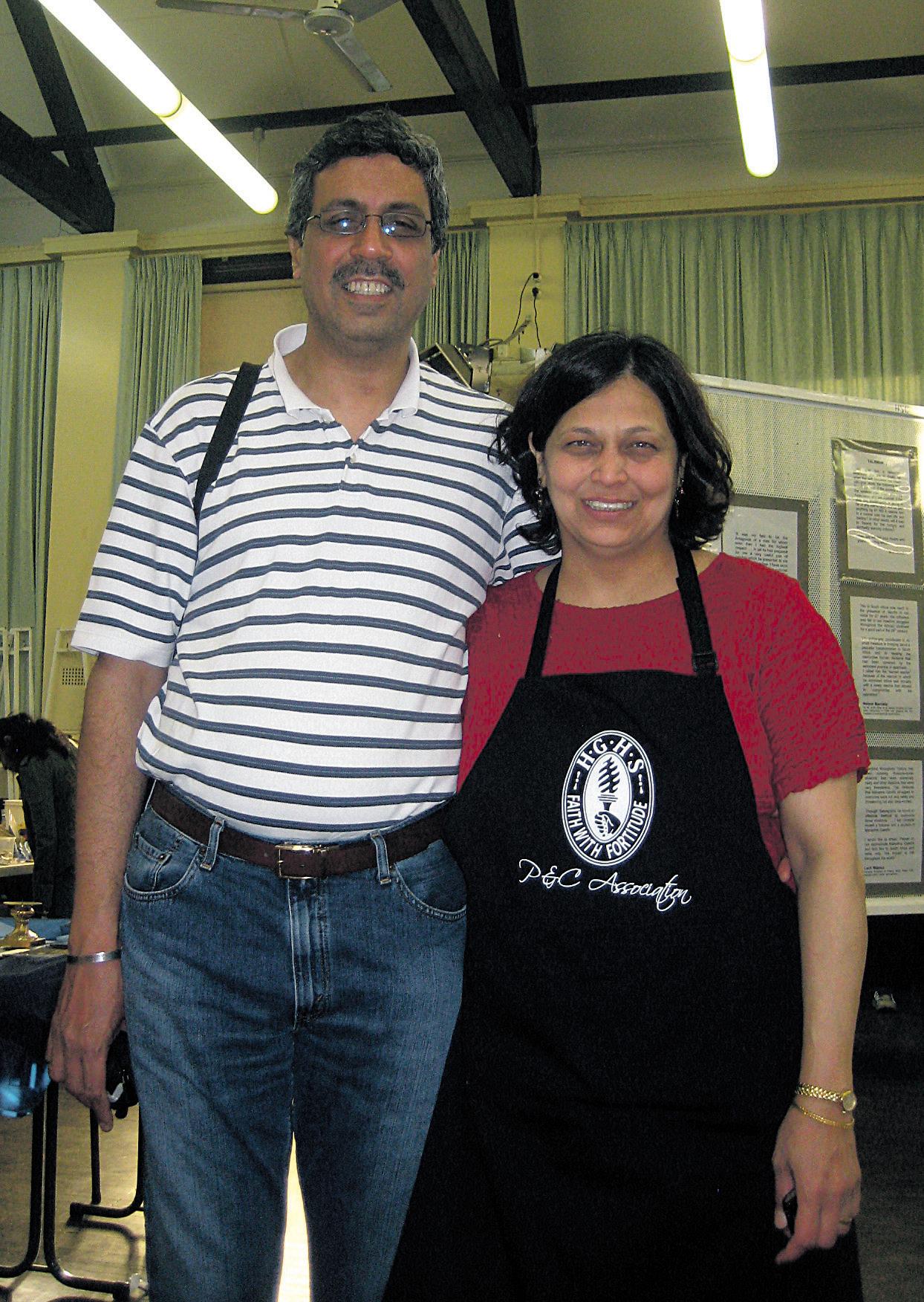

“Neelam is untiring in her efforts and totally selfless in community work,” Mala Mehta says of Neelam. “I have had close contact with her as a parent at Hindi School - she was also the Secretary of our own

P&C from 2004 to 2006, and continues to come and help at our community functions”.
And while it is the parents who are usually proud when their children come home with a school award, Neelam’s kids are very proud to see their mum win a school award.
Prachi has imbibed her mother’s strong values of communitymindedness, helping out in various ways herself, such as organising cheese and biscuits at parent-teacher nights, or helping at the functions that mum is involved in. Husband Rajeev and son Dhruv also usually get roped in.
Instituted by the Department in 2004, the Public School Parent of the Year Award recognises parents who have made a significant contribution to their local government school community. This year, there were 27 winners state-wide, with Neelam winning the Northern Sydney region. Any parent of a student currently enrolled in a NSW government school is eligible to be nominated for an award. The nomination can be made by an individual, school or parent organisation.
24 <> OCTOBER (2) 2011 INDIAN LINK
PEOPLE www.indianlink.com.au
The more we as parents are involved with the school, the more comfortable our kids are at school Being part of the P&C has helped me feel part of the fabric of the local community and has enhanced my sense of belonging to the new culture into which I have come
Above right; Neelam Nagrath with husband Rajeev at the school’s Multicultural Day Left; Volunteering at IABBV Hindi School, Thornleigh

OCTOBER (2) 2011 <> 25 NATIONAL EDITION
Championing women’s causes
Empowering women is a priority with this lawyer who recently won a prestigious award for her work
 BY UTTAM MUKHERJEE
BY UTTAM MUKHERJEE

I stood outside a lawyer’s office in Parramatta, but not for any legal or visa reasons, but simply because a newspaper article had recently caught my eye. It reported that a lawyer based in Parramatta was helping female migrants and refugees overcome discrimination in the legal industry and society, and that she had received the Women Lawyers Association’s Highly Commended Judging Panel’s Award. I knew I had to meet this champion.
Dr. Chandrika Subramaniyan is primarily a solicitor and has championed many worthwhile causes. She has won many nominations and awards for her contributions, particularly in law, such as those from the Women Lawyers Association, NSW, and the Law and Justice Foundation, NSW. From humble beginnings as a migrant, she has come a long way.
I found Dr Chandrika a down-to-earth lady, but one who meant business, so we went right to the crux of the interview. Dr Chandrika humbly narrated her initial struggles as a first generation migrant. “The award and recognition mean a lot to me,” she said. “This award was recognition of fifteen years of hard work in the legal profession. Also, it was the first time a lawyer from the subcontinent got this award, and I hope it will motivate other migrants to contribute to the community.”
Dr Chandrika pointed out that what drew the attention of the Women Lawyers Association was her work on the emancipation of women. “I ensure women’s access to legal resources, encourage them to enter the legal profession and guide them in balancing their family and work place,” she revealed.
It’s no surprise that for the last six years, she has devoted many hours every Wednesday to offering free services to migrants and refugees. In each of those sessions, she sees four to six clients.
Initially Dr Chandrika did not want to cite examples of her voluntary help for reasons of privacy. But, when I persisted, she narrated a few without divulging details.
A client from the subcontinent suffered domestic violence at the hands of her husband, who threatened and locked her in their house. “Sometimes husbands bully their submissive wives because they know that they are ignorant of the law and wouldn’t want to bring shame to the family,” stated Dr Chandrika. “I came to the rescue of the client and provided advice. I was pleased when finally, the client got her PR as well”.
On a funnier note she told the story of a Sudanese man who had given his wife eighty cows as dowry. When the wife ran away with
another man, he came to her for a resolution. He was insistent that his ex-wife return the cows. Of course, the cows were in Sudan. Dr Chandrika had to resort to her wits to solve the case. Finally, the man accepted his fate and ‘lost’ the cows!
“In a peculiar case, a wife complained that her husband was abusing their child and the matter went to the Family Court. There it was found that the husband was innocent. It turned out that the wife wanted full freedom and custody of their child,” related Dr Chandrika.
I was curious to know how Dr Chandrika started her advocacy on women rights. “It started with a few friends who faced family problems, which made me realise that our community needed women lawyers with a heart. The main problem with married women from India is that they are unaware of their rights and men take advantage of this by curbing their freedom,” she revealed. Sometimes men have extramarital affairs and threaten their wives with visa cancellation or to take away their government-entitled child benefit allowances. “To help women have the support they need, I started to provide free advice to women at multicultural services in Blacktown, while assisting them in getting social justice,” said Dr Chandrika.
Dr Chandrika Subramaniyan has a range
of skills and qualifications. In the past she was editor of the Express newspapers in India, as well as an IT professional. In fact, she has taught IT at TAFE! She has authored many books too.

She received awards for two of her books: Women and Media and Indo Russian Relationship: Political and Cultural Perspectives. The former was the first of its kind in India and appreciated by the then Chief Minister of Tamil Nadu, Dr M Karunandhi. Today, she does radio programmes for SBS and writes articles for Navtarang and Tamil papers.
I found it hard to believe how she manages to do so much and yet appear composed. “Sound time management, the ability to multi-task, and the support from my family are what works for me,” said Dr Chandrika. She must be right because before leaving, I found out that she is pursuing a Masters in Criminal Prosecution at Wollongong University and writing on Annamacharya Keerthans in Tamil!
Your chance to have a business in India

Experienced, Successful Network Marketers who are looking for a Ground Floor Opportunity with a large, debt free, International Company soon to launch into the Sub Continent. This Company is present in 19 countries. Only one product, no warehousing, health beverage. We are looking for 3 leaders. Must be Ambitious, Hard working, Honest and Teachable. Give me a call. I am 79 years old
I am only looking for people who are genuinly seeking 'their Big Chance' in life and are prepared to work hard to get it. Free
26 <> OCTOBER (2) 2011 INDIAN LINK
sample of
to
who attend the interview
Helen on 0414461673
product given
all
Call
PEOPLE www.indianlink.com.au
The main problem with married women from India is that they are unaware of their rights and men take advantage of this by curbing their freedom
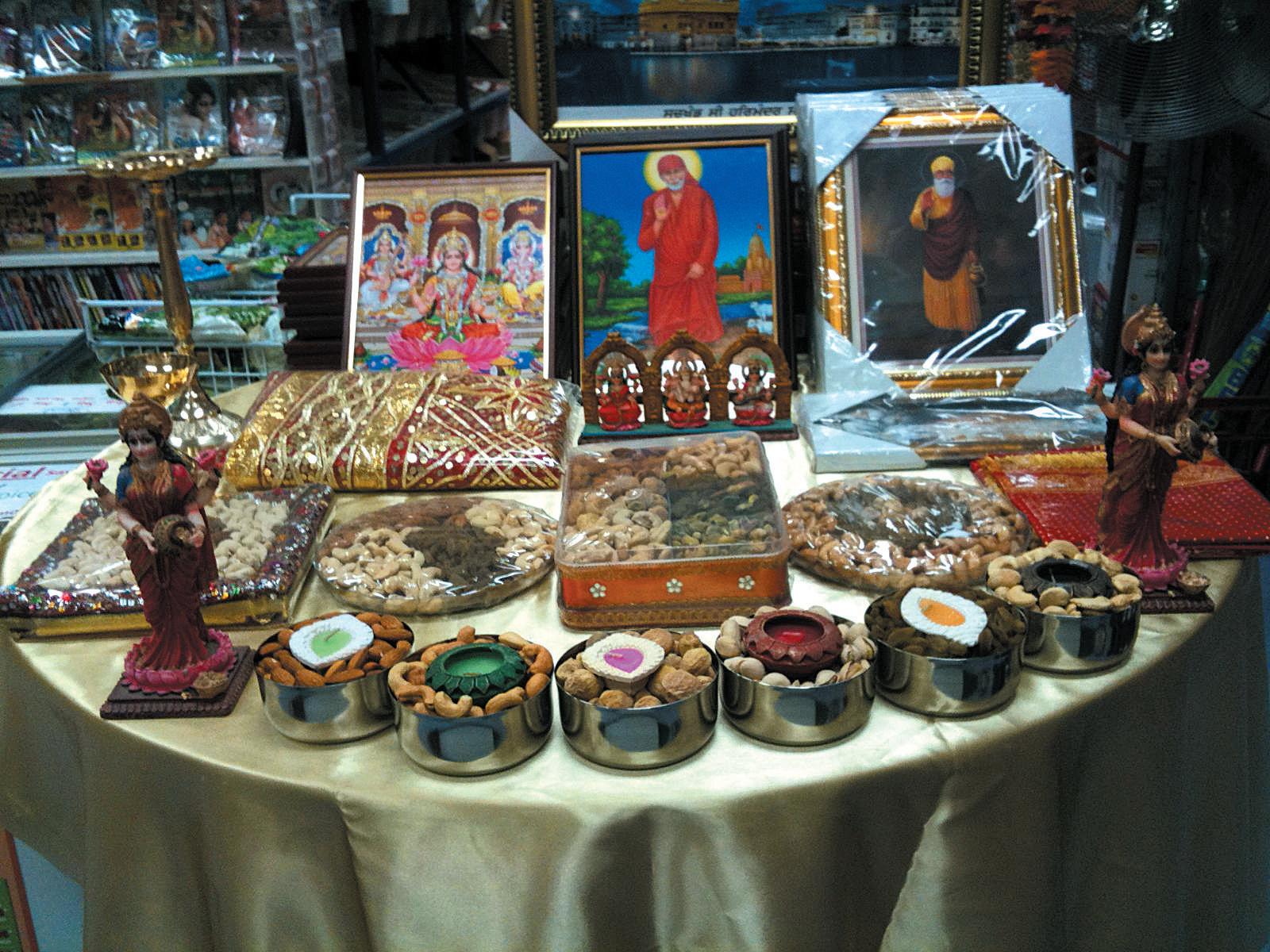





OCTOBER (2) 2011 <> 27 NATIONAL EDITION SPECIAL Price Hawkins 3 Litres classic for only $39.95 143 Stephen Street (cnr Sackville Street), BLACKTOWN www.indianspices.com.au ONE STOP SHOP FOR ALL YOUR NEEDS DRY FRUIT pre packed available. Wide variety of fresh sweets available
Protecting God’s earth
Do faith and religion have a role to play in environmental sustainability?
BY ASTHA SINGH
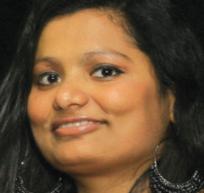
Environmental ethics expand traditional ethics to a complex level. Although all ethics seek an appropriate respect for life, we do not just need a humanist ethic applied to the environment. There are analogous ways we have to think about the issue, such as in relation to business, law, medicine, technology, international development and nuclear disarmament. It certainly needs to be discussed on a wider front and from multi-disciplinary viewpoints.
Tackling the same, a multifaith forum on environmental ethics was held recently as an initiative of the Australian Religious Response to Climate Change (ARRCC) and Hindu Council of Australia (HCA). A panel of six speakers, representing each of the main religious faiths put forward their views on the issue, on behalf of their respective religious communities. These included Edwin Humphries (Baha’I), Bhante Sujato (Buddhist), Rev David Reichardt (Christian), Prof D P Chaudhri (Hindu), Ms Zuleyha Keskin (Islam) and Rabbi Paul Jacobson (Judaism).
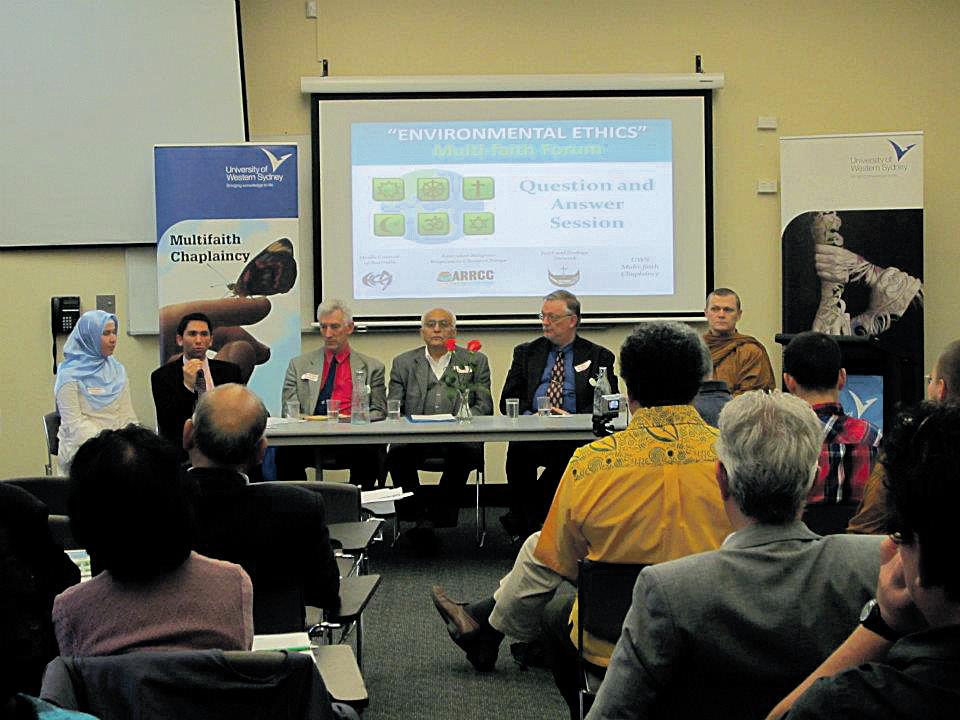
The event took place at the University of Western Sydney, Parramatta campus auditorium in early October. The forum was chaired by Dr Nihal Agar (Chairman of the HCA). The initiative was organised and supported by Vijai Singhal, Convener and Director, HCA, Executive Committee Member, ARRCC.


The forum began with the spiritual foundations for sustainability. The Bahá’í perspective was that Man is organic with the world. His inner life moulds the environment and is itself also deeply affected by it. Speaker Edwin Humphries observed that according to his faith, “Religion is the chief instrument for the establishment of order in the world and tranquility amongst its peoples,” implying that this includes order in the environmental world.

Environmental justice is a strong Jewish value, noted in its covenants like Brit (we are partners with God in the upkeep of the world), Tikkun Olam (repairing the world), Tzedek (righteousness/justice), Bal tashchit (do not destroy/cut down), Tza’ar ba’alei chayim (prevention of cruelty to animals), B’tzelem Elohim (created in God’s image). The need for balance – and using only what we need – are also relevant tenets relating tot eh environment. Rabbi Paul also mentioned that regulating air pollution is not a new idea in the Jewish world. Talmudic sages developed regulations for noise, smoke and odour.
‘Reduce, Reuse, Recycle, Rethink’ has been one of the Jewish symbols relating to sustainable environment.
The Islamic outlook was presented by Ms Zuleyha Keskin, a PhD student in the same field. She stated that Islam asserts that all life is special and valuable because it is the life and the art displayed by each creature that connects
it to the Divine. To a Muslim, God has created this universe like a majestic palace; therefore, in Islam, the natural environment and animal forms are valuable. There are about 500 verses in the Qur’an giving us guidance on care of the environment, Zuleyha said, quoting one: Eat of their fruits when they come to fruition, and give (to the poor and the needy) the due thereof on harvest day. And do not be wasteful; indeed He (God) does not love the wasteful.
Christian views started with some urgent ethical questions put forward by David by means of a fascinating thought: is it ethical to populate the planet at the rate we are doing? Is it ethical to go to the very extremes of our technology to exploit the earth’s resources, thus risking its and its inhabitants’ well-being? Is it ethical to subject non-human species to loss of habitat because of human activity? Is it ethical that the habitat of poorer societies is at risk because of the activities of wealthier ones? David also mentioned the contribution of various environment-friendly campaigns and initiatives run by churches to the society.
The Buddhist view presented by Bhante Sujato promoted simple, sustainable living and caring for the environment. The life of a Buddhist monastic, Sujato underlined, is dedicated to simplicity. “At the core of our beliefs is the idea that we should do not harm, and that material possessions are irrelevant for finding peace”.
The Hindu perspective on environmental ethics as outlined by Prof Chaudhari was also along similar lines. He mentioned that religions that arose as part of the Indian civilization accept that nature does not have a break in the continuum of living forms. Evolution of humans is only a work in progress. Their shared core beliefs - the law of causation (Karma) and “Unity of all Existence” - have pervasive implications. Greed driven neo-liberalism focused on consumerism, is short-sighted. Hindu perceptions, historical and contemporary, require inclusive and sustainable economic development that leads to joyful, meaningful and Dharmic life that is in tune with Nature.
Following the thought-provoking talks by speakers, and the vote of thanks by Chair of ARRCC, Thea Omerod, attendees broke for lunch and then attended one of three participatory workshops. These were on Sustainable use of natural resources by reducing consumption and wastage (run by Ms Trish Madigan); Sustaining biodiversity by preserving plants and animals (run by Ms Anne Lanyon), and, Living a simple, happy and peaceful life-style free from greed, hatred and fear (run by Ms Shehara Vishwanathan).
The forum sent a big picture message to the society that no matter how different a particular religion or culture or community is from another, there are similar beliefs about Mother Earth and our environment, which brings together a sense of responsibility and as well as one of circumspection.
Eat of their fruits when they come to fruition, and give (to the poor and the needy) the due thereof on harvest day. And do not be wasteful; indeed He (God) does not love the wasteful. The Qur’an Hindu perceptions, historical and contemporary, require inclusive and sustainable economic development that leads to joyful, meaningful and Dharmic life that is in tune with Nature.
28 <> OCTOBER (2) 2011 INDIAN LINK
COMMUNITYSCENE
www.indianlink.com.au
Photos: ARRCC
Dr Nihal Agar, Chairman of the Hindu Council of Australia
Speaker at the multifaith forum


OCTOBER (2) 2011 <> 29 NATIONAL EDITION
One voice can make a difference
An award-winning play about the Mumbai terror attacks comes to Sydney
BY PRIYANKA
‘26/11’ is a date that will be embedded in the minds of Mumbaikars for generations to come. On that day I was in Mumbai, working for a leading television news channel. As we wrapped up after a hard day’s shoot, the editor-in-chief came rushing out to read us an SMS he had just received: “Terrorist attack at CST”. We dropped our bags and the entire newsroom ran helter-skelter, trying to dig out as much information as possible. Some made calls, some monitored the competition, while some were already on their way to report from location. That night didn’t seem to end and the following 72 hours seemed longer than ever.
So when I heard that one of Mumbai’s leading theatre personalities Divya Palat was bringing her play based on the Mumbai terror attacks to the Sydney Fringe Festival, I knew I had to be there. Bharatiya Vidya Bhavan Australia sponsored the October 2 staging of A Personal War: Stories of the Mumbai Attacks, and dedicated the event to its members and patrons.
A Personal War… is based on true firstperson accounts of six individuals who went through the trauma and tragedy of one of the most heinous and horrific terror attacks in Mumbai’s history.
With a backdrop of the actual footage from the attacks, one by one the characters took centrestage and narrated their stories.
An employee at the Taj who served the guests till his last breath; a businessman who was at a business dinner at the Taj and lost his father; a simple homemaker from Gujarat who lost her son and husband in the firing at CST; a young college boy who had taken his girlfriend to Leopold cafe to propose but lost her forever; a reporter struggling to choose between her conscience and duty, and the writer and director of the play Divya Palat herself - all spoke movingly of the emotional distress they went through.
“It was very personal because for those 72 hours I didn’t sleep even a wink, so the story that I narrate is actually my own,” Divya recalls. “I spoke to the Police Commissioner every half an hour by the watch. He was so strong and he kept saying, ‘It’s all going to be okay’. The only time when his voice broke was when he said that he had lost three of his colleagues and good friends. I felt so helpless. I couldn’t get out, I couldn’t help him.”
A teary-eyed Divya goes on to add with a quiver in her voice, “I told myself that I had to do something. That’s when I started writing A Personal War… I began to interview the survivors. The characters that you see in the play are based on real people and are an amalgamation of a series of interviews that I took, so as not to exploit one particular person or a family.”

The Greek Theatre in the heart of Marrickville seemed well-chosen for the Sydney staging. The simplest of settings saw about 180 seats, almost all taken, semicircled close around the circle stage as if to make the audience share the stage
and the journey of the characters. The props were simplistic: a single chair with a screen as the backdrop running footage from the actual attacks. Minimal, when it comes to the decor and lights but loaded with intensity and with something very personal about the ambience of it all. With the chair as a constant, each character took turns to introduce themselves to the audience. One by one, the audience got up close and personal with each character. Six monologues, conveying one emotion - a promise of living beyond fear, a promise to let hope win over terror. Be it the reporter soaked in the guilt of insensitive reporting or the young lover trying to woo his girl only to lose her forever, or the young business turk who lost his father, or the Gujarati housewife besotted with Bollywood, who’s looking for film stars amidst the “shooting” in CST only to realise later that this shooting was not “Hrithik Rosan” [sic] pulling off a stunt for an action scene - each actor truly lived the character. No melodrama, no over-the-top reactions, no romanticising... this was as real as it could get.
So it was not surprising when the audience literally queued up to personally applaud and congratulate Divya Palat and the actors for an immensely sensitive and sensible portrayal of the Mumbai terror attacks.

(Just a word for all those munching on chips during the course of the play: that sound of the foil can be extremely distracting for actors especially when it’s such a close space with the stage literally 10 steps away from you. It always helps to get one’s priorities right!)
In 2009, A Personal War… debuted at the Edinburgh Fringe Festival, and there has been no looking back since. Not only was it nominated for the Amnesty Award Best Play, it was also ranked as the best Free Show at the Edinburgh Festival. All the proceeds from the Festival were handed

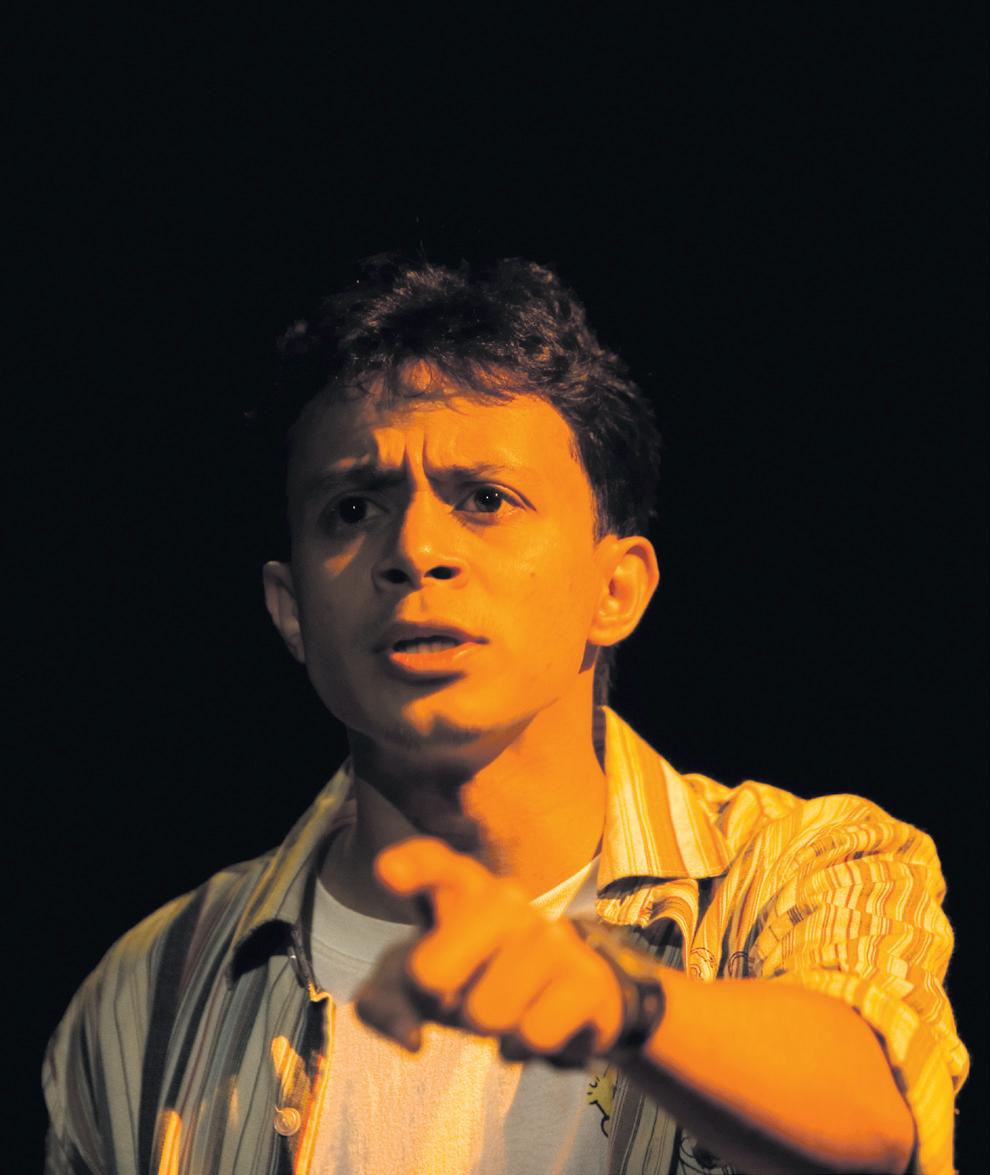
over to the Mumbai Police Commissioner to be used by the police force for better equipment. The same year, a single show was staged for the Police Commissioner Mr. Sivanandan and a few police officers who were at the Taj and Oberoi during the attack of 26/11. Accolades followed as Divya along with her team, was invited to the New York International Fringe Festival in 2010 where she was awarded the Best Director, a first for any Indian theatre director.
Ask her about the response from across the globe and she’s quick to reply, “In Edinburgh we had people talking to us about the London bombings and in New York, there were people talking about 9/11. Survivors across the world share the same emotions, they have gone through the same trauma.”

This play is not just a heart-wrenching narration of the Mumbai terror attack victims, but is also a tribute to the resilient spirit of Mumbai and those brave police officers who lost their lives.
“All the proceeds from the show go to the police commissioner’s office in Mumbai. My belief is that even if it helps one or two policemen, I know that I am heading in the right direction. I can say that I tried to make positive difference,” says a hopeful Divya. And she is making a difference. She says in the play: “Today when someone comes up to me and says, one voice doesn’t make a difference, I have to disagree. It does make a difference… You just have to shout loud enough.”
Hopefully more voices will join in and make this shout loud enough to be heard by the perpetrators of terror, clear enough to make them understand the futility of their actions and just enough for them to embrace peace for the sake of humanity.
The play received a standing ovation as the Indian national anthem played in the background.
30 <> OCTOBER (2) 2011 INDIAN LINK
STAGE www.indianlink.com.au
TATER
“The characters that you see in the play are based on real people and are an amalgamation of a series of interviews that I took, so as not to exploit one particular person or a family”
Divya Palat
Aditya Hitkari, Sanket Mhatre, Divya Palat, Vatsala Kothari in A Personal War...

OCTOBER (2) 2011 <> 31 NATIONAL EDITION





32 <> OCTOBER (2) 2011 INDIAN LINK We are fully trained and accredited 9482 3429 | 0423 418 203 Igreen Carpet Cleaning Services All work fully insured with GIO We specialise in:–• Carpet steam & Dry cleaning • Upholstery & Leather cleaning • Rug & Automotive seats • Stain removal • Water damage restoration • Real estate inspection • Moving In & Out cleaning Ligh ng, Fans & Safety Switches Power & Installa on Electrical Equipment Tes ng & Tags Data, TV & Telephone CCTV & security Alarms Digital TV antenna, Indian satellite dish and solar power system NANWAL ELECTRICAL SERVICES Electrical Contractor Lic. No. 238123C Daleep Kumar 0421466973 | dkumarau@yahoo.com
Passion for pulses
BY RITAM MITRA

A lifetime of dedication, passion and commitment has finally been rewarded –earlier this month, Professor Kadambot Siddique of the University of Western Australia became a member of the Order of Australia (AM), after being named in this year’s Queen’s Birthday honours list in June. The prestigious award is a well-deserved accolade for Prof. Siddique’s lifetime’s work in helping advance agricultural science, through his research in the area of crop improvement and agronomy, as well as his countless contributions to professional associations. As an internationally recognised figure in crop science, Prof. Siddique is widely credited as a leader in various areas such as his establishment and development of the pulse industry in Australia, as well as his expansion in recent years in assisting in building capacity in agricultural science in various economies, including Australia and southern Asia.

Speaking about the honour, Prof. Siddique is overwhelmed. “I feel very humble that people recognise me, as well as extremely thankful for the support of my family and my friends, the farming community and my students – it’s very pleasing to see that a person who was born in India and migrated here has been recognised, which shows that the wider Australian community takes notice of that – those sorts of things are good for the harmony of the country”.
Prof. Sidiqque moved to Australia with his wife in 1981 and completed his PhD at UWA, after having completed his Masters in New Delhi. His origins, however, lie in Kerala, where his parents were also involved in the agriculture industry. “Agriculture has been an interest to me right from the start. I studied Biology, Chemistry, Physics and Maths, and of course I was peer-pressured into and interested in medicine at the start, but I narrowly missed out. I looked around, and I thought agriculture was a great way of moving forward.”
Prof. Siddique’s progression through the ranks is a testament to his dedicated nature - he joined the Department of Agriculture and Food, Western Australia (DAFWA) in 1985, and worked his
“I’m currently working on a theme called climate-ready crops. Carbondioxide levels are increasing, rain fall is declining and temperatures are rising, so I’m looking at the reaction between these factors to decide whether our current types of wheat can cope with these changes in the climate. If they can’t cope, then what traits do we need our wheat crops to have, what do we need to do in the next ten to twenty years?” Prof. Siddique
way up the ranks to become the principal scientist and leader of DAFWA’S Pulse Productivity Program, as well as becoming the Director of UWA’S Centre for Legumes in Mediterranean Agriculture (CLIMA). For the next 5 years, Prof. Siddique held this post, until in 2006 he was appointed to lead and establish the UWA Institute of Agriculture. More recently, in 2009, he received a gold medal and citation from former Indian President, Dr A.P.J. Abdul Kalam, as recognition of his international contribution to pulse research and education. He is also currently the Associate Dean of Research at the Faculty of Natural and Agricultural Sciences at UWA.
Much of Prof. Siddique’s research revolves around the ever-changing global climate, as well as the issue of growing populations and developing economies. Years ago, he recalls, “I did some research and predicted that countries like India, Pakistan and Bangladesh will be short of pulses in the long term. Back in those days, I estimated the shortage might be 5-6 million tonnes of pulses in India – because
the reality is, India is the largest producer and consumer of pulses. Since then, India has begun importing pulses from Australia, as well as from Canada and Turkey as well. That trend will continue – demand will rise, and nowadays Australia is a major exporter of pulses, while India is one of the biggest importers.”
The Australian agricultural industry has changed a lot since Prof. Siddique first arrived – there has been a huge technology revolution as well as more research into genetics which resulted in a steady increase in productivity until the severe drought experienced in the 2000s. As Prof. Siddique puts it though, “Things are looking much better this year – we are predicting 26 million tonnes of wheat production in Australia this year, and WA does the majority of that. Farm numbers may have dramatically declined in Australia, but farm sizes have increased – some smaller, more inefficient farmers have moved out of the business, and so the farmers who are efficient in terms of business and technological innovations have consolidated and increased in size. Looking at it from a business perspective, some of the highly efficient farmers are doing as well as any other business, they’re getting returns of 15-20%.”
Prof. Siddique believes this is inevitable: the demand for commodities will continue to rise as a result of the growing population. “Worldwide population has now increased to 7 billion. 12,000 years ago when agriculture first found its way into the world, there were only 6 million. In 1960, there were 3 billion, and we’re predicting there will be 9 billion by 2050.”
As a result of the recent drought and the constant climate change concerns, much of Prof. Siddique’s personal research currently focuses on the effects of potential climate change on crops. “I’m currently working on a theme called climate-ready crops. Carbon-dioxide levels are increasing, rain fall is declining and temperatures are rising, so I’m looking at the reaction between these factors to decide whether our current types of wheat can cope with these changes in the climate. If they can’t cope, then what traits do we need our wheat crops to have, what do we need to do in the next ten to twenty years?”
Even though his list of achievements is already too long to include wholly in this piece, including having helped set up the Australian chickpea and lentil production scene, as well as establishing programs across universities in Kerala, Punjab, Iraq and East Timor amongst numerous other international institutions, Prof. Siddique still believes he has a lot to provide – and also sees an underlying message and quiet inspiration from his experiences for fellow Indians living abroad. “There’s lots of exciting things ahead, and I think I can contribute both to Australia and internationally. I think it’s very humbling to be recognised by a country where you hear a lot about discrimination – but I believe there’s a message that while there are some issues around the place, we need to keep a positive image and celebrate success –especially in the Indian community we need to show that we are a part of this country and yes, we are contributing. “
OCTOBER (2) 2011 <> 33 NATIONAL EDITION
SCIENCE
UWA academic Kadambot Siddique is honoured with the OAM for his work in the field of agriculture
Prof. Kadambot Siddique receives the OAM from the Governor of WA Malcolm McCusker AO QC
www.indianlink.com.au


34 <> OCTOBER (2) 2011 INDIAN LINK
Sustaining Innovation TIECON 2011
TIE’s annual conference attracts Sydney entrepreneurs to try their hand at building an enterprise
BY HASNAIN ZAHEER
The Sydney Chapter of TIE arranged its seminal annual conference – TIECON –early this month. The theme this year was Sustaining Innovation. The day was full of insights, information and wisdom on how to collaborate in building and sustaining an enterprise.
The keynote speech was delivered by Steve Meller, Chief Innovation Catalyst at Procter and Gamble USA. He said, “Tomorrow, it won’t be the largest or fastest companies who will succeed but the most collaborative”. The Australian born Meller with a PhD in NeuroScience from the University of Adelaide has been integral to P&G’s world-leading ‘open innovation’ practice and the very successful ‘Connect & Develop’ program that has yielded more than half of P&G’s new products by leveraging expertise outside the company.
David Harrison, Chief Engineer of the award winning Freelancer.com, said, “It’s never been a better time to gain entry into the global market. The services industry is undergoing the same revolution in services as outsourcing.” He provided tips on how to harness the global labour market to build the enterprise of your dreams. Freelancer, the eBay of the labour market, is a productivity tool to assist those with a spark of an idea and turn it, in a matter of minutes, onto the page and into reality.
Simon Raik-Allen, the CTO of the iconic software firm MYOB, presented an engaging session in which he updated the delegates of the latest trends in apps, cloud and other software.
There were sessions on going global and building enterprises that have a social impact. In fact, there is a growing trend of enterprises that seek to make a social impact and still be profitable, not an NGO. One such is Barefoot Power, which sells
build a company that helps the society while succeeding itself.
The most exciting part of the day was ‘the pitch’ - a competition in which entrepreneurs made 3-minute presentations of their enterprise to impress the judges enough to win their approval of their business plan. The winner was Kevin BK Truong who has started an online travel experience business (www.locongo.com) in which local people provide information and activities to tourists. Other interesting projects included Car Pilots (www.carpilots.com) that helps its users book premium cars and limousines.
The day was concluded with Jim Maxwell, legendary ABC Cricket Commentator, who entertained delegates over networking drinks.
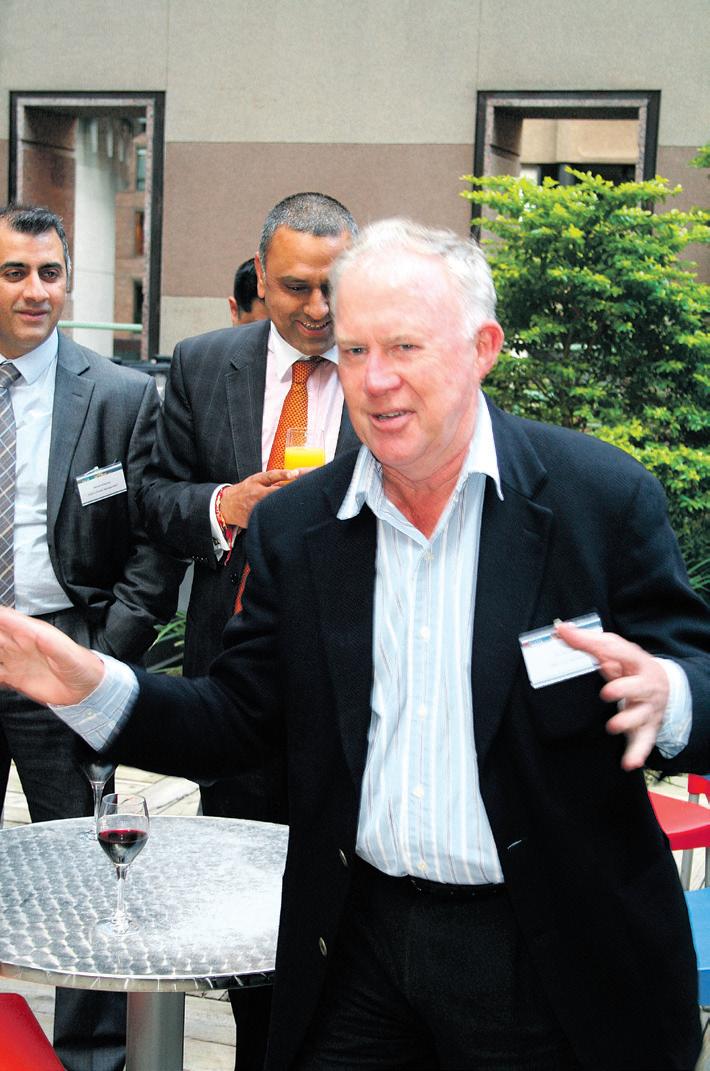
TIE Sydney chapter is connected with global chapters especially in the Silicon Valley and in India and there is constant exchange of information and resources.
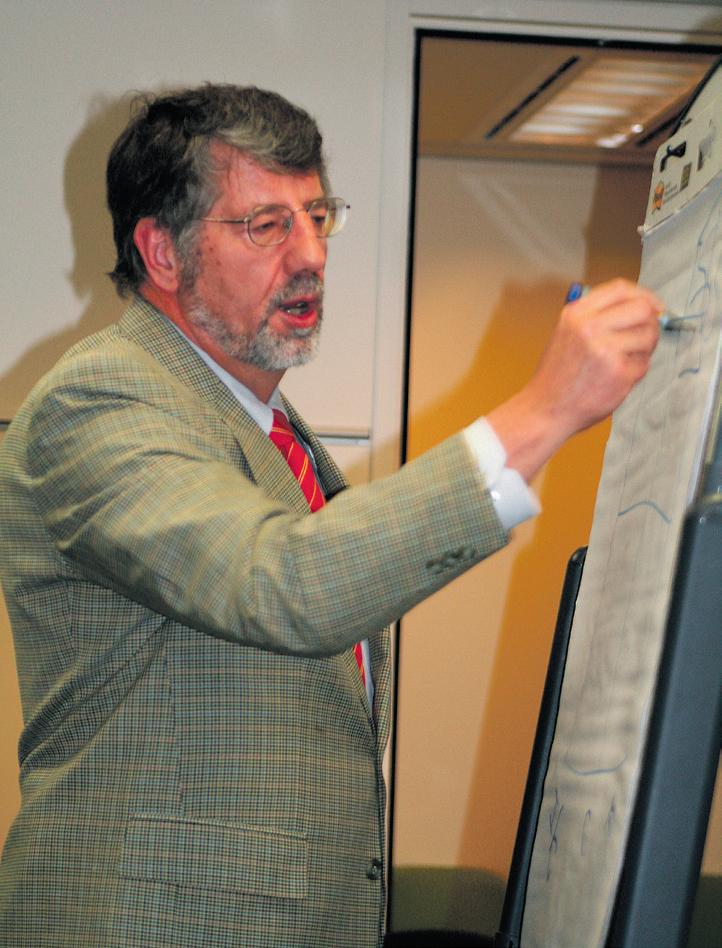
and if they win that competition, they would get the opportunity to attend the TIECON global conference in Silicon Valley. TIE is advancing the cause of enterprise not just among AustralianIndians but the broader community.
TIE Sydney has received a fresh boost with the elevation of Dilip Rao as President. As founder and ex-CEO of the highly successful payments firm, Paymate, and a mentor of entrepreneurs for several years, he has a track record of supporting and mentoring young people in innovation and entrepreneurship.

He was supported by a team comprising Angelica Jacob, Manishi Dave, Julian Day and Suresh. It was no wonder that the conference was packed with 100 delegates far exceeding the organisers’ target of 75.

From top: Keynote panel; Roger La Salle, innovation thought leader; Jim Maxwell, ABC cricket commentator

OCTOBER (2) 2011 <> 35 NATIONAL EDITION FREE LEGAL ADVICE For FREE CONSULTANCY on Family Law, Police charges, Criminal matters, Immigration (MARA 0002497), Compensation and Vehicle Accident Matters. We are proud to announce that on every Saturday to assist the community we provide free legal advice between 10AM -3PM DEHSABZI LAWYERS Level 4, 91 George Street, Parramatta Contact 02 96355566, 0419492478 For expert coaching in Lowest Fee Guaranteed IELTS ENGLISH GURU Suite -1, 71 A Macquarie St, Parramatta, Phone 0411 520 546, 9687 9741 www.englishguru.com.au • Power Packed Sessions. • One and Two Weeks Crash Courses Available. • Money completely refundable, if not satisfied with the first tuition session.
BUSINESS
www.indianlink.com.au
Ghazal loses its soulful king
Ghazal king Jagjit Singh’s way of celebrating his 70th birthday this year, was unique - he wanted to do 70 concerts worldwide by the end of the year. The man who gave ghazals a new lease of life, managed only 46 before breathing his last.
Jagjit Singh rose to fame in the 1970s and 1980s with his lilting voice and refreshing style of rendering ghazals and devotional tracks. He was a Padma Bhushan awardee. His songs, which gave the dying artform of the ghazal a new revival, have become the stuff of legend: Kal chaudhavin ki raat, Honthon se chhoo lo tum, Koi ye kaise bataaye, Chitthi Na Koi Sandesh, Tum itna jo muskura rahe ho, Yeh daulat bhi le lo, yeh shohrat bhi le lo, Tumko dekha toh ye khayal aaya, Jhuki jhuki si nazar, Shaam se aankh mein namin si hai, Badi nazuk hai, Hoshwaalon ko khabar kya and Kiska chehra are all classics.
Born in to a Sikh family in Sri Ganganagar Rajasthan Feb 8, 1941, Singh had four sisters and two brothers and was known as Jeet by his family. He went on to pursue a post graduation in history from the Kurukshetra University in Haryana. He came to the country’s entertainment capital, Mumbai in 1965, in search of work as a singer.
It was a struggle. Singing at small musical gatherings, house concerts and film parties in the hope of being noticed, became almost a daily routine for him. But he didn’t lose hope.
In 1967, he met singer Chitra and following a courtship of two years, they tied the knot. Together they came up with several hit ghazal albums like Ecstasies, A Sound Affair, Passions and Beyond Time and were considered a formidable husband-wife singer duo.
They sang many successful duets until their only son, Vivek, died at the age of 21 in 1990. Chitra never sang after that. However, Singh continued his tryst with music - and for good.
He was the first Indian composer and, together with wife Chitra, the first recording artist in the history of Indian music to use digital multi-track recording -- for the album Beyond Time (1987).
He also sang for Bollywood films like Arth, Saath Saath and Premgeet. He created a strong footing in films with songs like Hontho se chhoo lo tum (Prem Geet), Tumko dekha toh yeh khayal aaya (Saath Saath), Jhuki jhuki si nazar (Arth), Hoshwalon ko (Sarfarosh) and Badi nazuk hai (Jogger’s Park).
Most of his non-film albums - Hope, In Search, Insight, Mirage, Visions, Kahkashan, Love Is Blind, Chirag, Sajda, Marasim, Face To Face, Aaeena and Cry For Cry - were successful too.
He had also collaborated with former Indian prime minister Atal Bihari Vajpayee in two albums, Nayi Disha (1999) and Samvedna (2002).
He also sang in several languages, including Urdu, Punjabi, Gujarati and Nepali. Singh’s career boasted a repertoire comprising 50 albums.
True performer
While many of his ghazals were marked by soulfulness, Jagjit often turned his concerts into entertainers with his humour and by balancing the pathos with pleasant Punjabi numbers like Saun da mahina. The clever mix always satisfied the audience. His heavy voice loved to turn joyful towards the end of his shows, leaving his listeners smiling ear to ear, and sometimes even dancing in the aisles, unusual for ghazal shows!
In his last concert at Sydney in April this year, he was in a playful mood right from the start, though. (Yes Sydney was lucky enough to be among the 46 venues of his 70-concert tour).
“Good evening, Sat Sri Akal, Salaam Aleikum happy birthday!” he began as the audience applauded. And then he began his very first number of the night: “Thukarao ab ki pyaar karo, main sattar ka hoon”, a play on words on the original Main nashey main hoon Disenchanted with
Bollywood
In his later years, Singh became disinterested in Bollywood music due to the ‘moneymindedness’ of film producers. He also voiced his concern over the politicisation of arts and culture in India and the lack of support for practitioners of India’s traditional art forms, particularly folk artists and musicians. But he remained connected to causes relating to the music industry. He was one of the frontrunners battling to get an equal percentage of royalty for singers and lyricists.
The last journey
What he couldn’t battle was his illness.
He was hospitalized on Sept 23 after suffering a brain haemorrhage. A surgery was conducted on him at Mumbai’s Lilavati Hospital the same day, following which he showed slight improvement. However he breathed his last on Oct 10 at 8.00am. He is survived by wife Chitra Singh, who was by his side when the end came.
Singh was cremated at Chandanwadi Crematorium at 4.30pm in south Mumbai on Oct 10. The cremation drew several celebrities, and his extended family from Rajasthan. Jagjit Singh’s brother Kartar Singh, and his grandsons Armaan and Umer Chowdhary conducted his last rites.
Prominent names in the music industry like renowned classical vocalist Pandit Jasraj, lyricist-composer Gulzar, Javed Akthar, actor-politicians Raj Babbar and
Shah Rukh Khan, Raza Murad, singers Roopkumar Rathod, Sonu Nigam, Shaan, Mika, Ila Arun, music composers Kalyanji, Shekhar Ravjiani and filmmakers Yash Chopra, Subhash Ghai, Madhur Bhandarkar attended the funeral with moist-eyes and silent prayers.
Music world mourns the loss of Jagjit Singh
Jagjit Singh’s passing has left a huge void in the music industry, which was enriched with his soul-stirring and lilting melodies. Lata Mangeshkar, who collaborated with Jagjit on many occasions, including on one of his best sold albums Sajda, said, “It is the end of an era. He was one artist who never needed films to get popular. He was an instant hit”.
Her sister Asha Bhosle added, “His soothing voice, his warmhearted nature are all gone now. His ghazals are all we have”.
One of his peers Pankaj Udhas observed, “His style was incomparable. He revolutionised the entire approach of this form of singing and gave a new dimension to non-film music”.
Filmmaker Mahesh Bhatt tweeted: “My film Arth would not have touched the hearts of millions of people without the contribution of Jagjit Singh. Thank you, friend.”
The Prime Minister of India also expressed condolences. “He was blessed with a golden voice. By making ghazals accessible to everyone, he gave joy and pleasure to millions of music lovers in India and abroad,” he said. “I count myself among his admirers and share their sorrow. His music legacy will continue to enchant
Transcending boundaries
The talent of Jagjit Singh crossed cultural and national boundaries. He had a loyal following in Pakistan.
Describing him as the pioneer of the modern ghazal, Pakisatn’s The News International said that Singh “brought the dying tradition alive in India - adding to the traditional repertoire of love songs with more philosophical verses, which touched on many aspects of human life: the brief beauty of childhood, the suffering caused by loss, and the doubts which confront us in life”.
It went on to say, “Much of what he composed and sang carried a strong and exquisite humanism that recognised no differences of caste, creed and religion”.
“His fans ranged from politicians to ordinary people everywhere - primarily in India and Pakistan”.
Recalling that Singh sang before a rapt audience in Lahore a few years back to raise funds for the ailing Mehdi Hasan, it said that his efforts to help the maestro “exceeded those made by most at home”.
“He was an extraordinary philanthropist in other ways too; offering promising young singers the support he himself did not receive in his early days of struggle. Jagjit will be missed not only for his voice - which exists now only on tape and CDs - but also as an extraordinary humanist and thinker who raised music to new heights,” it added

The voice in tracks that won him the tag of Indian Ghazal King, will remain fresh for generations to come.
From IANS reports
36 <> OCTOBER (2) 2011 INDIAN LINK
TRIBUTE www.indianlink.com.au
Jagjit Singh

OCTOBER (2) 2011 <> 37 NATIONAL EDITION
people parties places










Friends prepare for Karva Chauth women’s festival at Singh Food and Spices (Blacktown) with mehendi by Zeenat


First birthday for Ishan Mehrotra (seen here with Mum Nidhi and Dad Sagar)



38 <> OCTOBER (2) 2011 INDIAN LINK THISMONTH www.indianlink.com.au
you have a photo for this page?
Do
All dressed up for the Year Ten formal: Radhika Bhatia (centre) of Abbotsleigh Girls High School with friends (from left) Caitlin, Hugo, Raghav, Keshav and Melany
Neni Tewary celebrates his birthday with friends and family
Newlyweds Akhilesh and Marlena Kamkolkar with American singer Eric Benet who performed at their wedding reception
Photo: Harry Khandu Photography





OCTOBER (2) 2011 <> 39 NATIONAL EDITION $1100*
Culture, values and fun
for Divinity (GOD), with the aim of instilling positive values in young minds and giving them an insight into different cultures, while reinforcing the importance of respect. The camp’s ‘Cultures of the World’ theme further emphasised GOD’s aim of universal brotherhood.
The camp was initiated with a short prayer, signifying that all auspicious events begin with prayer. The children then dove straight into the first session titled ‘Cultures’, led by Lakshmi Sekhar and Saroja Narayanan, in which the idea of cultures and multiculturalism was introduced. The focus was on specifically learning about the Japanese culture. Hands shot up as children, bubbling with excitement, showed off their knowledge on Japan, amazing those adults present with their knowledge. The general consensus was that they didn’t need to be taught anything! The importance of respect and not discriminating was brought up by a child who, to the delight of the adults, summed up the essence of the camp.
To further emphasise the importance of identity, the Indian and Australian anthems were taught to the children, which they sang
an activity which they thoroughly enjoyed, specially decorating and placing their pictures within the frame. They displayed their creations with an air of pride on the art table.
Cricket being intrinsic to the fanatic nature of Indian culture and the sportiness of Australians, was well received by all.
Aditya Ramakrishnan of Emerging Blues U15, Gajan and Varun taught the children a few essential cricket skills such as fielding, catching, bowling, batting and throwing at the stumps. Fun cricket games were participated in with enthusiasm.
A fun-filled magic show followed the cricket session, with Ruby Star from Yabadoo Kids’ Parties filling the hall with bright smiles and laughs. She provided lots of entertainment, blowing up balloon toys for the children, sparking wild sword fights with the boys and playful puppy play time with the girls. The children thanked her at the end of the session, and all posed for a keepsake photo to treasure.
The first day ended with dandiya and hip-hop lessons, much to the delight of the children. Shonie Kaushik taught
Small Jewellery Business for Sale

Day two brought on a wave of excitement as the children were introduced to a host of stimulating activities that would teach them about different cultures of the world. After the prayers, they participated in a Tai Chi session led by Virginia Akrap, an instructor from the Australian Academy of Tai Chi, who introduced the group to the various facets of the activity. Tai Chi, an important part of traditional Chinese culture, is a practice which helps develop combat skills while improving concentration and overall well-being. Virginia demonstrated some simple movements, followed by the children.
To consolidate their understanding of the Chinese culture, the children learnt about the Chinese celebration: Moon Festival. A powerpoint presentation on the festival covered its significance and mode of celebtation. Maria Xu, a teacher at Berala Public School, then patiently answered the wide array of questions about China and the Moon Festival.
In the next activity, the children were divided into two groups. The older students learned how to make and decorate Chinese
beautiful flowers on paper. The children were soon attempting their own designs with success.
The children then prepared for a presentation to their parents, highlighting the activities of the camp in which they had participated. Mr Stafford Watts, former senior Commissioner of Land & Environment Court, attended as Chief Guest. The final presentation was an amazing one with the reflections of each activity well presented. Parents collected their happy children with wide smiles of contentment, listening to eager stories about their experiences.
GOD’s Spring 2011 Camp was a success as it taught children the right values in a fun, encouraging way. Urged by supporting parents and adults, they learnt the value of respecting other cultures, and by constantly connecting to their own familiar Indian culture, they learnt about the world and that love and respect is needed to achieve universal brotherhood.

An excellent way to spend two days, I say!
Smriti Sekhar
LO OKING FOR A NEW CAREER? OR WANT TO CHANGE YOUR CURRENT FAMILY DAY CARE SERVICE PROVIDER? DO YOU...
Have an interest in car ing for and educating children? Have a safe, secure and friendly home environment? Want to be your own boss? Have the desire to work your own hours?
Want great bene ts such as:
• Job satisfaction;
• 1:1 Support & Advice;
• Excess Income.
If you answered YES & have or want to
Please call on 0431 523 675
attain a quali cation in Early Childhood Development such as a Certi cate III in Children’s Ser vices, then we have an opportunity for you at our Family Day Care Ser vice
Aussom Coordination Unit is based in Auburn NSW and has early childhood educators located in many areas of Sydney.....we are looking for enthusiastic individuals intereste d in the above
For further information please contact: Aussom Family Day Care NSW 1300 164 794 or 0435 894 490 Monday to Friday 9-5pm

40 <> OCTOBER (2) 2011 INDIAN LINK
Very Unique Jewellery
First to be introduced in Australia
Supported with a very good website
Selling due to sudden health problems
Urgent sale
Price
º
º
º
º
º
Asking
- $17,000 including stock
COMMUNITYSCENE
www.indianlink.com.au
Wishing you and all your family members a very Happy, prosperous and safe Diwali



OCTOBER (2) 2011 <> 41 NATIONAL EDITION

42 <> OCTOBER (2) 2011 INDIAN LINK

OCTOBER (2) 2011 <> 43 NATIONAL EDITION





44 <> OCTOBER (2) 2011 INDIAN LINK
India, Brazil, South Africa push for Security Council expansion
India, Brazil and South Africa, all of whom are now non-permanent members of the UN Security Council, underscored again the urgent need to reform the system and add more members to the high table with increased participation of emerging economies. In a joint communique after IBSA Summit level talks among Prime Minister Manmohan Singh, Brazilian President Dilma President Dilma Rousseff and their host South African President Jacob Zuma, the three leaders said the Security Council expansion must be of both permanent and non-permanent categories.
In the communique, officially called the Tshwane Declaration, the three sides also discussed what is called the G4 initiative for UN reforms among India, Brazil, Germany and Japan for mutual support of their candidature as permanent members of the Security Council.
“The initiative has been supported by a wide coalition of member states from all regional groups of the UN. Therefore, they expressed the view that such strong support should be considered as the basis
for further discussion in the ongoing intergovernmental negotiations on the UNSC reform,” the communique said.
The need for greater progress in the negotiations was identified as critical to ensure the required impetus to change and the three sides committed themselves to close cooperation and coordination at the current General Assembly.
Earlier this month, India, Brazil and South Africa - together members of the Security Council for the first time since the trilateral forum was formed in 2003 - abstained on a vote against the Syrian regime proposed by some members, notably the US.
T his had led to the first ever walk-out by the US at the high table of the council, which in diplomatic circles was seen as a victory of sorts for developing countries in general, and IBSA in particular.
India, Brazil, South Africa seek way out of economic crisis
India, Brazil and South Africa recently sought credible action from Western countries for a way out of the sovereign debt crisis in Europe and the overall global
downturn and said emerging economies can no longer remain mute spectators on such subjects.
The leadership of the three countries, which met in Pretoria for the trilateral IBSA Dialogue Forum, also decided to coordinate their efforts ahead of the crucial G20 meeting at Cannes, to prevent the situation from deteriorating further.

“We hope early steps will be taken by Europe and other advanced economies to calm the capital and financial markets, and prevent the global economy from slipping into a double-dip recession,” Prime Minister Manmohan Singh told the opening plenary.
Brazilian President Dilma Rousseff and summit host South African President Jacob Zuma also called on world leaders to take immediate steps since it was having a knock-down effect on emerging economies. Their positions were also reflected in a joint declaration.
“We need a credible agreement to prevent the crisis from getting out of control,” said Rousseff, who later gave a statement before the media jointly with Manmohan Singh and Zuma, who also sought to link the crisis with the overall threat to food and energy
security.
“The economic crisis is accompanied by a crisis in our mode of consumption and use of energy resources as well as food shortages. We face increasing incidents of poverty and inequality in the world, while some parts of the globe face hunger and disasters,” Zuma said.
“IBSA countries individually and collectively can make a contribution in helping the international community surmount these challenges. I wish to reflect on the essence of what IBSA portrayswhich we describe as ‘Back to Basics’ when democracy and development work together for a better life.”
According to Manmohan Singh, the debt crisis and the slowdown were also sending negative signals to the global markets, which were exhibiting acute signs of distress and that developing countries like India, Brazil and South Africa could not remain immune and untouched.
“We should coordinate our positions in the run up to the G20 Summit in France to ensure that the priorities of the developing economies are adequately reflected in the deliberations of G20,” the prime minister
Continued on page 46

OCTOBER (2) 2011 <> 45 NATIONAL EDITION
Photo: AP
Brazilian President Dilma Rousseff, South African President Jacob Zuma and Indian Prime Minister Manmohan Singh join hands in a symbol of solidarity at the end of the fifth India-Brazil-South Africa (IBSA) Summit in Pretoria, South Africa, 18 October 2011.
Continued from page 45 said, adding India will be happy to host the next IBSA Summit.
India hopes it can import uranium from South Africa
India hopes it can import uranium from South Africa by impressing upon Pretoria to favourably change its regime towards New Delhi, notwithstanding the implications of what is called the Treaty of Pelindaba.
Speaking to journalists on the margins of the India-Brazil-South Africa (IBSA) Summit, India’s envoy in Pretoria Virendra Gupta said while South Africa has uranium deposits, India has now started talks on importing the fuel.
“It appears to us that there will need to be an exception,” Gupta said, referring to the African Nuclear Weapon Free Zone Treaty that prohibits signatories from entering into nuclear commerce with any nation that has not signed the Nuclear NonProliferation Treaty.
“But it will not be difficult. We have civil nuclear agreements with several countries. I don’t see any reason why we can’t do it here,” Gupta said referring to such bilateral pacts with about a dozen regimes.
He was speaking soon after Prime Minister Manmohan Singh concluded his engagements with Brazilian President Dilma Rousseff and South African President Jacob Zuma both at the summit level and his subsequent bilateral meetings.
Significantly, the joint declaration signed by the three leaders appeared to acknowledge India as a responsible state on nuclear matters, despite its reluctance to officially join the non-proliferation regime.
“The leaders reaffirmed their commitment to the goal of the complete elimination of all nuclear weapons within a specified timeframe, in a comprehensive, universal, non-discriminatory, verifiable and irreversible manner,” the declaration said.
“Brazil and South Africa welcomed India’s engagement with, and interest in, participation in the relevant international multilateral export control regimes and utilization of their guidelines.”
100,000 community foresters to help green India
India will engage 100,000 educated youths to execute an ambitious Green India Mission (GIM) which seeks to increase the country’s forest cover to 33 percent from 20 percent within 10 years, says a top forest official.
P.J. Dilip Kumar, director general of India’s forest department, says that in order to cope with climate change threats, the central and state governments have decided to raise new forest cover on five million hectares under the GIM.
“India has to increase its present forest cover area of 20 percent (out of the total geographical area) to 33 percent within the next 10 years,” Kumar told IANS in an interview in Agartala.
“To facilitate planning, execution and monitoring of the GIM at the village level, one lakh cadre of community foresters (CCF) would be employed from among educated community youths,” he said.
The Rs.46,000 crore ($9 billion) plan is one of the eight missions under the National Action Plan on Climate Change announced by the prime minister in June 2008.
The GIM document was prepared in June last year and the countrywide consultation is now on.
With 2011-12 being the preparatory year, GIM would be implemented by the Twelfth and Thirteenth Five Year Plans (2012-13 to 2016-2017 and 2017-18 to 2021-22).
“In view of the massive urbanisation and construction of houses and infrastructure, parks, grasslands, wetlands and open spaces across India would be in danger. Under the GIM, these areas would be protected,” said
Kumar. “Tough laws have to be enacted for everlasting protection of the open spaces.”
According to the official, all parks, grasslands, wetlands and open spaces will be permanently demarcated and, in suitable cases, will be fenced by walls.
Kumar, who is also special secretary of the union forest and environment ministry, conducted a regional workshop on GIM in Agartala recently. Top forest officials of West Bengal and eight northeastern states took part in the day-long brainstorming session.
Before Agartala, such workshops were held in Bangalore, Jabalpur and Jaipur.
“One lakh Joint Forest Management (JFM) committees, thousands of self-help groups, gram panchayats and people’s committees would be involved in the mission,” he said.
Quoting the latest Forest Survey of India (FSI) report, released in 2009, the official said during 1997-2007, three million hectares of land had come under new forest cover across the country.
GIM also targets improvement of forestbased livelihood for about three million households living in and around forests.
“The mission is the first of its kind in India as it is aimed at the socio-economic development of tribals and other backward people and the protection of natural resources through the development of a participatory management of natural resources,” he said.
According to the GIM document, on account of management of shifting cultivation areas under different agrisystems, the area under age-old ‘jhum’ or shifting cultivation had come down from 1.87 million hectares in 2003 to 1.2 million hectares in 2005-06.
Tribals in the hilly terrain of northeast and other areas have for generations been carrying out the traditional slash-and-burn method of cultivation, which has resulted in degradation of forest land and badly affected soil quality.
“The mission will support fallow management within the overall framework of socio-culturally valued, fast growing species managed by the communities,” Kumar added.
GIM aims at enhancing carbon sinks in sustainably managed forests and other ecosystems, adaptation of vulnerable species and eco-systems to the changing climate and adaptation of forest-dependent locals in the face of climate variability.
“Satellite-based remote sensing and geo-imagery system would also be used for monitoring of GIM progress and implementation,” he added.
China ups pressure over India’s Vietnam oil deal
Stepping up pressure on India to scrap oil deals with Vietnam, China has indicated that these agreements in South China Sea could potentially strain bilateral ties.
Liu Weimin, a spokesman for China’s foreign ministry, recently reiterated in Beijing that China has “indisputable sovereignty” over the South China Sea.
In a veiled warning to India, Liu said that New Delhi and Hanoi should “instead take positive steps to ensure peace and stability in the South China Sea”, a thorny issue that is set to shadow bilateral ties and will be discussed in the forthcoming boundary talks.
New Delhi is not ready to be intimidated by what some here see as Chinese bullying.
India has defended the deal ONGC Videsh Ltd (OVL) signed for oil exploration with PetroVietnam in South China sea during the recent visit of Vietnam President Truong Tan Sang to India, saying the drilling was meant to be in Vietnamese waters.
Well-placed sources said the project was important for India’s energy ecurity and it was doing nothing violative of international law.
But this hasn’t stopped threatening statements from the state-controlled Chinese media, asking New Delhi to stay away from troubled waters.
Is there a Chinese strategy?
Well-placed sources said Beijing’s maximalist plan was to force India to dump the oil project as China wants to control South China Sea, a disputed sea over which it claims full sovereignty.
Last year, the Chinese drove out British Petroleum from drilling in South China Sea. But Beijing does not have an issue with companies which venture into South China Sea with Chinese blessing like Husky Energy of Canada.
“It’s coercive diplomacy. They want to drive out OVL. But it does not like they will succeed,” Srikanth Kondapally, a China expert at New Delhi’s Jawaharlal Nehru University, said recently.
“If the Chinese Navy attack ONGC facility, it could spark a war. I don’t think China will physically evict OVL. They will continue the pressure,” he said.
“One can expect Beijing to continue this war of words,” said Kondapalli.

The issue of oil deal will figure in talks between special representatives of the two countries who meet here for the 15th round of boundary talks in a few weeks’ time, said informed sources.
For now, the Chinese media is leading the charge to pressure India to back out of the deal it feels has a larger strategic design behind it.
“Both countries (India and Vietnam) clearly know what this means for China. China may consider taking actions to show its stance and prevent more reckless attempts in confronting China,” state-run English language Global Times said in a commentary.
It said India was willing to fish in the troubled waters of South China Sea so as to “accumulate bargaining chips on other issues with China”.
China needs to respond with “firm retaliatory measures”, it said.
A Chinese trade magazine, published by the Communist party mouthpiece the People’s Daily, warned that India was risking its energy security by going ahead with the oil deals.
“Challenging the core interests of a large, rising country for unknown oil at the bottom of the sea will not only lead to a crushing defeat for the Indian oil company, but will also most likely seriously harm India’s whole energy security and interrupt its economic development,” said China Energy News.
Entire
F1 fraternity is agog about Indian Grand Prix: Karthikeyan
India’s pioneering Formula One driver Narain Karthikeyan is not the only one excited about his inaugural home Grand Prix in two weeks’ time. The entire paddock, he says, is looking forward to the unexplored destination.
The build-up to arguably India’s biggest global event of the year has been on the right track. McLaren’s Lewis Hamilton showed what an F1 car can do by performing breathtaking stunts in Bangalore in September, and Daniel Ricciardo followed to enthrall the fans in the national capital in a Red Bull machine two weeks ago.
Karthikeyan, the lone Indian driver certain to take part in the Oct 28-30 event, says the entire F1 fraternity, including his Hispania Racing Team (HRT), is thrilled about visiting India.
46 <> OCTOBER (2) 2011 INDIAN LINK
Photo: AP
Indian artist Shaikh Salimbhai with a replica of the Taj Mahal he made from matchsticks. The 26-year-old Ahmedabad artist used 75,000 matchsticks to create the piece, which took him a year and 19 days to complete.
“Everyone in the paddock is extremely excited at the prospect of coming to India. For quite a few it will be their first visit. For many drivers it will be their first venture for a competition and they, too, are keyed up. My HRT teammate Ricciardo was overwhelmed by the amount of excitement and the kind of response his road show got,” said Karthikeyan in an interview.
There is already talk that the Buddh International Circuit (BIC) is one of the fastest F1 tracks. The undulations on parts of the 5.14 km track create blind corners and increased width on three of the 16 turns should see plenty of overtaking manoeuvres by the drivers.
Karthikeyan says the 12 teams have a fair idea of the track, even though they have not been there physically.
“Technically, most teams have the track on their simulators, so the drivers will pretty much know what they are up against even if they have not seen the track.”
Karthikeyan’s own preparation for the historic race has been far from ideal. The Coimbatore-based driver has had only a handful of opportunities in the F1 cockpit since the European Grand Prix in June when he was abruptly replaced by Ricciardo in the drivers’ line-up.
Since then, Karthikeyan has driven in practice sessions in Germany, Singapore, Japan and most recently South Korea where he drove in wet conditions, a situation he is unlikely to experience in the Indian Grand Prix.
“Any driver will take as much track time as you give him simply because every outing helps. The practice sessions give me very little time to see and experience the evolution of the car, track and the setup over the weekend, but limited running is better than no seat time,” he says.
The Backmarker Hispania team has made significant improvements in the car since it
was bought by a Spanish investment firm in July.
Karthikeyan is realistic about his chances.
“Our car has improved, but then the competition is not static. The reliability of F1 cars is so high nowadays that you seldom see non-finishes because of technical faults. Having said that, you still need to cross the chequered flag, so keep fingers crossed. We will hopefully be able to come up with our best result,” says Karthikeyan, whose best finish has been 17th in Monaco and Canada.
The 34-year-old is thrilled about F1 coming to India and says it would surely promote motorsports in the country.

“Grassroot motorsport has existed in India for long, but the problem has been that the progression ladder is taking a long time coming. Sometimes you need a big bang to shake up things, and hopefully this race will do just that -- showcasing what the sport is at the highest level.
“The other way of promoting the sport is to take karting to every nook and corner of the country. Most metros and Tier II cities now have commercial karting tracks and more youngsters need to be encouraged to drive -- at leisure first and competitively thereafter. Probably things like screening F1 races during karting competitions would help forge a connect between grassroot and top level racing.”
As for his own future beyond F1, he doesn’t want to think about it right now; his concentration is only on the Greater Noida race.
“My focus right now is solely on the Indian GP. I would like to stay in F1 but I am not preoccupied with those thoughts; there are a whole lot of other factors that will play a part in deciding my future. Once we have the Indian GP out of the way, thinking about the future will be much easier.”
India signs Rs.300-cr deal for interceptor boats
In a bid to plug gaps in its coastal security, India has signed a Rs.300 crore deal for importing 80 fast interceptor craft (FIC) for its navy’s specialised infantry force from a Sri Lankan shipyard.
The contract was signed in the last week of September and it envisages delivery of the 80 boats by 2014, a naval officer said in New Delhi recently.
The fleet of FICs will enable the newlyraised 1,000-man Sagar Prahari Bal (SPB) to plug gaps in patrol and interception operations that were identified following the November 2008 Mumbai terror attack, the officer said.
Sri Lankan shipyard Solas Marine was chosen for the order in June. The induction of the 80 boats will take place over 36 months from now, the officer said.
“The navy will carry out shallow water operations by day and night for seaward anti-terrorist patrols for security for naval assets, besides interception at high speeds and perform search and rescue operations,” he added.
The 80 FICs will be in addition to the 15 boats that India had ordered from French firm Chantiere Navale Couach at a cost of Rs.65 crore in March last year. The 15 boats are now in the process of delivery and the order is expected to be completed by 2012. But these 15 boats are not meant for the SPB.
The fast interceptor boats have a maximum speed of 50 nautical miles per hour and would be used by the navy to intercept suspicious boats along the coast for inspection and verification. They will also be used for preventing crimes such as poaching and smuggling, apart from counter-terror operations.
India is also getting 300 fast attack craft
for its navy, coast guard and marine police to strengthen their capabilities, a decision taken in the backdrop of the 26/11 terror
The SPB, raised in 2010, has 98 officers and 902 sailors. They presently operate in
$750,000 for Indian elephants
A collection of African gemstone jewellery fetched $750,000 at an auction in Mumbai by Sotheby’s, part of a fundraising initiative for conservation of Indian elephants.
India is home to about 27,000 wild elephants, which is more than half the Asian elephant population. But experts say they are endangered today due to the shrinking of habitat and man-animal
The results from the auction were announced recently. The gemstones were donated by the Britain-listed Gemfields company, a leading producer of gemstones
The precious stones, produced in Zambia, were brought to the country to be made into jewellery by 10 selected Indian
“We started working on this project from February onwards wherein we tied up with 10 jewellers across nine Indian cities, as well as contemporary sculpture artist Arzan Khambatta,” said Rupak Sen, the company’s
“The basic objective was to raise awareness for Asian elephants and also crucial funds to protect the elephant
The corridors are a conduit for elephants to move between viable habitats that helps facilitate their genetic viability and larger
The Mumbai auction was a follow up of another fundraising event for elephants held in London last year organised by the NGO World Land Trust. Gemfields also participated.
Some 200 life-sized elephant models made up of material such as metal, paper, clay and wood by reputable designers were exhibited across the city. They were later auctioned.
“Since we are a gems mining company we thought we could also probably help this cause. So we got seven of best jewellery designers to make seven pieces of jewellery using our emeralds.
“These pieces were displayed in highend stores in London and then auctioned off. We were able to raise close to 700,000 pounds in less than half an hour,” said Sen. “India is a very important market for us. About 90 percent of our productions are bought by customers based in Jaipur, one of the biggest hubs for emerald cutting and polishing.
“Therefore, we wanted to do something as part of our corporate social responsibility,” Sen said in a telephone interview.
Bollywood actress Madhuri Dixit had joined the initiative in July as its brand ambassador to lend support to the cause.
Earlier, a nationwide survey by the NGO Wildlife Trust of India (WTI) had identified 88 corridors that needed protection. After which, WTI in partnership with the World Land Trust (WLT) have secured a number of corridors in Uttarakhand, Kerala and Meghalaya.
Securing of corridors involves working closely with the local communities and governments, which renders the entire process time and resource-intensive.
Gemfields has pledged to support the World Land Trust and WTI’s corridor projects in India.
OCTOBER (2) 2011 <> 47 NATIONAL EDITION
IANS Photo: AP
David Gleeson of Australia wins the Hero Indian Open golf tournament in New Delhi on October 16, 2011.































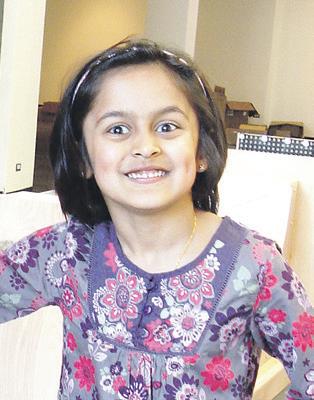

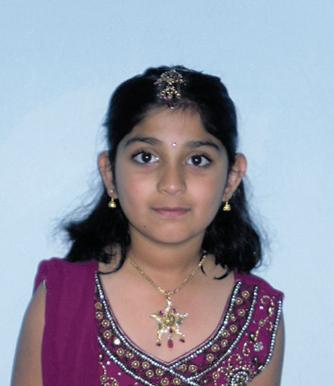





48 <> OCTOBER (2) 2011 INDIAN LINK
HIGHLY COMMENDED HIGHLY












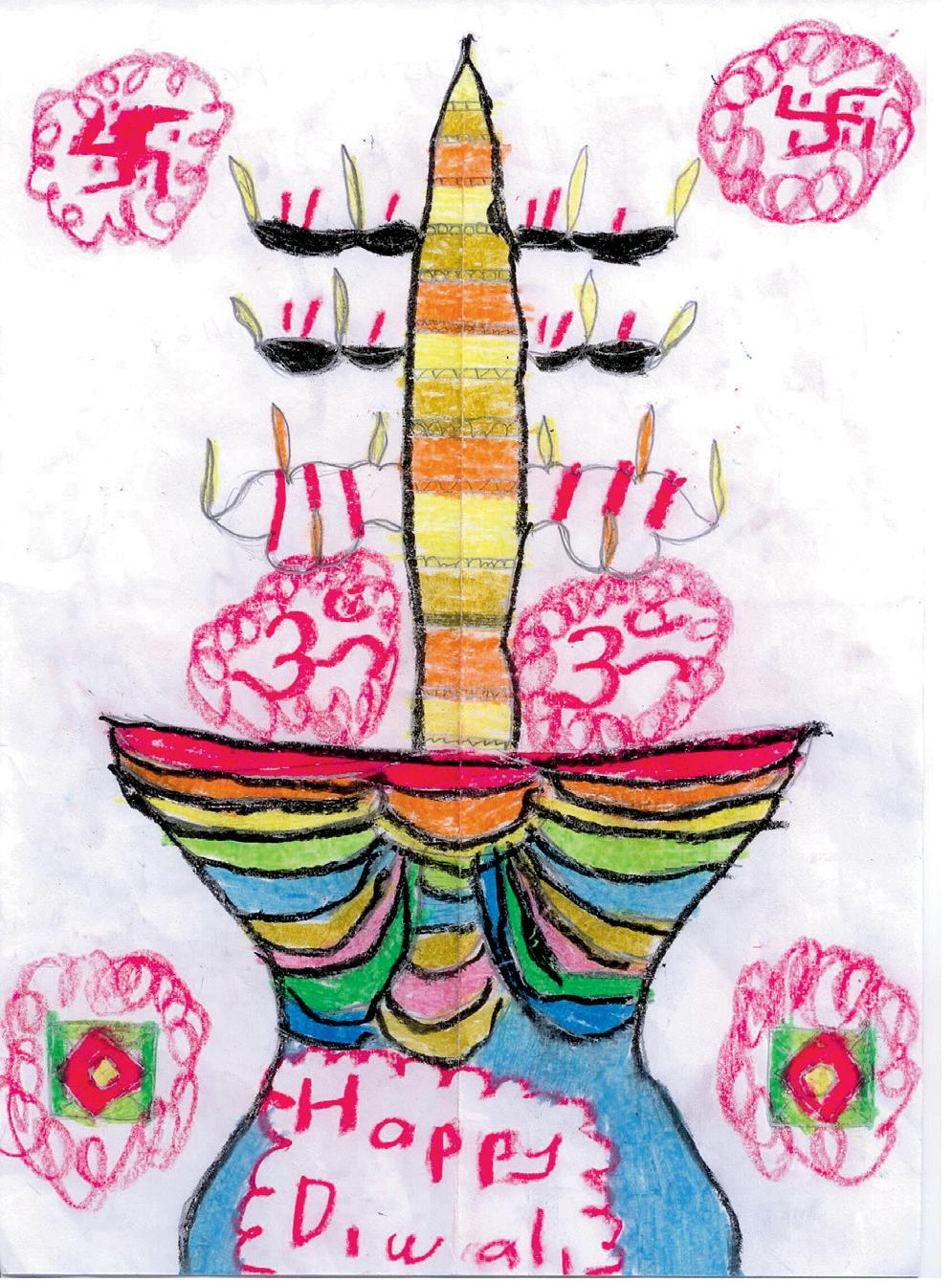








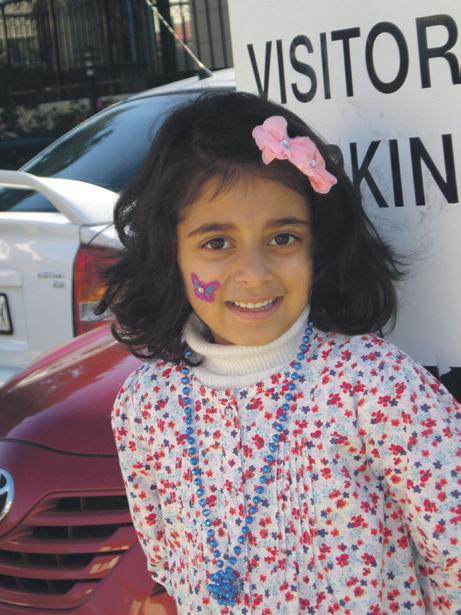


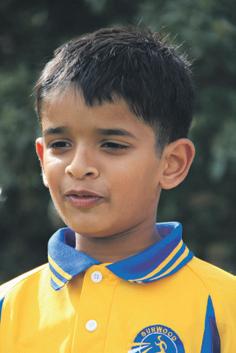











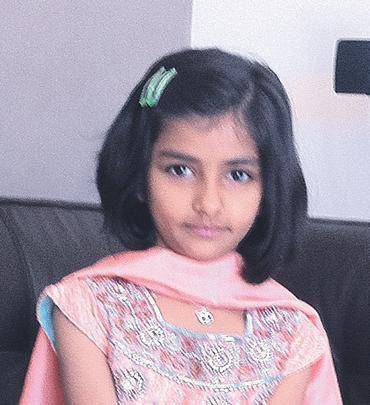









OCTOBER (2) 2011 <> 49 NATIONAL EDITION Winner Y COMMENDED





50 <> OCTOBER (2) 2011 INDIAN LINK Send money to mobile phone in minutes FOREIGN EXCHANGE NO COMMISSION ON CURRENCY EXCHANGE SERVICES: > Send and Receive money to any Bank Account in the WORLD. > Send and Receive cash around the WORLD within minutes at very LOW Fee. > Foreign Currency Exchange at best rates WITHOUT any Commission. > Business Telegraphic Transfer at competitive rates and fixed fee of $15.00 only BRANCHES: AUSTRALIA Parramatta – Shop 2105, level 2, Westfield Shoppingtown, Parramatta NSW 2150, Ph: 02 9806 0955 Blacktown – Shop 3013, Level 3, Westpoint Shopping Centre, Blacktown NSW 2148, Ph: 02 9831 8033 Hurstville – Shop 5a, Level 2, Westfield Shopping Centre, Hurstville NSW 2220, Ph: 02 9585 2881 Darling Harbour – Kiosk 1, Darling Park Monorail Station, Darling harbour, NSW 2000, Ph: 02 9267 8142 Brisbane City – Shop 36a, ANZAC Square, 198 Adelaide St, Brisbane QLD 4000, Ph: 07 3220 2881 FIJI Suva – 679 331 7755 NEW ZEALAND Head office – 09 369 1723 lotusfx@bigpond.com www.lotusfx.com 1300 979 966 HAPPY DIWALI
The Greek impasse
BY NOEL G DE SOUZA
The eyes of the world are focussed on Greece because the world’s current economic crisis is largely, but not exclusively, dependent on resolving the Greek budgetary woes. Greece was allowed to get away for too long with an undisciplined spending spree.
A bloated public sector, generous pensions, a high social welfare budget and tax concessions for the wealthy preyed on the public purse. This extravagance was supported with increasing borrowings from its well-todo Eurozone partners. Other Western economies also have extensive, and often much higher borrowings, such as the US.
Greece has a strong sentimental value in Europe. It has been considered as the mother of European civilisation as well as the originator of democracy with good reason, although it is to Britain that we owe the parliamentary system in vogue. But Greece is more than European. It is the bridge between Europe and the lands to the East upto north-west India. The Greek Empire of Alexander the Great spread eastwards through Persia, to the east of the Indus river.
Historically, Greece has had a strong Indian connection. The Greeks established the kingdom of Bactria which encompassed parts of Afghanistan, Pakistan and India, east of the Indus river. The most famous Indo-Greek King was Menander (known in India as Milinda) who encouraged the development of Mahayana Buddhism.
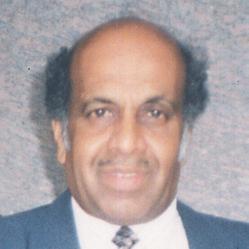
Greek influence is evident in the statues of the Buddha of that period which have halos around the head.
The Questions of Milinda is a famous Buddhist text. Milinda was involved in local battles in northern India. He had tried to conquer Pataliputra, present day Patna.
For many centuries, Greece and India became remote from each other politically and economically. There were visits, though, from King Paul of Greece and other members of the Greek royal family.
from the Ottoman Empire only in the nineteenth century. During World War I, there was heavy fighting between Greeks and Turks, with heavy loss of life. A transfer of a large number of Greeks from Turkish territory eventuated. Greek-Turkish rivalry continues to this day and is seen at its worst in the ongoing division of the island of Cyprus. For some time Greece opposed Turkey’s entrance into the European Union, though it no longer insists on this opposition.
Modern Greece has had a turbulent history. Initially, its war of independence from the Ottoman Empire was followed by a shortlived republic. At that time, the important European powers installed a Bavarian prince as its monarch. However, he proved to be dictatorial and had to be replaced by a Danish prince as the king. The monarchy was ultimately ended in 1975 in Greece, following a referendum.
For the Greeks, German intervention in their affairs is nothing new. As noted, soon after gaining its independence, a Germanic king was imposed on them. During both the World Wars, Germany invaded Greece with very unhappy consequences, including over a million deaths by starvation. This time, the German intervention is economic and hopefully will help Greece put its economic house in order. The European Union, made up of twenty-seven nations has no uniformity. The more developed western members of the Union tend to consider southern and eastern Europe as being economically peripheral. It is the southern countries (“PIGS” – Portugal, Italy, Greece and Spain) which are now causing economic headaches, both for the Eurozone and for the entire European Union. The Eurozone covers only seventeen members of the European Union.
It is the southern countries (“PIGS” – Portugal, Italy, Greece and Spain) which are now causing economic headaches, both for the Eurozone and for the entire European Union.
Queen Frederica developed an interest in Indian philosophy and became an exponent of Shankara’s Advaita philosophy. The Greek Orthodox Church maintains ties with the Christian Orthodox Churches of Kerala.
Current-day Greece is a small nation. Covering about 132,000 square km, it has 11.3 million people. In contrast, Italy has an area of 301,000 square km and has a population of about 57 million.
Greeks know about external interference in their affairs. Greece attained its independence
Britain has retained its own currency, but is now being called upon to help solve the Eurozone crisis. The European Union has suggested that a financial transaction tax be levied throughout the Union so as to create a contingency fund to help European nations in need. This tax would adversely affect Britain, as London is the financial hub of Europe. Unsurprisingly, there is opposition in Britain for such a tax as the Eurozone crisis was not of its making. Besides, Britain has helped Iceland to recover from its financial crisis and is also lending a hand to Ireland in its hour of need.
China has offered to help Europe, but has made it clear that European nations need to first put their own houses in order. India has been attending Group-of-Twenty meetings and there are vague hints that India might also help, but currently the world is watching what steps the Europeans are taking to solve their own problems.

OCTOBER (2) 2011 <> 51 NATIONAL EDITION
Although Indo-Grecian ties go back many centuries, there is a possibility that the relationship could be revived in the near future
OPINION
It has been considered as the mother of European civilisation as well as the originator of democracy with good reason, although it is to Britain that we owe the parliamentary system in vogue.
www.indianlink.com.au
BY RITAM MITRA
iPhone. iPad. iPod. iMac. They are terms synonymous with innovation, products reflective of brilliance in engineering, yet simplicity in design. They have reshaped the way we communicate, entertain and work. They have, quite simply, changed the world in just a few years. The one main man behind the revolution, Steve Paul Jobs, was far more than just a CEO, an inventor or an entrepreneur. A more complete visionary of his type will not be seen in this generation; already there are comparisons between the turtleneck-clad Apple co-founder and Henry Ford and Thomas Edison. Quite simply, Steve Jobs alone was Steve Jobs. Jobs, who passed away on October 5 at the age of 56, is credited with the incredible rise of Apple Inc., originally offered to the public at $22 a share. The current share price sits at around $400, and the company itself is valued at over $350 billion, making it the largest technology company in the world by both revenue and profit. It is a far cry from the company that found itself close to bankruptcy and “within hours of acquisition” in the mid-1990s – a period during which Jobs was not associated with the company. And it all started through meetings between co-founders Jobs, Steve Wozniak and Ronald Wayne amongst others in the garage of a California home in 1975, with the trio founding Apple Computers Inc. in 1976.
Jobs was born to Syrian and SwissGerman ancestry – and put up for adoption almost immediately. He dropped out of university after just a single semester, although he typically enjoyed auditing classes, while sleeping on the floor of his friends’ bedrooms and returning Coke bottles in order to pay for food. He would attend the local Hare Krishna temple for a weekly meal; Jobs visited India in 1974 and although he did not enjoy the experience,
iSad

having picked up lice and dysentery, it remained an important trip for an ambitious man in his teenage years. Jobs returned from India a Buddhist.
Apple was established on April 1, 1976, with the Apple I – a personal computer kit. It was purely a motherboard, featuring CPU, RAM, and basic textual-video chips. It sold for $666.66, which is roughly $2572 in today’s money, adjusted for inflation. A few years later, after a number of successful and failed ventures, Apple introduced the first Macintosh, an iconic moment of 1984. Although it initially sold well, it had a prohibitive price and follow-up sales suffered as a result. However, the foundations had been laid – the Mac’s advanced graphic capabilities led it to being a must-have in the desktop publishing sector.
In 1983, Apple signed a new CEO, John Sculley. His subsequent power struggle with Steve Jobs remains a turning point in the company’s history. Jobs resigned in 1985 after being removed of his managerial duties, and went on to found NeXT Inc. – a computer company that specialised in manufacturing a series of workstations aimed towards the business and higher education markets. In 1986, Jobs bought The Graphics Group, later renamed Pixar, for $10 million. The Disney-Pixar partnership went on to produce films such as Toy Story (in which Jobs was credited as an executive producer), Finding Nemo, A Bug’s Life and the more recent hits Up and Toy Story 3

Apple offered to purchase NeXT from Jobs for $429 million in 1996, bringing Jobs back to the company he founded. Jobs was interim CEO for 3 years until he was announced as the permanent CEO in 2000. In typical Jobs fashion, at the time, he quipped that he would use the job title “iCEO”.
The rest is history. Apple’s first iMac sold almost 800,000 units in the first five months. Apple, along with Jobs, who designed the first personal notebooks amongst other inventions such as the
mouse, was finally being rewarded for their innovative ways and enjoyed a return to profitability in the early 2000s. Their ability to churn out technological innovations in the last decade is unmatched – the iPod in 2001, selling over 100 million units within 6 years; the iTunes store in 2003, paving the way for over 5 billion media downloads in 5 years; the MacBook, Mac Pro and MacBook Pro in 2006, and more recently the iPhone, iPod Touch and iPad. Jobs wasn’t, of course, the only mind behind these projects – but he was definitely at the forefront. Jobs holds 317 patents – including portable laptops, the graphical user interface of several products, and even the staircases iconic of Apple retail stores. His genius is without a doubt the reason Apple is what it is today, but it is easy to forget that he has not just reshaped Apple –Jobs’ contribution was to the world.
It is near impossible to conceive one man solely changing the way the world works in such a short period of time. It is even harder then, to completely comprehend the enormity of what Steve Jobs has done
while battling cancer for the last 7 years of his life. It is no wonder that Apple stocks fell 5% when Jobs resigned from his post as CEO in August this year. Speculation about his health has continued ever since he announced the pancreatic cancer in 2004, but Jobs remained typically unconcerned – in his now-famous commencement speech at Stanford in 2005, “For the past 33 years, I have looked in the mirror every morning and asked myself: ‘If today were the last day of my life, would I want to do what I am about to do today?’ And whenever the answer has been ‘No’ for too many days in a row, I know I need to change something.”
Apple has always been a pioneering and innovative brand, from its grassroots over 30 years ago in the Apple I, to the iPhone 4S released this month. It will continue to be so, even in the absence of Jobs. However, there is still an underlying feeling that Jobs had a lot more to give. His passing marks the sad and early end of this generation’s most brilliant visionary, a pioneer in product design and genius innovator who was, for many, the “exemplar for all chief executives”. However, at heart, he was a witty man who loved his privacy, and valued life above all else. As he put it, “Being the richest man in the cemetery doesn’t matter to me. Going to bed at night saying we’ve done something wonderful, that’s what matters to me.”
Steve Jobs can truly rest in peace – he has truly done something wonderful.

52 <> OCTOBER (2) 2011 INDIAN LINK
TRIBUTE
A tribute to the man who changed the world of technology into its present innovative avatar
www.indianlink.com.au
A more complete visionary of his type will not be seen in this generation; already there are comparisons between the turtleneck-clad Apple co-founder and Henry Ford and Thomas Edison
(Jobs’) passing marks the sad and early end of this generation’s most brilliant visionary, a pioneer in product design and genius innovator who was, for many, the “exemplar for all chief executives”


OCTOBER (2) 2011 <> 53 NATIONAL EDITION


54 <> OCTOBER (2) 2011 INDIAN LINK
A bit of history, an urban tale and an urban history
Three recent releases are reviewed this month
From Akbar to Salim, an epic adventure
Ruler of the World, the third in a series of epic quintets, Empire of the Moghul, opens with a 14-year-old emperor Akbar killing two tigers - a female with a single shot from a musket and then its avenging mate with a slash of his sword. The exhilaration of the kill is short-lived, for in the next moment he receives news that his capital, Delhi, has been lost to an invader, Hemu.
With this exciting opening, Michael and Diana Preston, the husband-wife duo of authors who write under the name Alex Rutherford, tell a tale of adventure about an emperor who increased the empire three times the one he had inherited from his father, Humayun.
Akbar leads his troops in battle in Bihar and Bengal during the monsoon season, the battle-hardened elephants and heavy cannons wading through the swampy terrain and fast-moving swollen rivers. He leads successful military campaigns to Gujarat and Kashmir. The battle scenes are racy and vividly drawn; the pageantry is rich and colourful “as the 10,000 war elephants, their tusks painted gold to show that they are returning in glory from battle”.
There are more than 140 small and big rebellions during the years of Akbar’s reign but it was also a time of religious tolerance. He was courageous and ruthless in war, but sought religious harmony in the empire. He chose wives to consolidate alliances within his kingdom. He was interested in different religions and started his new composite religious faith, Din-e-Ilahi.
The story is historically accurate to a large extent; Akbar had his own chroniclers who wrote the Akbarnama. But the story builds on Akbar’s personal life and his marriage with a Hindu Rajput wife. The authors do not follow the love story immortalised by Indian films, but recreate Hirabai, the Rajput princess of Amber as hostile to Akbar for defeating the Rajputs. Their relationship serves to alienate their son, Salim, from his father. It deteriorates further when Salim seduces Anarkali, who is depicted as Akbar’s blonde concubine from Venice in the book.
It is also a story of intrigue, murder and rebellious sons. Akbar has a fraught relationship with Salim, who carries out a short-lived rebellion but eventually becomes the emperor, Jahangir, at Akbar’s death. But Salim’s son, Khusrau, favoured by his grandfather, rebels against his father. The second half of the book focusses more on Salim and his travails with an emperor as father - a demanding father, who no longer trusts any man, even his sons after the betrayal by his wet nurse and her son, a childhood companion.
Empire of the Moghul is slated to be a five-book series about Babur and his descendants. The first book, Raiders from the North related the story of Babur, who
came from the tiny kingdom of Ferghana to win for himself the crown of Delhi through his sword, Alamgir. The second book in the series, Brothers at War dealt with the fratricidal war between Babar’s son, Humayun, and his half brothers as Humayun loses and then regains the Moghul empire in India. Both books were on the bestseller list for several weeks.
Ruler of the World is Akbar’s saga, and it is a lively read for lovers of adventure stories.
Shubha Singh
A wasted man with a not-sowasted life
Baru is a bastard, the book cover tells you. The reason why it’s told upfront, is that you don’t feel deceived when you find that out yourself. But you still feel deceived. In the course of the book, you’ll more than once think bastard is an understatement; you’ll also less than once think he’s not.
Baru is the nothing man and The Nothing Man is Baru. He’s the main protagonist, the hero, the villain, flawed to perfection, averse to morals, naively cruel in his ambitions, a wasted man with a not-so-wasted life.
A failed writer is living the life of a successful activist. In the debris of the Gujarat earthquake tragedy, he figures out where his redemption lies. On a train journey to his hometown Delhi, for once not close to the protagonist’s heart, the failed writer talks about his failed marriage to a girl listening with unfailing attention.
As the train moves speedily, the plot steps on the accelerator, with Baru moving out his one bastard (read master) stroke after another, amid washroom dalliances and cola-carrying boyfriends running after trains. It’s corny, coyly, carnally Bollywood.
Fifteen years ago, with a failed book in the pot, Baru meets his wife and as he looks into her eyes, he sees his second book. Their conversations, ‘monumental’ (inside the monument) sex, life - everything goes into the book. Married life is beautiful, but real books are seldom made of happy stories.
Baru retreats, Baru snaps, Baru creates hell. One bastard stroke after another. Life is not beautiful any more. But his book takes giant leaps. Divorce gives closure. But not to the book.
Today, after 15 years, Baru has a plan. He wants to re-enter his ex-wife’s life though she’s now happily married to a fat husband, to complete what he started with his pen.
He smiles, the same bastardly smile which charms cops and cab drivers alike. He drinks Scotch with the fat husband, bribes the kids and forces chocolates and kisses on his ex-wife.
You want to punch him, but someone else does that for you. His book finds an imperfect ending - but The Nothing Man has a perfect one.
Debutant author Ajay Khullar, a journalist, has played his stakes on Baru: he’s pimping the man on the cover. There’s a lethal simplicity about Baru. He’s just doing his job, working on a book that will be the title of the year. He’s aware that he is a rascal, but doesn’t seem to give it much thought.
In parts, when the plot does a Bollywood, it’s the intelligent conversations, clever observations and humour, mostly subtle sarcasm, which holds forth.
Khullar does a good job of creating a character that is easy to hate. But if only the reader were not given repeated reminders about the same in as many words every few chapters, his ‘bastardness’ would have been much more smoothly received.
Also, if a sharper description had been made of our bastard, apart from telling us that he’s on the wrong side of 40, it would have been easier to direct the disgust, and sometimes confused emotions, at a face.
With 184 pages and a young voice, it’s a breezy, entertaining ride marred by occasional bumps and Bollywood-shaped potholes.
Mohita Nagpal
The stuff that makes Mumbai
Like always, Mumbai comes across as maximum city in Mumbai Fables, a new release that traces the evolution of India’s commercial hub from a trading port and a bastion of Parsis, to an icon of India’s new economic muscle.
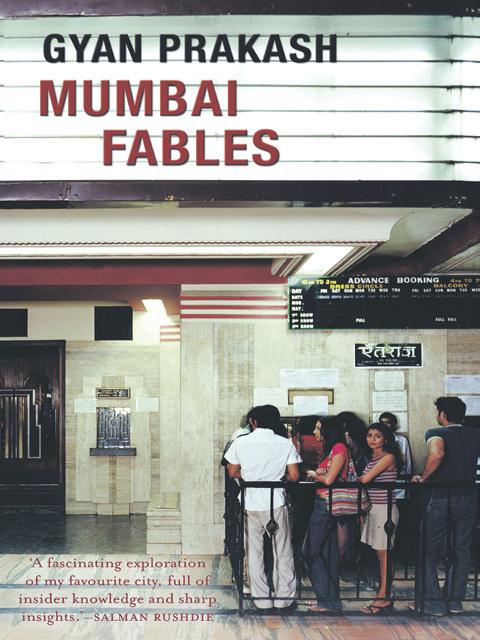
Writer Gyan Prakash, an urban historian, documents the city’s tumultuous years of unbridled growth, society gossip, scandals, Bollywood, politics, annual deluge, terror attacks and economic boom.
At the centre of the fables are Mumbai’s people: a curious lot of long-suffering yet creative beings who think big and build tall buildings, thanks to the dreams that the multi-million-dollar movie industry inspires and the enterprise that gives these dreams shape.
Why does Mumbai work for writers?
“Mumbai is a place of invention,” US-based writer Prakash, a social commentator and professor of history at Princeton University, says. “People come to the city and inherit it; this aspect is built into the DNA of the city. As a result, Mumbai seems to be a place where you can make something from nothing.”
Sample this: the writer-historian, whose fascination with Mumbai began while growing up in Patna in Bihar, was walking through the crowded Bhendi Bazaar area of
the city when he came across a little space with a garish signboard under an awning.
“It said ‘New York Realty’,” Prakash recalls. “The person manning it had brought the aura of New York to the little space. This is an example of someone living under difficult circumstances, letting his imagination soar. This kind of ambition is only possible in Mumbai.”
If mounting problems produce despair, they also generate opulent visions, the writer observes in his book.
A new vision of Mumbai began emerging in 2003, on a study by McKinsey and Company, which developed the database and framework for benchmarking Mumbai under different parameters: from “poor” to “average” to “above average” and finally “world class”. It urged a change in mindset and resulted in anarchic progress that fed many myths.
“For me the image of Mumbai became richer when I went to the city for the first time since adulthood in 2000,” Prakash says. “Suddenly, everything seemed more than I could imagine. On the face of it, the city is dilapidated, shabby, mildewed and bumbling, yet people create all these fantasies about Mumbai. I wanted to probe the stories people have created for themselves”.
The Bombay cinema created this desire for the city. At times real life incidents fired the imagination of filmmakers.
The Bombay tabloid Blitz encapsulated the city’s naughty and brazen spirit and fanned the nation’s curiosity into an obsession with the sensational Nanavati case in 1959. Prakash recounts the famous murder case that inspired a film.
The image of the city and its subculture was also reinforced by columnists like Busybee (Behram Contractor) and Gangadhar Gadgil. Mario Miranda’s cartoons in The Illustrated Weekly also left stereotypical images such as the buxom Anglo-Indian secretary Miss Fonseca, actress Rajni NImbupani and the Catholic girl Petrification Pereira.
It is no surprise that the larger-thanlife Mumbai became more resilient in the 1990s and later.
We read about the floods in 2005, the train bombings of 2006, the terror attacks of 2008 and other such incidents. “The series of catastrophes gives Mumbai the status of a city under crises and provides a kind of frame for people to think about what they can do to overcome them,” Prakash says.
Madhusree Chatterjee
Alex Rutherford: Empire of the Moghul: Ruler of the World, published by Headline Review

Ajay Khullar: The Nothing Man, published by Rupa
Gyan Prakash: Mumbai Fables, published by Harper Collins-India
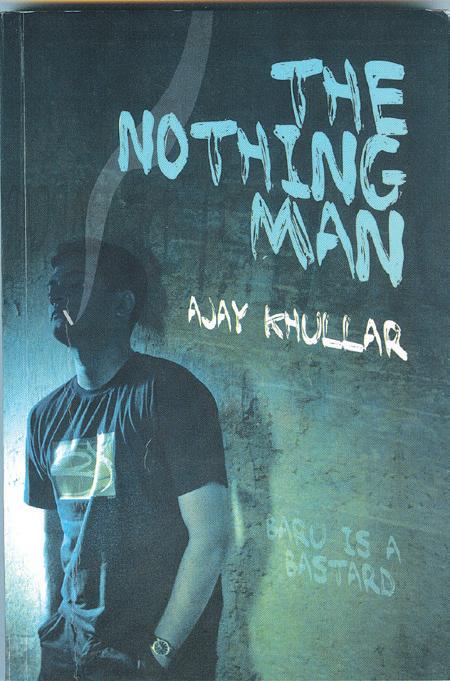
OCTOBER (2) 2011 <> 55 NATIONAL EDITION BOOKS www.indianlink.com.au
11 reasons to celebrate in ‘11
The festival season has begun and celebrations are unlikely to stop before the year’s end, so join in and have fun, writes
FARZANA SHAKIR
or cooked the same special dishes saying, “That’s how we celebrated when I was little.” Imagine, wouldn’t you want your grandkids to know someday, how you made these days special. Ahh, the satisfaction of being emulated! But you can only hope for such adulation if you’ve done your bit and made an effort to make festivals special for your kids.
As life becomes busier, old traditions are being forced to take a backseat to other priorities. For some, celebrating even religious festivals is slowly becoming a luxury they can’t or won’t afford. Since we live in a country where everyone is not of the same cultural background and consequently don’t celebrate the same festivals, it requires a special effort on our part to recreate the atmosphere of back home during these times, especially since there are no public holidays to mark them. Sometimes it becomes too much of an effort for people who don’t even take a day off from work to celebrate these occasions, citing important deadlines or meetings as excuses. But is this indifference worth it?
We migrants have a responsibility to our religion and culture, to pass on traditions to our younger generation. If we don’t make a big deal of our customs, we send a message that they are not important. In time, we will kill our traditions and our children will lose their identity. We might not realise it now, but later when our youngsters won’t want to know about Diwali, Eid or our other traditions, we will be the first to blame them for veering away from their religion and forgetting where they come from. But will they be to blame if we don’t make an effort to make these days special for them now?
Not only that, marking our special days has many more benefits and here are just a few reasons why you should celebrate this year.
3
4
Celebrating our traditions makes us appreciate our families, friends and loved ones. It gives us a feeling of belonging, of being part of a bigger picture.
It is an excuse to pause counting calories and indulge in food and drink (the guilt will come later, we know, but for now, who cares?!)
5
Festive occasions have a heady effect of opening up your heart and making you want to forgive and forget. Isn’t it often on Diwali, Christmas, Eid and other festivals that you make up with friends or family you’ve quarrelled with, often waiting till the very day to make that conciliatory call, because you know that like you, the other person would also be more forgiving on that particular day, than on any other.
6
Taking time out to celebrate our festivals provides an opportunity to catch up with people we are no longer in contact with on a regular basis like old colleagues, distant cousins and past neighbours. There’s a feel-good factor at play when you send or receive hordes of cards (even if they’re only e- cards!), knowing you are loved and remembered on these special days.
1
Celebrating a festival allows us a break from the mundane routine of our daily lives. While we work like machines to ensure the bills are paid, here is something to look forward to all year round.
2
It brings us closer to our religion. Prayers and worship are the essence of religious festivals, and for some people it is the only time they indulge in this activity. So if nothing else, that’s one good deed done already!
7
Celebrations are legal excuses to let your hair down and throw all cares to wind. You can literally get up and start dancing without people labelling you a lunatic with a simple, “Hey, it’s Diwali!” and everyone would not only understand, but might even join in.

Finally, festivals are an excuse to dress up, go shopping, cook a feast, give and get presents, to generally splurge within or beyond your means and not feel guilty at all!
8
Festivals are times to carry on old traditions and feel a connection with our roots. These are important times to pass our culture on to our children who are our successors, like our parents have done before us. How many times have we decorated the house just so,
9
If you reflect you will realise that even a single thoroughly celebrated and enjoyed festival annually leaves you completely revived (often exhausted), till the same time next year. And of course, gossip from the parties will enthrall you for a long time after the effect of food and drink has worn off (or those visiting relatives have left)!
10
Celebrations are also important because they provide a lot of fabric to make up our memory quilts. Some of our happiest and memorable moments are from the celebrations of yesteryears. If you don’t celebrate, you miss out on looking back in later years to these special times spent with your loved ones.
11
Finally, festivals are an excuse to dress up, go shopping, cook a feast, give and get presents, to generally splurge within or beyond your means and not feel guilty at all!
Admit it! A good celebration makes you happy, and being happy keeps you healthy. So don’t hold back this season. Go on, celebrate and have a happy and hearty Diwali, it comes only once a year!
56 <> OCTOBER (2) 2011 INDIAN LINK
DIWALISPECIAL www.indianlink.com.au
There’s a feel good factor at play when you send or receive hordes of cards (even if they’re only e- cards!), knowing you are loved and remembered on these special days.
Diwali: Seeing the light within ourselves
An ancient Hindu festival is now marked all over the world
BY MALLI IYER
If there ever was a festival that stood for righteousness, enjoyment and good, clean family fun, it would have to be Diwali, or Deepavali as it is also known.
No less than 2 billion people of Indian/ Asian origin scattered across all corners of the world celebrate the Festival of Lights. Whilst the festive season and dates of the festival rarely deviate from the original Hindu calendar – two days on either side of the new moon day in the month of Kartika – the celebrations over five days symbolise the devotion to animal preservation, new beginnings by banishment of evil, and promoting family togetherness. The reasons for celebration vary, although the most common rituals include spring cleaning the home environment, lighting lamps and letting off crackers to create brightness as the new moon (Amaavasya) day has all-pervading darkness at night.
Fireworks are associated with the celebrations, and the creation and distribution of sweets and culinary delicacies reaches its climax during the festival.
The Festival of Lights, in essence, is universally a celebration of light over darkness, ie, of good over evil, and of knowledge over ignorance. At the same time, it also stands for seeing the light in our own selves –vanquishing the darkness within us, and allowing the goodness in us to reach out to others around us.
Diwali worldwide
Deepavali is celebrated in over 30 countries – Nepal, Fiji, Malaysia, Singapore, South Africa, USA, Canada, Australia, United Kingdom, Trinidad & Tobago, Guyana, Barbados, Sri Lanka, Gulf States in the Middle East – Dubai, Abu Dhabi, Oman, Qatar, Bahrain, Sharjah,Yemen, Indonesia, Mauritius, Thailand, Japan, Kenya, Uganda, Tanzania, Myanmar, Suriname, Zambia and New Zealand, Pakistan and Afghanistan.
Parliament House. The festival is marked at the Federal Parliament in Canberra as well.
In Japan, Deepavali is celebrated by lighting paper made lanterns of different colours in their orchards and gardens. In Fiji, soccer tournaments are organized for the festival and there is widespread belief that eating fish after celebrations will bring them good luck.
Canada celebrates the festival by organizing a beauty contest and the winner is named Diwali Queen.
Malaysia calls the festival Hari Deepavali as it almost coincides with Hari Raya Aidilfitri (a Muslim Eid festival).
In Nepal, Deepavali is known as ‘Tihar’ or ‘Swanti’ and cows are worshipped on day 1, whereas dogs are revered as the ‘vahana’ of Bhairava on day 2.
In Thailand, Deepavali is celebrated by the name of Lam Kriyongh and oil lamps made from banana leaves are set afloat down the many rivers in the country.
In Sri Lanka there is a tradition of Deepavali to make toys out of crystal sugar (Mishri) instead of sweets.
In many parts of North America, the festival features east Indian folk theatre, skits and plays. Some areas celebrate with folk dances from Rajasthan, Punjab, Odissi and Bharata Natyam. Some even sing qawwalis and perform tribal dances.
The Festival of Lights, in essence, is universally a celebration of light over darkness, ie, of good over evil, and of knowledge over ignorance.
At the same time, it also stands for seeing the light in our own selves –vanquishing the darkness within us, and allowing the goodness in us to reach out to others around us.
Several of them observe this as a public holiday. The House of Commons in the UK is decorated with lights, as are State and Federal Government buildings in most South Asian nations. In Australia the state government of Victoria has endeared itself to the Indian community by celebrating the festival at one of Melbourne’s most iconic venues, Federation Square. The NSW Parliament celebrates promotion of equality, mutual respect and social harmony by lighting up the exterior of the state’s
In the Caribbean Islands, Trinidad and Tobago celebrate the festival at Diwali Nagar – en enclave created by the IndoTrinidadians which lasts a week and a national holiday is also declared. There is enthusiastic participation by Indo-Trinidadians and AfroTrinidadians.
Guyana, which has an Indian diaspora of just under a million, follows a similar pattern. The spirit of togetherness is celebrated by wearing colourful costumes and a carnival like atmosphere is created.
In the UK, at Leicester City’s golden mile of curry houses, the community has the biggest celebrations outside Asia with over 6500 lights and fireworks at night.
Traditions of Diwali
In several parts of western India, the festival heralds the arrival of the Hindu New Year and the merchant community in India start a new accounting year on Deepavali.
In Punjab and all over North India, people resort to gambling and playing cards.
The Kailash temple in Ellora has a sculpture that symbolises Lord Shiva and Parvati playing a game of dice. Some people believe that if they don’t gamble on the day of Deepavali, they will be reborn as donkeys! Firecrackers and fireworks are an essential element of Diwali night. A scientific
explanation for bursting crackers is that after the monsoon in India the mosquitoes and pests multiply in huge numbers and cause diseases. Although smoke and noise pollution are unnecessary legacies of Diwali crackers, the sulphur dioxide released in the atmosphere kills the harmful pests.
The mythology behind Diwali
Deepavali legends abound in Indian mythology and history.

> The countrywide belief is that Goddess Lakshmi was born on this day after the churning of the milky ocean by the Asuras and Devas for Amrit (the nectar of immortality). Goddess Lakshmi is also known as the daughter of the Milky Ocean.
> In the east though, Goddess Shakti’s emergence as Shyama Kali or “Kaal Bhaya Naasini” is generally believed to be the cause of celebration. Shakti’s killing spree of demons (and consequent decorating of herself with a garland of skulls) destroyed evil and helped protect heaven as well as earth from cruelty.
> Lord Vishnu’s rescuing of Sri Mahalakshmi from the clutches of King Mahabali in his Vamana Avatara incarnation is legendary. Mahabali was banished to rule the kingdom of Patala under the oceans after this.
> Lord Rama’s victorious return to Ayodhya after conquering Ravana is now established as 5075 B.C. which makes the first known Deepavali celebration over 7000 years ago. Sage Valmiki who was an astronomer has accurately written about the life and times of Lord Rama and the planetary positions
It can be safely concluded that Deepavali celebrations on a global basis and particularly in India, serve to emphasise a new beginning, communal harmony and a rejuvenation of family values.
described by him has been checked and validated by computer experts.
> Bhudevi in her incarnation as Satyabhama and wife of Lord Krishna killed her own son, the demon Narakasura as per his wish. Narakasura apparently wished that his death should be celebrated by people by lighting lamps and brightening the city which is how Deepavali became a festival.
> The return of Pandavas to Hastinapura after 12 years in exile after they lost to their evil cousins the Kauravans in a game of dice, is also considered to be a reason to celebrate Deepavali.
> The coronation of King Vikramaditya in 56 B.C. after his victory over the Saka Kings is seen by historians as one of the reasons for celebrating Diwali.
> The Jains in India see Deepavali as an occasion to mark the attainment of Nirvana by Vardhaman Mahavira in 527 B.C.

> Sikhs celebrate it as the day of release of Guru Har Gobind Ji and the laying of the foundation stone of Har Mandir Saheb (the Golden Temple in Amritsar) in 1577.
> Arya Samaj followers celebrate it as Nirvana attainment by Swami Dayananda Saraswati in 1875.
OCTOBER (2) 2011 <> 57 NATIONAL EDITION DIWALISPECIAL
US President Barack Obama brought Diwali to the White House for the first time in 2009
www.indianlink.com.au
EARN SERIOUS INCOME








58 <> OCTOBER (2) 2011 INDIAN LINK Only one call can change your life Dr CHANDRIKA SUBRAMANIYAN Highly Commended Award – Women Lawyers Association NSW Solicitor & Barrister Supreme court of NSW Migration Agent # 0534196 Nominee 2009 Justice Award Law and Justice Foundation Nominee 2011 Woman Lawyer of the year in a community CRIMINAL BIG or SMALL PROPERTY BUY SELL LEASE BUSINESS & FRANCHISE AGREEMENTS FAMILY DIVORCE CHILDREN AVO WILLS & PROBATES EMPLOYMENT ALL COURT WORK, OUT of COURT MIGRATION (02) 9633 5019 | 0433 099 000 Casual work available (may lead to full time position) mowing,cleaning and gardening • Applicant must be fit and well presented also need to speak english • Prefer applicant to have an ABN number • Experience not required as training will be provided • Must be available to work flexible hours Contact Tony on 0410 605 360 or send a message if phone not answered PART TIME/FULL TIME INSURANCE ADVISORS One of the biggest insurance companies in India are looking for full time/part time advisors to work form Australia. Pl. contact Aashish on +91 9811613250 or email on aashishsharma.pg@gmail.com for more info INCOME OPPORTUNITY TO BE THE VERY FIRST PIONEER IN INDIA Experienced, Successful Network Marketer is looking for business partner to launch Indian Market as a Ground Floor Opportunity. This World-class Fast Growing International Company achieved $3.7 BILLION sales in 6 years and debt free. This company has just opened In Malaysia and Thailand. Only one product, health beverage, no stocking required. WE ARE LOOKING FOR PEOPLE TO WORK WITH PERSONALLY. Must be Ambitious, Hard working, Honest & Teachable. We are only looking for people who are genuinely and seriously seeking opportunity and desire to change life. Free Sample will be provided, Modern Office To arrange a meeting, contact : Zan 0414 767 419 (English)
Diwali nights with Chintu
BY ROY LANGE
My memories of Diwali in Delhi are as colourful as the celebration. As a student of Delhi University, I celebrated this festival with gusto and on one memorable year, with 1,000 bottles of Pepsi, a roulette wheel and the Delhi Police. The catalyst for this adventure was an amazing man called Chintu Chawla, proud resident of Rajouri Garden and entrepreneur extraordinaire. Like many Sikhs, he made the best of friends and the worst of enemies. Despite his outwardly aggressive Delhi persona that involved charismatic tirades of Punjabi abuse that would have made Laloo Prasad blush, he was big-hearted to a fault and wept every time we had a chicken slaughtered. Despite his habit of loudly threatening drivers that cut him off with dire sexual consequences to their next of kin, I sentimentally remember him threatening to kill me if I swore within a kilometre of Bangla Sahib, the great Sikh temple of Delhi.
I had been fortunate enough to be befriended by Chintu in Sri Venkateswara College when I was still struggling to spell it. I soon found out, before the days of Twitter or even mobiles, that he was a human social media hub and knew everything that that was going on in West Delhi. To a supernatural extent. “Nirula’s at D-28 were raided last night by the ITO. They had 3 crores under their mattress!”; “My cousin’s bhabhi’s grandfather owns three illegal rifles and last week shot a monkey!”
Chintu not only knew everything that happened, he desperately wanted to be there when it did. That meant long laughter-filled nights jumping off and on the Mudrika (Ring Road bus) or if we were lucky, in his family’s temperamental Maruti 800, chasing down the latest Old Monk and water get-together or in this case, the latest high stakes Diwali “Flash” game.
Twenty years later I can very clearly remember Diwali flash parties at the Chawlas. Even then the joint family was an institution under attack, but the Chawlas had gallantly swum against a strong tide of change, and a matrix of relatives lived in a huge house in D Block. Diwali would see the lounge filled with enormous Sikhs, constructed with stiff Patialas and paddling pool sized servings of butter chicken, jealously nursing their two dealt playing cards. They looked like a range of the Himalayas with two dwarfed checker-patterned billboards on the side of each mountain.
Punjabis are a jovial lot but when money is involved, there can be a sudden air of intense seriousness and uncharacteristic silence. The tradition of gambling during Diwali was no exception. It was a very serious business indeed, with little eye contact between poker faces, just a flurry of suspicious side glances and nonchalant throws of money into the pot.
This mesmerising meditation would be broken by truly violent eruptions of cheating accusations and heartstopping drama. Truly not for the faint hearted! On my first few visits to the Chawlas I thought they were suffering an almighty ongoing row and confided this to Chintu who doubled over laughing and said, “Nei yaar, that’s how Punjabis talk only!”
Chintu may have had a truly sensitive protective instinct of condemned chickens, but I soon found this didn’t extend to his fellowmen. Diwali night in the streets of Rajouri Garden is to relive the Lebanese civil war, on a bad night.

It is beyond description. India has not heard of occupational health and safety, and her fireworks are not the effeminate ones of my youth. They really should be stored in ammo dumps under armed guard. Much to my delight they don’t have crackers, they have patakas. These annually

claim thousands of fingers and under our command, made enormous holes in aluminium billboards advertising VIP underpants.
Skyrockets were designed to be fired vertically, but West Delhites find a well-intended horizontal launch very satisfactory, and in the direction of a neighbour’s face, infinitely more satisfying! Multiply that by a thousand neighbours, slash combatants, and you have some idea of the ferocity the celebration evokes. The exhausting swing of my emotions from an instinct of self-preservation, fighting a strong impulse to dive head first in to the ditch, and the wonderfully liberating experience of firing kilos of gunpowder at young families.
In hindsight, I can see why Chintu is such a good survivor. Though we nearly didn’t survive the following year’s Diwali.
Chintu, naturally entrepreneurial, had heard on his amazing radar that people were making a small fortune in the Diwali fairs selling the new multinational soft drinks. Thick as thieves, we pooled resources and in no time we were riding in a truck, the proud guardians of 1,000 bottles of Pepsi.
Setting up our stall at Green Park mela, it didn’t take long to realise we were in deep trouble. We had been duped into believing we would have the monopoly, and our prices plummeted from a level that would have seen the proceeds purchase a year’s supply of Old Monk from the Army Canteen to a level that would have seen a year’s supply of ruthless ridicule instead.
We hadn’t even dented the skyscrapers of Pepsi crates which formed a towering backdrop to our depressingly quiet stall, in a furiously busy fair. That night we barely slept as we nervously pondered how we were to sell more bottles, and I had never slept on Pepsi crates before (because we couldn’t risk any bottles being stolen). It was a tricky manoeuvre as we hadn’t sold more than six crates and we were dangerously high off the ground.
Despite his deep reservations, Chintu listened to me and we made a clown’s face with holes for eyes and a mouth, to charge punters to take a chance at throwing a ball through and claiming a Pepsi as a prize.
This was reminiscent of my later business decisions. I clearly should have seen that establishing a game, where our fiscal survival was dependant on Indians not having any cricket skills, was not sound. We got rid of quite a lot of Pepsi, but it was next to free. Cricket guns with seriously strong throwing arms consistently found their mark and in no time the hardboard clown, to their great delight, was
Skyrockets were designed to be fired vertically, but West Delhites find a well-intended horizontal launch very satisfactory, and in the direction of a neighbour’s face, infinitely more satisfying!
firewood.
Then Chintu looked dangerously preoccupied; genius was in motion. As genius is a slip away from madness, we found ourselves at a toy shop buying a miniature roulette table.
Incredibly, we moved the supplies to Lajpat Nagar where we slept again on the crates and I have a very clear memory of wrapping myself up against the swarm of mosquitoes in a cloth street sign for woman’s unmentionables in Central Market, and drifting off to the calls of the night watchman as he made his rounds.
The roulette table was the hit of the fair and we didn’t know where to put the bundles of cash that were being thrown at us. Chintu had had the courage to give the wrong odds without our customers knowing any better. We could see ourselves hosting a party to end all parties in no time at all.
Then as I greedily looked down at the glorious piles of crumpled notes ready to sweep yet another avalanche into our money box, I only just missed having all my fingers broken.
(truncheon) was brought down with such force on our table that the roulette wheel flew into the air, closely followed by Rs 100 notes and the grasping hands of their owners. A Jaat constable who looked like a well-made public building screamed a string of abuses that even Chintu, though now open-mouthed and decidedly paler, couldn’t help feel some admiration for it’s colourful delivery.
The tradition of gambling during Diwali was a very serious business indeed, with little eye contact between poker faces, just a flurry of suspicious side glances and nonchalant throws of money into the pot.
Chintu trembled, “Bhaisahib, please come to the side and we can work this out!”
The cop erupted, “Do you think I am a dishonest cop?”
We all shook our heads furiously, indicating ‘no’.
“If I take money, I take it front of the people!”
Twenty years on, Chintu lives in Torronto with his beautiful young family. It’s a joy to phone my brother and remember those cherished days. It’s with sadness I won’t be able to wish him Happy Diwali with a big Punjabi hug.
You can take the boy out of West Delhi but you can’t take West Delhi out of the boy. For that I am very grateful, because while for some he was the worst of enemies, for me he always made the very best of friends.

OCTOBER (2) 2011 <> 59 NATIONAL EDITION
DIWALISPECIAL
Gambling at Diwali is acceptable within the confines of one’s home, but in a wider public forum, it doesn’t seem to appeal to the law
www.indianlink.com.au
Backyard fireworks



60 <> OCTOBER (2) 2011 INDIAN LINK
Making it
work
BY SAROJA SRINIVASAN
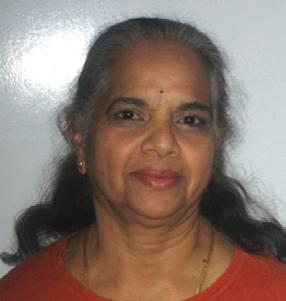
The very word “relationship” assumes an active interaction with another. One is relating to another, so there are at least two people involved in this exercise. No relationship however brief, casual and sometimes even trivial, is totally meaningless. Every time we have interacted for however brief a period with someone, some information has been exchanged which will be retained by those involved. Sometimes it can be a very valuable source to understand oneself better. Relationships are never static. Every relationship goes through changes constantly, despite appearing stable in some aspects.
Matrimonial mystery
Celebrating silver and golden anniversaries in themselves don’t reflect a ‘good’ marriage. It is well known that many couples stay on in a marriage for reasons such as economical dependence or because it is culturally frowned upon to separate. Any long-term relationship that has survived external challenges for many years and presented a united front is to be commended. This however doesn’t necessarily reflect marital satisfaction or happiness. There may be an absence of obvious unhappiness, but the emotional storms raging within the partners may very well have surfaced on many occasions within the safe confines of their home.
If time spent together doesn’t necessarily guarantee happiness, what else may be needed for a ‘good’ relationship? What contributes to happiness or satisfaction in a long-term relationship? These questions arise time and again. Obviously there is no single or simple answer.
Making it work
A sustained level of happiness in a relationship requires not just adhering to societal norms, but a certain mind-set that will bring a level of contentment in the relationship. The right attitude to appreciate the ups and downs that are likely to arise when two individuals spend time together is vital to make it a success. In simple words the relationship has to start with the strong determination that both are prepared to work at it – ‘for richer, for poorer, in sickness and health’ and a desire to make it work. On the other hand, if one goes into a relationship with the idea that ‘I can always leave if it doesn’t work’, this provides a way out that never allows for total commitment.
Quite often the length of the marriage is mistaken for

commitment. The commitment made by both partners is reflected in the level of emotional intimacy and trust that both have towards the other. This can be a ‘feeling of comfort’ in the partner’s company, a sense of ‘being on the same wavelength’, a ‘feeling of being connected’ at an emotional level and a willingness to appreciate differences. Often this may be illustrated by being involved in finding solutions to the problems that they face or making joint decisions, whether they are major or trivial.
A time for trust
When partners feel at ease and doubtfree about the other, there are ways of finding creative solutions to problems that surface from time to time. ‘Two heads are better than one’ is a common cliché, and it is certainly true in successful relationships. Consulting each other in decisions that have to be made, however trivial, is a fundamental requisite for a truly successful, satisfied and happy relationship. The satisfaction that comes from being truly involved in all aspects of the relationship contributes to maintaining a strong relationship.
Relationships that survive without intimacy or involvement, with each partner leading parallel lives are not necessarily successful or happy ones. It is often referred to as a ‘marriage of convenience’ and is not necessarily a happy one. Often such relationships continue from negative energies created and maintained by criticisms, and lack of respect. Perhaps one could even refer to them as ‘marriages of inconvenience’! Successful relationships, on the other hand, allow each partner to have the freedom to be who they are without constant attempts to change them to be what one would like them to be. In such relationships each allows the other to grow, appreciating each other’s strengths and supporting the partner to reduce each other’s weaknesses. Mutual attraction, which can be mistaken for true love, alone may not suffice to maintain a strong relationship.
Successful longterm relationships are based on good communication, cooperation between partners, enjoying contentment, affirming a strong commitment and providing companionship
True love is made of many important values. Successful long-term relationships are based on good communication, cooperation between partners, enjoying contentment, affirming a strong commitment and providing companionship. This is perhaps best illustrated in the well-known and oft quoted passage from Corinthians 13: ‘Love is patient, love is kind. It does not envy, it does not boast, it is not proud. It does not dishonor others, it is not self-seeking, it is not easily angered, it keeps no record of wrongs. Love does not delight in evil but rejoices with the truth. It always protects, always trusts, always hopes, always perseveres. Love never fails.’
Win a candle gift pack worth $225!
Happy Diwali from PartyLite
PartyLite, the world’s largest direct seller of exclusive candles and homewares, would like to wish everyone a Happy Diwali! To help you celebrate this auspicious occasion, PartyLite is giving away irresistible gift packs to twenty five lucky readers, valued at over $225 each. To win, describe in 25 words how you would best like to celebrate Diwali. Send in your responses to: info@indianlink.com.au before 15 Nov 2011
Each gift pack includes five Colour Lites Tealight Holders in Purple, Pink, Turquoise, Green and Orange (one each); six Colour Lites Votive Holders in Purple, Pink, Turquoise, Green, Orange and Clear (one each); and two 18-piece tealight samplers. The range of tealight holders, votive holders and fragranced tealights are designed to suit all rooms and moods, and will help make any occasion a festive one!
This exclusive range of home accessories and candles is only available through PartyLite
consultants. Visit www.partylite.com.au to find your local Consultant, or to get information on how to earn money by starting your own home business with PartyLite!
About PartyLite
With over 68,000 consultants worldwide, PartyLite is the world’s largest direct seller of candles and home decorating accessories. PartyLite has been a leader in the art of creating ambience and entrepreneurial home business opportunities for over 35 years. Using recyclable materials and energy-efficient technology, PartyLite promotes environmental sustainability and responsibility. PartyLite Australia is committed to corporate social responsibility and is a proud sponsor of the Children’s Hospital Foundations Australia (CHFA), donating tens of thousands of dollars per year to the national charity.
OCTOBER (2) 2011 <> 61 NATIONAL EDITION
PSYCHE
Being in a relationship is more than just the euphoria of love; it means companionship, commitment and trust
www.indianlink.com.au
Successful relationships, allow each partner to have the freedom to be who they are without constant attempts to change them to be what one would like them to be
QUEENSLAND INDIAN GOLF FEDERATION

QIGF organizes 5th Baisakhi Golf Open at Gold Coast, Australia
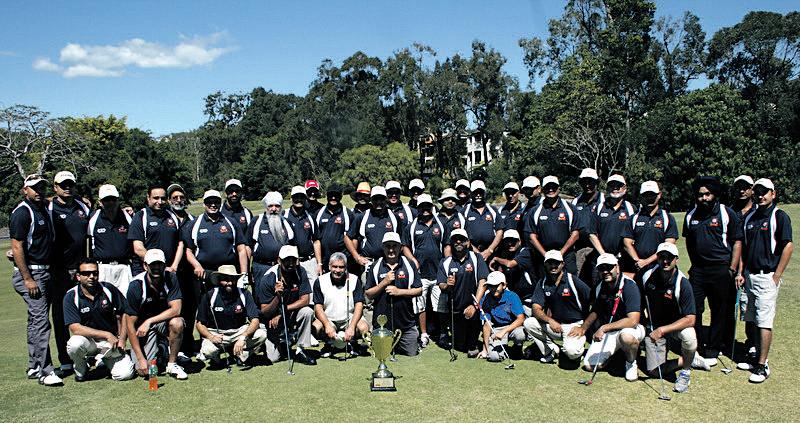

5th Baisakhi Golf Open championship was organized by the Queensland Indian Golf Federation at Radisson Resort/Robina Woods Golf Course at Gold Coast, Australia on 1st and 2nd October, 2011. The tournament was sponsored by King’s Institute of Management & Technology, Brisbane and SinghCorp Brisbane. The event was held over two days with social golf play on Saturday the 1st October followed by dinner and entertainment in the night. Participants consisted of members of both Indian and Australian community Around 65 Golfers from all over world participated in the event.
Mr CSR Reddy IPS, Inspector General –Crime Wing, Punjab & General Secretary CGA Chandigarh, Dr Roshan Sunkaria, IAS, Secretary to Govt. of Punjab, Department of Higher Education & Languages and Major Anil Ahuja (Retd.), who especially came from India to participate in the event, released the tournament souvenir.
In the Stroke Play format, Raj Kalsi from Brisbane received the winning trophy (King’s Cup), while Amandeep Sandhu from Brisbane came 2nd The Longest Drive was won by Aman Mavi from Sydney. The Closest to Pin was won by Paramjit Sangha, Amandeep
Be a Pioneer in Opening an India Market
A world class company which is one of the fastest growing companies in America’s history has broken the past 100 year’s record in the Network marketing industry is NOW expanding its business into India and we are offering a GREAT, GREAT, GREAT opportunity to be a pioneer and have a business in this great country India.

We are looking for people who are genuinely seeking their BIG CHANCE and must be honest, ambitious, hardworking and teachable. We are focused in developing leaders and will provide all training and support, plus a free sample of the product will be given to those that attend the interview.
Sandhu, Bob Kalsi (all from Brisbane) and Ricku Gill from Sydney.
In the handicap format, Bhavneet Sohal from Brisbane came 1st while H S Sachdeva from Brisbane and Dr Roshan Sunkaria from Chandigarh came 2nd and 3rd respectively
In the end Mr Swinder Sandhu thanked the participants and sponsors while. Mr CSR Reddy presided over the award presentation ceremony & congratulated Mr Narinder Gill and Mr Gurpal Sohal for successfully conducting the tournament.
SPECIALISATION
General, Cosmetic & Children’s Dentistr y, Scale & Clean, Root Canal Treatment, Dentures, Crown & Bridges, Teeth Whitening, Extraction & Mouth Guards
MODERN AND HI TECH EQUIPMENT / EXPERIENCED DENTISTS

Dr Ravinder Kaur BDS, MDS (Syd Uni)
Dr Shaveta Batish BDS, Dr Juzer S Naseem BDS, Dr Divya Sharma BDS
62 <> OCTOBER (2) 2011 INDIAN LINK
secure an interview call Willie 0404 816 078 or Shelly 0412 526 628
To
Q I G F G o o d Te eth B e tter H e a l t h
Two Convenient Locations - Mon-Fri: 9am – 5:30 pm, Weekend: 9am – 2pm Glenwood Shopping Centre 4/60 Glenwood Park Drive, Glenwood Ph: (02) 8883 5222 Fax: (02) 8883 5293 Hassall Grove 10/211 Buckwell Drive, Hassall Grove Ph: (02) 8678 0882 DD Dental
Laughing
for a better life
BY UTTAM MUKHERJEE

Let’s start with a joke: Santa and Banta were fighting after an exam. The teacher asked, “Why are you fighting?” Santa replied, “Sir, this fool left the answer sheet blank!” The teacher was puzzled and asked, “So what?” Santa replied, “I did the same thing. Now you will think that we both copied!” If you laughed at this joke, it would have made you feel good; it would have fostered a positive and hopeful feeling, and this would have helped lower the level of stress hormones in your blood.
Club origins
Almost two decades back, Dr. Madan Kataria and a group of friends got together regularly to share a joke and a laugh. The group felt happy, energised and healthy. And even when they ran out of jokes, and simply laughed, they felt the same positive effects. It was then that the doctor discovered that laughter, whether real or unreal, delivered the same benefits. And so was born the concept of the Laughter Club, with the first one launched in Mumbai on March 13, 1995. Since then it has become a worldwide phenomenon with more than 6,000 Laughter Clubs in more than 60 countries, including Australia. Don’t be surprised to find a club near you.
Revolutionary and reviving
Now, Laughter Yoga is a revolutionary idea – simple and profound. Sometimes we call it ‘internal jogging’. Laughter Yoga combines laughter with yogic breathing. Laughter for no reason, that is, without relying on humour or comedy, has the same physiological and psychological benefits as real laughter. In a group (like the Laughter Club), laughter is simulated as a body exercise; with eye contact and childlike playfulness, it soon turns into real and contagious laughter. It is based on the fact that the body cannot differentiate between fake and real laughter.
There are many benefits of laughing. It helps control high blood pressure and heart disease by reducing the release of stress-related hormones and bringing relaxation. Laughter is an effective antidote for depression, anxiety and psychosomatic disorders as it boosts the production of serotonin, a natural anti-depressant. It keeps us healthy by enriching the blood with ample supplies of oxygen. It alleviates pain and offers a sense of wellbeing by releasing endorphins, the body’s painkiller hormones. For those who want a glow on their faces, laughter is the key as it makes your eyes shine with a thin film of tears which are squeezed from the lachrymal sacs during the act of laughter.

A concept for all
Here are two unique applications of this phenomenon. Laughter Yoga has been introduced in many schools which schedule a fixed time for laughter, either in the morning assembly or in the classrooms. These have shown that the mood and atmosphere amongst teachers and students get energised.
Believe it or not, Laughter Yoga is being practiced in several prisons in India, Europe and USA. During the making of documentary for BBC on human expressions, it was found that laughter had a profound impact on prisoners as it was an effective tool to release negative emotions. It is a great method of dissipating negative feelings of anger and frustration.
Laughter Clubs are social clubs. They are free for all. There are no formalities like registration, membership fees, meetings, protocol, and most importantly, no fuss. They are run by volunteers.
You may wonder what we do in a laughter session. The idea of Laughter Clubs is to gain the benefits of laughter.
This is done through a series of short laughter exercises combined with yogic breathing and stretching. A session generally starts with light exercises, including breathing. Laughter routines stem from innovations and improvisations of a laughter club, and get passed on from one club to another. Routines could commence with greeting laughter. The intensity of laughter increases with every routine. There are laughs on everyday life activities like laughter after getting a huge bill, applying a magical facial cream, or other situations. There are laughs that mimic the natural world, for instance the call of a kookaburra. At laughter clubs, we practice laughing until it becomes natural. It is often said in laughter circles, “Fake it till you make it!”
Join or begin
So, if you’re thinking of joining a Laughter Club, check the following link: www.hohohahaha.com/ LC_in_NSW.htm. You will find clubs in Sydney CBD, Camperdown Memorial Park, North Sydney Community Centre, Hornsby Park, Ashfield Park, among others. They have their own timings of sessions.

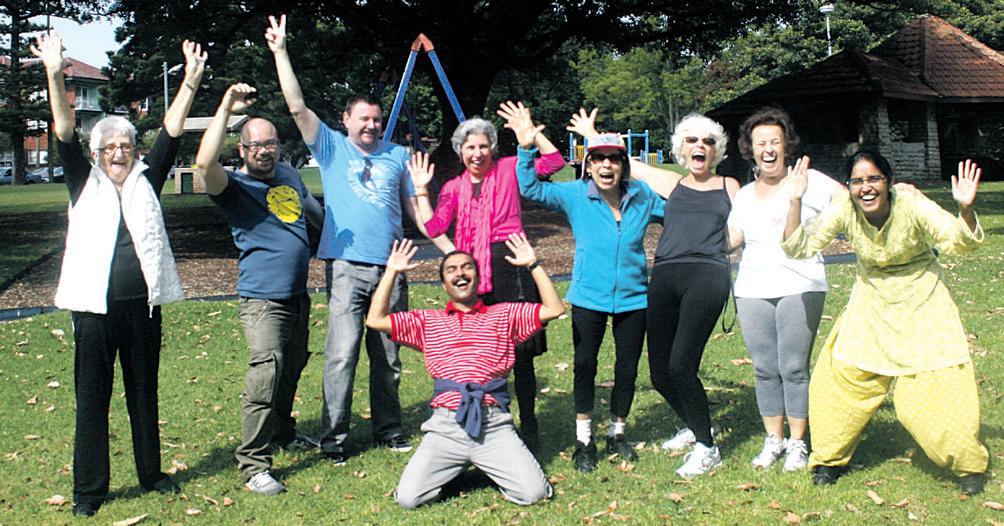
Or are you brave enough to start a Laughter Club? It is as simple as laughing! No one needs permission/ license (or registration with ASIC or Office of Fair Trading) to start one of these. Although no affiliation is required, it makes sense to join a group like the NSW Laughter Club, as it helps to put more people in touch. There are no rules and regulations in the conducting of Laughter Clubs. However, there are basic guidelines for its functioning: they are non-political, non-religious, non-exploitive, non-competitive, non-perfectionist and nonthreatening. The Laughter Yoga Movement does not recognise any hierarchy, position or title.
Usuff Omar is a veteran laugher in this part of the world. “Laughter to me means a way of life that isn’t too serious,” he says. “Laughter can also mean pleasure and euphoria. And a way of connecting with people, to overcome social fears. Laughter is also a way of relaxing myself in tense situations.”
A happy exercise
In many parts of the world, thousands of people go to Laughter Clubs in public parks. Most members proudly report that they hardly miss a laughter session. They say it makes them happy, healthy and energized - effecting a transformation in their lives. It results in the release of positive energy that makes it easy to cope
with the stresses of daily life and saves them from depression. In fact, the impact of laughter is so profound that many members claim they no longer need anti-depressants. Their sustained positive emotions keep them coming back for more.
It is often said that too much of anything can be bad. And so it is with laughter too. A typical laughter session lasts about half an hour. Anything beyond 30 minutes may be in the red zone and may adversely affect some people, especially seniors. Let this disclaimer not dampen your spirit, though. Laughing is a powerful form of exercise that can give you a cardiovascular workout more than many regular aerobic activities. So, wait no longer; join a ho-ho-ha-ha-ha club near you or be brave and start one!
Let’s end with another joke... well, you don’t really need one to laugh; you can laugh for no reason and reap the benefits anyway!
OCTOBER (2) 2011 <> 63 NATIONAL EDITION
WELLNESS
Laughter is indeed the best medicine to find release from a variety of woes, and joining a laughter club ensures you don’t chuckle alone
Laughter for no reason, that is, without relying on humour or comedy, has the same physiological and psychological benefits as real laughter.
www.indianlink.com.au
During the making of a documentary for BBC on Human Expressions, it was found that laughter had a profound impact on prisoners as it was an effective tool to release negative emotions
Right: Laughter Club in Ashfield Park and below in Newtown.



64 <> OCTOBER (2) 2011 INDIAN LINK Housekeepers urgently required for housekeeping duties, not limited to the following: Maintain the cleanliness and appearance of guest rooms Ensure all rooms are maintained at above the required standard Ensure all rooms are maintained within the given time Perform other duties as and when needed Housekeeping Jobs Email your application to kumar.maintenance@yahoo.com or call 0402 381 314 or 0425 569 123 To be eligible to apply for this position you must have an appropriate Australian or New Zealand work visa. World Famous Astrologer Ankit Sharma celebrates Diwali with you







OCTOBER (2) 2011 <> 65 NATIONAL EDITION Services Provided Threading & Waxing Facials Gel Nails & Minx Nails Manicure and Pedicure Hair Cuts and Colours Prime Location, next to Wentworthville Medical Centre and 1 minute walk from Udaya Spice ADDRESS: 5/108-120 Station Street Wentworthville NSW 2145 TEL: 02-9769-0001 EMAIL: info@feminabeauty.com.au WEB: www.feminabeauty.com.au this diwali we bring you… our newly opened salon with special off ALL services* 20% *not applicable to threading services valid until 18/11/2011 We wish all a Happy and Prosperous Diwali
BUSINESS FOR SALE
Indian takeaway and dining.
45 seats, Outdoor dining approved from council.
Can be easily converted to fine dine
Very long lease with 5 yr option, excellent location.
Very close to station in Kogarah.
Only shop in Kogarah with 10 meter frontage
All kitchen and dining equipment with 42” TV in dining.
Owner committed elsewhere.
Price $59,000 negotiable.
Won’t last early sale.
Contact 0401 337 700

100% GUARANTEE

66 <> OCTOBER (2) 2011 INDIAN LINK
Ground Floor Opportunity with Fastest Grow ing Health Beverage and Weig ht Management Company. Please call Brooke 0438 677 588. We are looking for 3 ambitious, hard working and honest people to join a Multi Billion Dollar Network Marketing Company. Fastest growing company in 100 years in its industry. Free Training and 24/7 Support. is could be a life-changing opportunity for the right person to secure a residual income stream, which will continue to grow despite any downturn in the economy

A day paradisein
Kumarakom and the backwaters of Kerala are a fascinating tourist find, a tranquil paradise amidst the harmony of rural life

 BY PETRA O’NEILL
BY PETRA O’NEILL

For my sixth birthday, I was given a book about a mouse who travelled to exotic destinations on a magic carpet. I am sure it inspired me to begin a lifelong search to find the wonder, enchantment and sense of adventure that I discovered within its pages. Recently I found myself contemplating about the book once more while swaying to and fro in a hammock, because at last I found myself in a mystical earthly paradise.
For a long time I’d wanted to explore the backwaters of Kerala. It is easy to get there, whichever way you arrive. I took a comfortable three and a half our taxi ride north from Chowara village near Kovalam to Alappuzha, more often referred to by its former name of Alleppey, along a fast-moving highway. We drove by prosperous busy towns and numerous resort and apartment developments under construction. Alappuzha was not quite the “Venice of the East” as tourist brochures would have it, with shops, a busy jetty and a multitude of boats. Since it was founded in 1762 by Diwan Raja Kesavadas, it has remained one of the busiest ports along the Malabar Coast and an important route trading pepper, timber and coir.
Kerala’s backwaters comprise a web of waterways and lagoons that form a natural inland transport network extending from Kochi to Kollam. At its heart is Vembanad Lake, the largest of the lakes covering an area of 200 square kilometres on the eastern shores of which lies Kumarakom and just inland Kottayam, described by Arundhati Roy in The God of Small Things.
While I was assured that every driver would know the jetty belonging to Spice Coast Cruises, it was eighteen kilometres further north of Alappuzha, with a turnoff down a winding dirt track. My driver Sajan patiently asked the locals for directions as we went.

The kettuvallam boat was beautiful, handcrafted with antiques, silk pillows and comfy teak chairs to relax on. Made from lengths of ironwood or jack wood, not a single nail is used in their construction. Rather, they are joined with thick coir ropes and sealed with black resin produced by boiling cashew kernels. Other boats found here include the traditional slender wooden punt, which for centuries, was the primary means of transporting cargo.
The kettavallam experience allowed me to drift past villages, temples and churches to observe the rural lifestyle. Swaying coconut trees, rice paddies, children returning from school, women washing clothes and men casting nets from their boats created a tranquil paradise that sustains a relaxed way of life.
The idea of transforming cargo boats into cruise vessels was the brainchild of Babu Varghese of Tour India, and their numbers increased sharply until a limit was introduced. There are said to be around 1700 of them, however my experience was not all good. There were times when a long procession of kettuvallams formed along the canals, perhaps to beat the curfew to get out of the backwaters by 6pm. Some were in poor condition with torn clear plastic lining showing through the tattered coir. I saw toilets flush and food scraps go straight into the water. We passed a shipyard that was building kettuvallams and I wondered at the impact they were having on the environment and on the people living here.
As you wind through the waterways, there are several stop-off points including churches, villages and Hindu temples. But the problem was that I could muster up no conversation! When I asked the Captain to outline the itinerary and tell me where we would stop, he told me to ask the others. The amiable cook spoke no English while the Assistant, who though affable enough, only pointed to a map. The Captain headed out to anchor in the middle of the lake. Later that afternoon we had several very pleasant hours cruising along waterways, before heading out once more to the lake.
The village of Kumarakom is a cluster of small islands on Vembanad Lake. On leaving the boat, I entered an altogether different place. Two staff greeted me at the Vivanta by Taj, accompanied me to the lobby and handed me a scented hand towel and fresh coconut drink. I was greeted by the General Manager, Sibi Mathew, who welcomes all his guests. For the duration of my stay, every need, every thought I had was anticipated and provided for. The meandering garden path to my accomodation within the 15 acres of the resort, took me past a large lagoon, over wooden bridges, fragrant flowering trees and by the adjoining bird sanctuary. Then I saw the suite in my villa. An entry hall led to a vast room with a lounge and study to one side that opened into my own lap pool, while a four-poster bed stood on the other side, with an adjoining semi-open garden bathroom. There were bunches of flowers, and petals strewn across my bed, my own private patio and garden, and there before me was the hammock!
As I pondered my good fortune in having decided to stay here, while enjoying the garden view from the hammock, I deferred all unpacking and instead read through the activity sheet that promised an afternoon filled with interesting things to do. I visited the Ayurvedic Spa and Fitness Centre. It was while I was lifting weights, that Dr. Dinal introduced himself to me. The treatments are designed to promote health and wellbeing and I hoped to return later for a head and shoulder massage, but it was time for lunch. Chef Arun asked if my delicious vegetarian selection was satisfactory and when I inquired about the dishes he had made, he asked if I had time for a cooking class. It had been only recently that President Patil and her family stayed here and for that visit, 24 vegetarian dishes were prepared for lunch. But I was due to proceed with the Activities Coordinator on a village walk. Being a local, he knew everyone and so we often stopped to chat. I then visited the Bird Sanctuary, an ornithologist’s paradise with egrets, cormorants, darters, herons, teals, waterfowls, cuckoo, wild ducks, woodpeckers and many migratory birds to be seen here.

68 <> OCTOBER (2) 2011
INDIADIARY
1 3 5 2
Since it was founded in 1762 by Diwan Raja Kesavadas, (Alappuzha) has remained one of the busiest ports along the Malabar Coast and an important route trading pepper, timber and coir.
1. Kettuvallams everywhere
2. Lunch, Kerala style
3. Backwaters




4. Sunset over Lake Verbanad
5. Public ferry
6. Instrumental Karnatic music and dancing

7. Author outside Villa, Vivanta by Taj, Kumarakom
8. Interior of Villa, Vivanta by Taj, Kumarakom


9. Lobby area, Vivanta by Taj, Kumarakom
I was running late for the sunset cruise of the lake to see the sky light up in magnificent shades of orange and red and when we returned, the General Manager was there to greet us with delicious savouries and masala tea.
When I returned to my Villa, a bicycle had been delivered together with a fruit platter and chocolates. Music began and local village women lit 700 candles around the lagoon, as musicians played instrumental carnatic music and dances were performed. As I dined on tomato soup, I thought this to be the most beautiful place I had ever visited. The next morning as I departed, the General Manager gave me a small bag. I opened it on the local bus bound for Kochi, and saw that it was a gift, a wooden boat and a letter thanking me for having visited. I have since thought often of my stay there. I really should go back, to stay for a week, not just a day, simply to lie in that hammock and relax for a while.
especially January, when prices escalate and it gets busy. April can be hot and July is wet.
High-end resorts are located in Kumarakom along Vembanad Lake. Unfairly, some guidebooks say there is not a great deal to do here. The Taj provided an educative and interesting activities program, most of it at no cost. I could have happily spent a week here; some repeat clients spend a month. You would be hard-pressed to find a more beautiful setting, more dedicated staff or more luxurious surroundings than at the Vivanta by Taj, Kumarakom. For a romantic getaway, to relax, to catch up with family and friends, it is ideal and I cannot recommend it highly enough. Tel: 91 481 252 4371 website: www.vivantabytaj.com
SPECIAL EVENTS
Every year in July and August, Kerala’s backwater canals host snake boat races.

Food: Cuisine from Kerala is renowned, and they make use of the abundant locally grown fruit, vegetables and fresh seafood. The breakfast buffet alone at the Taj offered an amazing selection.
Cuisine from Kerala is renowned, and they make use of the abundant locally grown fruit, vegetables and fresh seafood. The breakfast buffet alone at the Taj offered an amazing More information: Available at India Tourism, Glasshouse Shopping Complex, Level 5, 135 King Street, Sydney. Tel: 02 9221 9555 Email: info@indiatourism.com.au
OCTOBER (2) 2011 <> 69
www.indianlink.com.au 7 8 9 6 4
Photo: Petra O’Neill

70 <> OCTOBER (2) 2011 INDIAN LINK






OCTOBER (2) 2011 <> 71 NATIONAL EDITION Money TransferPT Y LTD No Commission, No Fee Mob: 0431525895 Ph: 1300 799 920 75A Enmore Rd, Newtown NSW 2042 www.moneytransfer.net.au Email: order@moneytransfer.net.au Super Agent of Fast and safe global money transfers Ex tensive coverage throughout Australia 10 MINUTES SERVICE TO INDIA, BANGLADESH, NEPAL & PAKISTAN (CONDITIONS APPLY) ACCOUNT CREDIT AVAIL ABLE IN INDIA IN 24 HRS WORLD WIDE ACCOUNT CREDIT COMMERCIAL PAYMENTS/ TRANSECTIONS UNBEATABLE RATES WORLDWIDE MONEY TRANSFERS We wish you all a very Happy and Prosperous Diwali
The jewel of Jeju The jewel of Jeju
BY SANDIP HOR

The eleventh day of the eleventh month of the eleventh year of this century, which when numerically dotted stands as 11.11.11, is very significant for the people of Jeju Island in South Korea; in fact, for the entire nation.

On this very day, the Swiss foundation on New Wonders of the World will declare the list of the new Seven Natural Wonders, after a three-year long internet and phone voting contest; Jeju Island being one of the 28 finalists racing for a place on the elite roll, with other natural artefacts from round the globe, including Great Barrier Reef and Uluru from Australia. On arrival at Jeju before the results were declared, we are predictably greeted by the intense hype around this international campaign and during our stay, we are apparently drawn into it. Friendly locals welcome us overwhelmingly and keep touting how scenic their home is, while media people seek our assessment on the natural splendours we experience. Korean celebrities are pictured campaigning on television, and brochures on how to vote are made easily available to all. We are enthusiastic as well, being part of something big to happen.
A nation’s treasure
and more that 160 lava tubes underground. Undoubtedly a wondrous feature that Jeju people desire to be recognised as a top natural wonder; though winning accolades is not new for Jeju.
It was named as a Biosphere Reserve in 2002, World Natural Heritage Site in 2007 and Global Geopark in 2010, making Jeju the world’s first and only area to receive UNESCO triple-crown.
Island delights
Our discovery of the very best of Jeju begins with a visit to the Jusangjeolli Cliff which was formed when lava from Mount Hallasan erupted into the sea of Jungmun. The rock pillars shaped like cubes or hexagons of multiple sizes appear as if carved by stonemasons. The panoramic seascape in front with high waves crashing into the rocky cliff and springing upwards is awesome.

Despite being just 85km from the mainland, this island was hardly visited for centuries. So it grew with its own traditions, culture, cuisine, dress, architectural style and dialect. Jeju Folk Village Museum, where we drop in next, is the venue where visitors get a taste of some of those Jeju specials.
It was named as a Biosphere Reserve in 2002, World Natural Heritage Site in 2007 and Global Geopark in 2010, making Jeju the world’s first and only area to receive UNESCO triplecrown.


Often coined as a “volcanic museum”, the oval shaped island spans around 70 km east to west and 30 km north to south, with the 1950m high Mount Hallasan dotting its centre. Legend says it surfaced on earth from volcanic eruptions millions of years ago, and boasts a unique volcanic topography with a spectacular display of diverse volcanic characters. According to geological pundits, it’s rare for such a small piece of land to hold 368 volcanic cones, or “Oreums” as per Jeju dialect, on the surface
The 4500 Hectare outdoor park comprehensively displays the island’s true living colours as it existed in the 19th century. On display are more than 100 stone buildings with thatched roofs transported from their original location in the island, and filled with over 8000 pieces of folk articles such as household equipment, farming instruments, fishing tools, furniture and earthenware. As history comes explicitly alive here, this venue became the ideal location for filming several episodes of a famous historical television mega-series called “Daejanggeum” whose popularity extends beyond Korea into other Asian destinations such as China and Vietnam. So it isn’t unusual to see visitors screaming with excitement when they
72 <> OCTOBER (2) 2011 TRAVEL
A breathtaking natural wonder in South Korea, this island has every right to be included in the list of nature’s top spots
1 3 4 2
recognise sites where a memorable scene from the drama was enacted.
Weather and wind
Even though we arrive at mid-afternoon, the huge crowd at the Seongsan Ilchulbong, from the top of which watching the sunrise is considered heavenly, proclaims it’s a hot-favourite attraction. This conic crater was formed when a volcano erupted under the ocean. The challenge here is to go to the top, 182 metres above sea level, but the reward is the breathtaking view of the entire island, that looks like colourful saucer floating in a pool of blue water. Jeju is famous for its winds and when up there you realise what this actually means, though the view makes up for the sweat you shed in climbing.
field adjoins the coastline. With the soaring peak of Seongsan in the background, the rain-washed vista of the green pasture, dotting a lighthouse in the distance, is no less arresting than any of the items on the table.

Lava lattices
We watch with amazement as the vestiges of hot lava form a range of cave artwork such as lava stalactites like shark’s teeth hanging down from the ceiling, lava shelves on the walls and ropy lava on the floor
Jeju’s weather changes sporadically, you can have four seasons in a day. Abruptly rains come and bathe the earth; next moment sun appears and dries it up. When the rain pours, the islands loveliness is mystified. We experience this brilliance of nature while having lunch at the glass-walled Mint Contemporary Art Restaurant at picturesque Seokjikoji, where a huge expanse of grass-
If only one site in Jeju has to be nominated as “can’t be missed”, according to experts, it’s the 7.4 km Manjanggul lava tube, respected as the longest of its kind in the world. Said to be created 300,000 years ago, its diverse cave creations and interior topology are of great interest to world geologists and ordinary visitors like us, as well. Out of the entire length, only a km long stretch is accessible to visitors. We watch with amazement as the vestiges of hot lava form a range of cave artwork such as lava stalactites like shark’s teeth hanging down from the ceiling, lava shelves on the walls and ropy lava on the floor. However, the most impressing is the lava formation that has taken the shape of Jeju Island. “Is it a geological site or an art-house museum?”, I overhear someone asking.
When leaving Jeju, many ask my views on
the prospect of their island- home making it to the top seven. While understanding their anxiety and excitement, I fail to give an answer as it’s simply a numbers game, but surely assure them, that to me and many others, Jeju will remain a wondrous creation of nature, laden with moments to be treasured forever.
1. Jusangjeolli Cliff

2. Jejus famous women divers

3. Locals selling tangerines of Jeju
4. Scenic Seokkikoji

5. Mint Contemporary Art Restaurant

6. Jeju village folk

7. Stone architecture
8. Seongsan Ilchulbong
Travel notebook
GETTING THERE:
Asiana Airlines (www.flyasiana.com) from Sydney and Korean Air (www.koreanair.com.) from Sydney, Melbourne and Brisbane have regular flights to Jeju Island, via Seoul
ACCOMMODATION:
Suites Hotel (www.suites.co.kr), is a good option.
VISA AND CURRENCY:
Australian passport holders receive tourist visa on arrival at Seoul’s Incheon International Airport. Local currency is WON with 1AUD =1100 WON.
TRIP ADVISOR:
Because of its isolated location and tranquil setting with host of things “to do and see” for adults and kids as well, it’s a highly popular holiday destination for urbanised Koreans. So even though there are several flights from the mainland and plenty of quality hotels to stay in, getting the right flight and accommodation can be difficult unless booked in advance
MORE INFORMATION:
Korea Tourism (www.visitkorea@knto.org.au)
OCTOBER (2) 2011 <> 73 NATIONAL EDITION 8
www.indianlink.com.au
JEJU ISLAND 6 5
Photo: Thomas E. King



74 <> OCTOBER (2) 2011 INDIAN LINK




OCTOBER (2) 2011 <> 75 NATIONAL EDITION Wishing a ll a Ha ppy Diwa li
Where’s the party tonight?
BY MINNAL KHONA

With Diwali coming up and Christmas round the corner, card parties, cocktail parties, Halloween parties and all kinds of Christmas and New Year’s Eve parties are bound to take place. If you are a party animal and a workaholic who likes to burn the candle at both ends, read on for tips on how to look your best at work or when partying.

Even the best looking models wake up looking like something the cat dragged in if they party too much. Puffy eyes, dark circles, dull skin, flat hair and overall tiredness are just some of the side effects. Not to mention dehydration that comes with too much alcohol and fried snacks, while less balanced meals can also lead to pimples and a bad stomach. So what do you do to look your best during the festive
nursing a hangover. This should reduce the puffiness and soothe the burning behind the eyelids you may experience, due to lack of adequate sleep. If you have the energy, grate some cucumber, mix it with rose water or lemon juice and apply it to the skin.
If you have the luxury of sleeping in, do that. If the party was on a Friday night, use most of Saturday to get over the tiredness. Get a massage, use a face pack or just take a long soak in the tub and you will reduce the tiredness, enough to be able to party again on Saturday night.
For make-up to cover puffy eyes or dark circles, make the concealer your best friend. Dot the area under the eyes with concealer and gently blend without pulling the skin too much. Avoid black eyeliner as it will emphasise the dark circles. Instead, use soft pastel shades with a touch of gloss and a medium brown eyeliner so your eyes have a softer look. The shine in the eyeshadow will help your eyes look brighter.
Use transparent mascara instead of the black one.
season and retain a fresh look even if you’re going to bed when the rest of the world is waking up?
There are some natural remedies and makeup tips that help camouflage the aftereffects of too much partying.
Puffy eyes
This is the first indication that you have been partying too hard. But don’t worry, the easiest thing to do is place slices of cucumber or used tea bags dipped in chilled water over your eyes when lying in bed
Dull skin
Perk up your skin with remedies from the kitchen shelf. In the past through this column, I have offered tips on how to bring a glow to the skin with natural products. If nothing else, simply apply honey to your skin and wash it off after ten minutes. It should make your skin feel plumped up as honey is a natural moisturizer and the dry look will definitely reduce.
For make-up, apply your most intense moisturizer ten minutes before you start applying make-up. Then use liquid

foundation which has been diluted with a drop or two of water. This gives you a thinner layer of foundation on the skin, with the natural, no make-up look. Then apply loose, translucent face powder, after which you can apply blusher, preferably in a nude shade or with a hint of glimmer. Also, during the day, drink as much water as you can to flush out the toxins from your system that have accumulated through fizzy drinks and alcohol.
Hair
Your hair is also likely to take a beating if you have been partying too hard. Usually, there is the residual smell of stale beer and cigarette smoke that rubs off onto your pillow as well. The best thing is to wash it well, but before that pamper it a bit so that when shampooed, it looks fresh and shiny. Mix one egg with two tablespoons of yoghurt or olive oil, mix well and apply on the hair. Leave it in for 20 minutes, then wash off. Olive oil is a natural anti-microbial so it controls dandruff, and oil is always good for the hair. Yoghurt is a natural conditioner and egg gives it protein and bounce. Wash and then condition before drying your hair. A leave-in serum helps contain the shine and prevents the hair from looking too dry.
To style your hair, if you don’t have time to give it the homemade protein treatment, wash well and braid it into a French plait if you have long hair, or tie it into a low chignon at the nape of your neck. If you have short hair, run a dryer through your hair briefly and not on a very hot setting, as using hair dryers frequently can make the hair dry. Style it the way it naturally falls for best results. Rub in some mousse and you
76 <> OCTOBER (2) 2011
BEAUTY www.indianlink.com.au
in chilled
over your eyes when lying in bed nursing a hangover.
Place slices of cucumber or used tea bags dipped
water
Also, during the day, drink as much water
Partying hard each weekend can make looking good a chore, but not if you follow a few simple tips


OCTOBER (2) 2011 <> 77
Himalaya Spice Centre





78 <> OCTOBER (2) 2011 INDIAN LINK
1
9481 8200 1/1
Wishing you a Happy Diwali
Station St, Thornleigh, NSW,
Pound Road,
BY MANAN LUTHRA

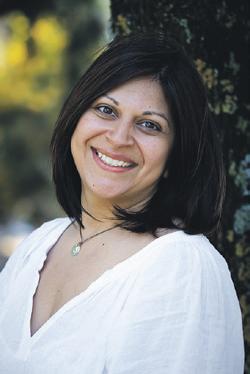
Celebrating with Light

St
Lucia’s Day in Sweden
On the longest day of the year, St Lucia is honoured with candles.

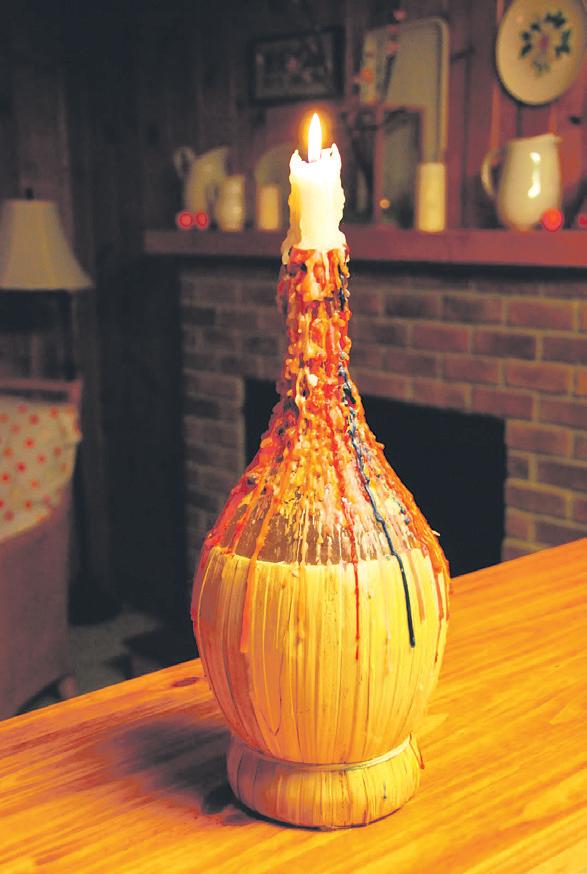

Christmas in France
Lights are lit on four consecutive Sundays before Christmas.
Hanukkah
The Jewish festival of lights. St Martins Day in Holland
Children carrying lights go from house to house singing.
Diwali, the festival of light in India
Celebrates the triumph over darkness/ ignorance.

Christmas in China
Christians light paper lanterns outside the house.
DID YOU KNOW…
There is a fish named Candlefish. This fish, also known as Smelt, has a silvery and oily skin. The ancient native Alaskans used to push a piece of bark into the fish down to the bottom, and light it. The oil in the fish would allow the bark (the ‘wick’) to burn for a long time.
It takes 8 minutes 17 seconds for light to travel from the Sun’s surface to the Earth. It would take a car 177 years to travel the same distance.
A flash of lightning is brighter than 10,000,000 100-watt light bulbs
There is enough electricity in one lightning bolt to service 200,000 homes. Sunlight is able to penetrate ocean water to a depth of 240 ft.
Heavy dust on a light bulb can block half the emitted light.









Pearls of wisdom Pearls of wisdom
Who is more foolish, the child afraid of the dark or the man afraid of the light?
~ Maurice Freehill
It is better to light a candle than curse the darkness.


~ Eleanor Roosevelt
Happiness can be found, even in the darkest of times, if one only remembers to turn on the light.
~ Dumbledore in Harry Potter and the Prisoner of Azkaban, 2004
OCTOBER (2) 2011 <> 79 NATIONAL EDITION KIDS
As straight as a jalebi
BY RAJNI ANAND LUTHRA
One afternoon not so long ago as I drove home from work, I felt an irresistible urge for…. jalebis. I’m just tired, I told myself, and probably looking for a sugar kick. I could stop by at a 7-11 and get myself a bar of chocolate instead. Or I could ring the husband and get him to bring some jalebis home tonight. Or, I could turn towards West Ryde right now, and get some from the Indian shops.
I picked option three. Surprising for me, since I am not usually prone to such impulsive acts of behaviour.
‘Not so long ago’ was actually sixteen years ago, and I was eight months pregnant with my first child.
As I sat back in my car and ate – I am loath to admit this – three whole jalebis, I wondered what my husband would think. He knew me thus far as someone who shunned desserts of most kinds, Indian mithai in particular. I’m not going to tell him just yet, I decided, because he’ll rush down to the shops and buy me a bucket-full. Only last week, when I had particularly enjoyed the sambhar at an Indian restaurant, he had asked the owner-chef if he could buy 2 litres of it. (“We don’t usually sell take-away sambhar by itself, Luthra saheb, but seeing as your wife…..”)

As I sat licking my jalebi-sticky fingertips (I am loath, again, to admit this), I wondered what my brothers back home in India would
think. Every so often, they would bring home fresh hot jalebis from the local shops, wrapped in brown paper bags. They ate them with hot milk poured over. I never failed to go “Eeeeewwww”. They always replied, “You should try some”.
Of course they would both understand if they saw me now, I consoled myself, blaming my ‘loathsome behaviour’ on my ‘condition’. We all know there are strange cravings during pregnancy. Once I’m back to my ‘normal’ self, I’ll never eat jalebis again.
Umm, I never got back to my ‘normal’ self. Someone - nutritionists, physiologists, whoever - should do some research into this: some of the new behaviours/ tendencies that come into play during pregnancy, linger on post-pregnancy. Just like the fat we gain while carrying the baby….
The baby. Blame the baby. The baby turned this jalebi-hater, into a jalebi-relisher. I couldn’t describe myself as a jalebi-lover, because I am not one, really. Jalebis can be sickly sweet, and while I do enjoy them around Diwali, it seems my system has its full to last a whole year. Thankfully!
You see, in Punjabi families, it is tradition to have jalebis as prasad (blessed food). So there’s always some jalebis in my fridge during the week of Diwali.
I like them with hot milk poured over.
It was not long after the baby was born, that I tried making my first jalebis. The recipe I had found was a quick-fix one, which used yoghurt to ferment the plain flour batter. I used a zip-lock sandwich bag, one end carefully snipped off, to squeeze the batter
down into hot oil in round shapes that piled over each other. Not bad for a first attempt. I omitted the red food colouring, but not just because of that, my jalebis did not really look like the store-bought variety! I have learnt now that plastic sauce bottles are way better than sandwich bags, so much easier to handle, and mess-free too. I have learned also that you should always do a ‘dry run’ first – a trial squirt on to an empty plate, to get the movement right. Those halwais at the front of the sweet shops back home, had made it look so easy….
Jalebi
For batter
_½ cup plain flour
_1 tsp chickpea flour (besan)
_½ tsp sugar
_½ tsp oil
_½ tsp yeast
_½ cup luke warm water
For syrup
_1 cup sugar
_½ cup water
_1 tbsp lemon juice
_Pinch cardamom powder
_Pinch saffron
For frying
_1 tbsp ghee
_Oil
To prepare batter, dissolve yeast in a tsp of water inside a deep bowl. Add the plain flour, chickpea flour, sugar and oil.
I present here a simple jalebi recipe that would be well worth a try.

There are many variations of it, for instance, rice flour can be used in place of the chickpea flour, or fine-grained semolina, or even urad dal soaked for a few hours and then blended to a paste.
Another interesting innovation is to make ‘apple jalebis’: skin and core apples, then slice thinly into doughnut shaped rounds, dip in jalebi batter and deep fry, then dip in syrup. Try the same method with bananas.
Mix well. Then pour in the lukewarm water and mix to a smooth consistency. Make sure there are no lumps. Cover and set aside for about an hour, in a warm place like an oven maybe. When the batter is ready, pour into sauce bottle
To prepare syrup, mix all ingredients and boil on medium high, stirring intermittently to ensure sugar does not collect at bottom. Keep warm.
To prepare for deep frying, heat oil and ghee. Keep flame medium-high, not high. Test heat by squirting a bit of batter in – it is ready if the batter rises to the top immediately. Squeeze batter into the oil in concentric circles into the oil. Turn over after a minute; they should be done when they look gently browned. Drain on kitchen paper briefly and then dunk into the syrup. Give them a good soak both sides, a minute each maybe, and then remove. Best served hot.
80 <> OCTOBER (2) 2011 INDIAN LINK
It’s a traditional sweet that’s come through the ages in Indian cuisine, and it still has the ability to create mouth-watering cravings
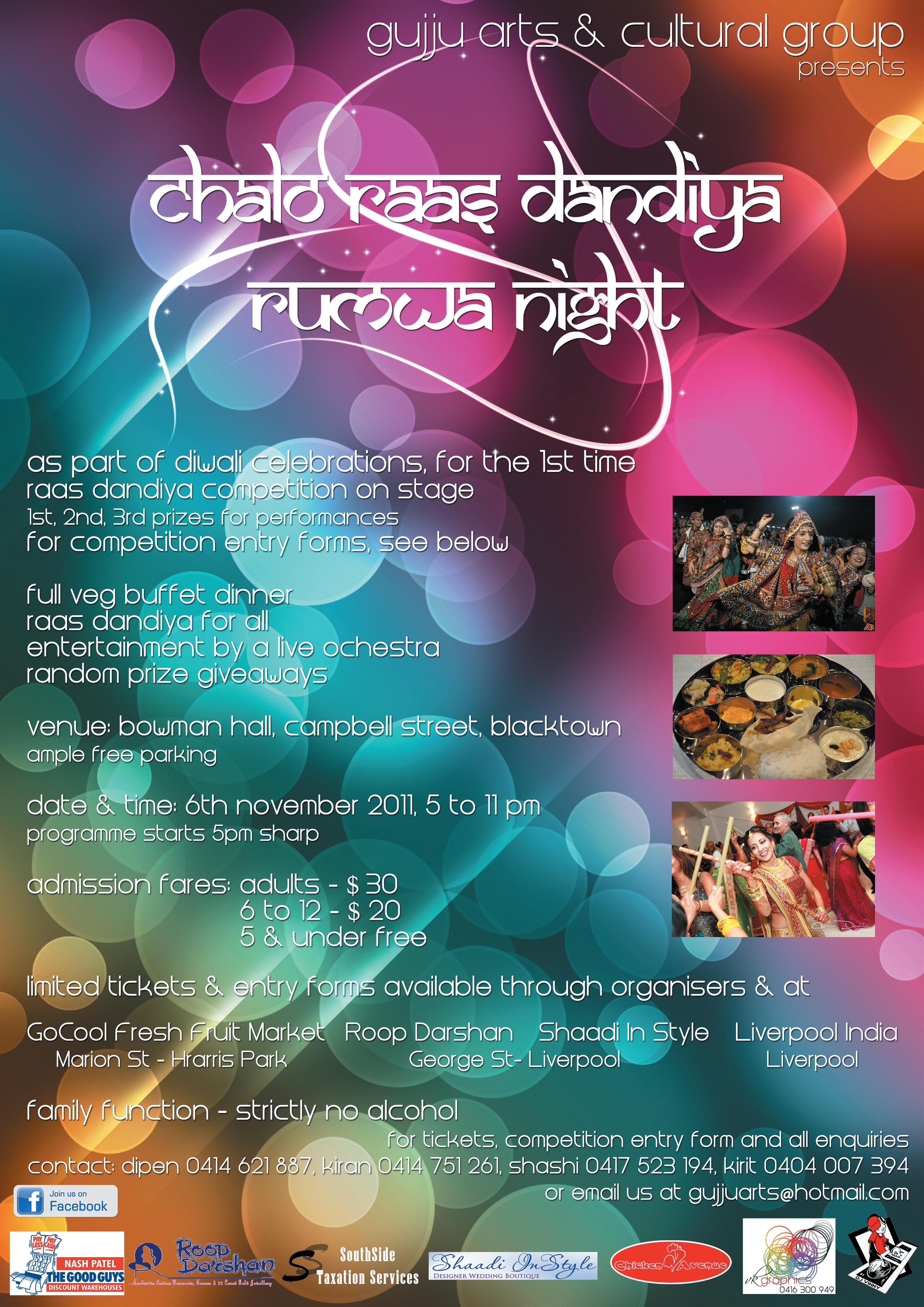
OCTOBER (2) 2011 <> 81 NATIONAL EDITION
Matrimonials
Seeking Grooms
Seeking match for Hindu Arora girl, 24, professional, employed well, born and brought up in Sydney. Well educated and settled family. Boy with similar background preferred. Email: rtmkh8064@gmail.com or call 0405 488 042.
Seeking suitable match (from Australia, never married) for Hindu girl 34 years, Chartered Accountant (non-veg), living in Australia over 25 years, with eastern and western family values. Please email with all details on ganesh2011v@gmail. com
Correspondence invited from well-to-do established young man (aged between 33 to 37) for a charming, pretty girl of 33, settled in Australia and working in IT industry, profile in Jeevansathi.com TTU0136. Please contact with recent photo and profile on sharad46@tpg. com.au, home phone 02 9713-2893.
Seeking a suitable match for May 1979-born girl, UK citizen, Australian permanent resident. Currently Pharmacist in UK, but would prefer to settle down in Australia. 5ft 7”, slim, vegetarian. Hindu Punjabi Khatri background. Father retired, mother working part-time in govt job, one brother (all in UK) and one sister (married and settled in Australia). Contact redvanilla101@hotmail.com
Looking for an intelligent, handsome, Sikh boy for my younger daughter 25 years old, 5’6”, slim, fair, beautiful and working in Insurance industry with Finance background on high income. We have been settled in Sydney for the past 35 years. My elder daughter is happily married here in Sydney. Please respond with your details and photo to 24advertiser@gmail.com
Seeking Brides
Seeking a suitable Australian Resident girl (Khatri, Brahmin, Sikh) for good-looking cleanshaven Khatri boy (Manglik) 08/10/1984, 5’9”, well-
educated. B.Tech Mechanical (Production) from N.D.E.C Ludhiana, presently working in MNC in India (Punjab). Elder brother and sister-inlaw settled in Sydney for the last five years. Good family background. Belongs to Distt Hoshiarpur (Punjab). Please contact mobile: 0432 841 613 or email sunny_ nannu0082@yahoo.co.in
Suitable match for 1975born, clean-shaven Sikh Khatri boy, 5’ 9”, M.P.M, M.C.M (from India). Recently finished Masters in I.T from Australia. Boy is temporary resident and currently preparing to file for P.R. Has full-time job in service industry with decent income. Staying with elder brother and parents (who are on 1-year visitor visa) in Sydney. Girl should be tall, well educated with pleasing personality and must be from Sikh background. Early marriage, serious proposals only please. Phone: 02 94764570, email jas_ghai01@ hotmail.com

ENROLL NOW!!!

82 <> OCTOBER (2) 2011 INDIAN LINK

OCTOBER (2) 2011 <> 83 NATIONAL EDITION
Deepadasi
 BY RANI JHALA
BY RANI JHALA
“Come, my child,” Ma said as she led the way. I took my first step as I heard her add with a smile, “There is much I need to learn from you.”
‘
Ma’, as Mata Sitamayee was lovingly called, was among the many neo-saints of modern India. As society moved towards materialistic success, gurus and mas were sprouting everywhere. It was normal to see each of these saints amass a large following, and amidst them were several famous and materialistically successful people. It is these folk that became the true evangelists for these saints, to whom they give the bulk of their donations.
So when Ma asked me to come forward, I was elated at the privilege, yet matter-offact about the honour. People knew of me, the world-renowned actress, more than they knew of Ma. Of course she would pick me from the crowd and of course, she would want to learn from me.
I followed Ma and her assistants into the prayer hall. There in the centre of the room was a fountain. Around it was a winding waterway that meandered around, forming a serpentine-like formation. A waterfall slid over a rock face that made up one wall of the great hall.
“Come, child, it is a special night, help me prepare the lamp,” said Ma.
“Special night? Oh I see, thank you Ma, that is very kind of you,” I replied, trying to sound modest. Of course it would be a special night. It was not often that fame graced a modest ashram. I looked up to see Ma smile.
As we reached the fountain, several of her assistants came in with trays and placed them on the ground. Ma sat on the floor and motioned for me to sit beside her. As I moved to her side, I watched as more women arrived with trays, placing them besides the ones they had already put down.
“What would you like to be, the lamp, the wick or the oil?” Ma asked.
“I do not understand,” I replied.
“We are preparing the lamps for tonight. Everyone will help by adding that which represents them best,” Ma clarified and then added, “I see confusion. What does it take, my child, to make a ‘diya’. The lamp, the wick and the oil! If you think your life is like a lamp, then decorate these earthen lamps, if your life has been like a wick, roll this cotton into slender wicks and if your past resembles the oil, take this jug and pour the oil into the painted lamps.”
“How do I know which item represents me best, Ma?” I questioned.
“Ah, I see that some things are not taught in the celluloid world,” she said, smiling. “Come, we will learn together.”
We sat down and Ma picked up an earthen lamp. With the colour yellow made from
turmeric paste, she painted dots along its entire rim.
“Here take this lamp, a vessel made for our convenience, so that it can hold that which is put in it. It is made of earth, air and water and represents us. It has great capacity to hold and imbibe that which is put in and it has the strength to let burn without being burnt. It is the Karmayogi,” she explained.
I looked at the lamp in Ma’s hand and then back at her, “Ah Ma, it represents us,” I whispered.
“Yes, child, it is our body,” she confirmed.
Then, pinching apart a small ball of cotton, she rolled it between her fingers, transforming it into a slender thread.
“This ‘bati’ is made from the softest of things. It twists and merges to form a strong twine. It thirsts for knowledge, it hopes for direction. It knows its purpose. It is the Dharmayogi,” Ma stated.
“Ah I see Ma, it is our mind,” I marvelled at my own intelligence.
“Yes, it is the Dharmayogi who wanders through life burning fiercely for knowledge and is ever-thirsty for answers,” she replied
Then Ma picked up the pitcher and poured the oil. I watched as the wick absorbed the liquid until saturated, it could absorb no more.
“Fuel, the power behind every action; the strength behind every deed. It is the source sought by all. The final part, that unites and completes. It is the Purnayogi,” saying this, Ma handed me the lamp.
ued to frown, she proceeded with the words, “Child, it is your soul. It is that which connects and that which empowers. It is that which enlightens and that which liberates. It is your powerhouse.”
“Ah Ma, I see now, the lamp is man, useless until the mind and soul unite to enlighten,” I said.
“Yes my child, did I not say, I have much to learn from you?” Ma smiled.
I knew by now, the game Ma had just played. From the teacher I had become the taught. Now aware of how Ma worked, I asked, “What is so special about tonight, Ma?” Even as I asked, I knew I was no longer the reason.
“It is Deepavali, my child. The night when good triumphs evil: the evening, darkness is overcome by light. The moment when a nation welcomes back justice, truth and divinity! It is the event that confirms the return of righteousness and gives back the power that once belonged to the Gods,” said Ma passionately.

I looked down, ashamed. Here I was, Bollywood’s leading lady, thinking I was the centre of the night, when all I really was or would ever be, was another spark of the mighty flame, who Ma was uniting with its source.
When I looked up, Ma held three items in her hand - the lamp, the wick and the oil.
84 <> OCTOBER (2) 2011 INDIAN LINK
FICTION
A simple symbol can become a powerful element that helps on discover the soul and understand divinity
And it was normal to see each of these saints amass a large following, and amidst them were several famous and materialistically successful people.
www.indianlink.com.au
Here I was, Bollywood’s leading lady, thinking I was the centre of the night, when all I really was or would ever be, was another spark of the mighty flame, whom Ma was uniting with its source

OCTOBER (2) 2011 <> 85 NATIONAL EDITION Suite 1, 20 Charles Street, Parramatta NSW 2150 2 minutes walk from Parramatta Station Phone: 02 9630 7533, Phone: 1300 502 565
BUZZThe
ABHILASHA SENGUPTA brings us up-to-date on what’s hot and happening
An Australian degree finally for Big B

He turned it down the first time when they offered it to him. But looks like Amitabh realises he probably acted in haste. Or he thinks the Indian students’ issue is all resolved now… either way, by the time this paper hits the stands, India’s most recognisable personality Amitabh Bachchan will have an Australian degree to his name.
“The Queensland University of Technology (QUT) honours me with a doctorate on the 20th of October in Brisbane… deep gratitude,” Amitabh posted on micro-blogging site Twitter.
The 69-year-old will go to accept the honour post his shooting schedule.
Meanwhile, Amitabh is enjoying every bit of shooting for his Hollywood debut The Great Gatsby, directed by Baz Luhrmann. He is in awe of
the working style on the film, which is an adaptation of F. Scott Fitzgerald’s classic and has Leonardo DiCaprio in the lead.
“Long meticulous rehearsals with Leonardo Di Caprio, Tobey Maguire and Joel Egerton, for a small scene… incredible detailing,” he added.
“It has been a delight to be associated with a production that must, in my opinion and limited experience, be described as incredible,” Bachchan posted on his blog bigb.bigadda.com.
“The sheer level of management to detail and correctness in every sphere is by itself an exercise in the ultimate,” he wrote.
“And why not. When history shall refer back to the effort made in restoring the contents of a literary work on film, they must indeed have
the perfection of detail, if not anything else, in homage to the author,” he added.
The 69-year-old is currently here in Sydney, shooting for the film. Also starring alongside him and Leonardo are Toby Maguire, Carey Mulligan and a host of other most prominent artists from all over the world.
“It has been rewarding to be in the company of those that have mastered the art of presentation in a medium that also forms a vital part of my profession too, and I can only say that even though I am well past the age of learning and experience, there is still mountains to imbibe and conquer and educate ourselves with,” he added.
Well articulated, as usual, Big B. Here’s hoping you have a pleasant and rewarding time in Sydney!
Kat’s the coolest
Now we all know that Katrina Kaif’s super-hot ‘n’ sexy, but being named the most searched celebrity on mobile videos has put our desi beauty into a different league. Kat’s come up tops, beating even international stars Britney Spears and Linday Lohan who are at second and third spot respectively, reports Global Video Insights for September, released by Vuclip, the world’s largest independent mobile video service. Unsurprisingly, Kareena Kapoor is on the fourth spot, while singer Beyonce Knowles came fifth.
Dabangg girl Sonakshi Sinha occupied the sixth place. Singer Pitbull, teen sensation Justin Bieber, Shakira and Don Omar wrapped up the top ten. Well done, Kat, may your star keep shining at the top spot!
Kashmiri wedding for Rockstar
After showcasing Punjabi wedding celebrations in his films Jab We Met and Love Aaj Kal, filmmaker Imtiaz Ali is on a new matrimonial trip. In his forthcoming release Rockstar, the camera’s focus will be on Kashmiri Pandit wedding rituals, a first in Bollywood.
The director, who wanted to keep the movie’s screenplay as authentic as possible, shot the scene featuring a Kashmiri Pandit wedding complete with all its rituals and traditions after a lot of research. To ensure that the traditional element was as genuinely portrayed as possible, Ali met a Kashmiri Pandit family and sat with them to understand the nitty-gritties of their weddings.

From the way food is served in the tram (copper plates) to the traditional dejhor which is Kashmiri jewellery worn in the ears (symbol of a married woman), along with the shaneel fyran (velvet dress/ outfit), the intricate henna patterns and the tarang wears during the wedding ritualsAli took care to research it all.
Imtiaz and the team also walked to Srinagar’s popular Kheer Bhawani temple, met the priest and watched his daughter’s wedding video to have a visual understanding of the rituals.
Even for the bridal dress, designers Manish Malhotra and Aki Narula roamed around the streets for hours to get the perfect traditional attire.
To add more authenticity to the shoot, the locals who were part of the scene were given full freedom to inform the filmmaker if anything was amiss. And carrying it off in bridal
splendour will be newcomer Nargis Fakhri, looking stunning in her character. Ranbir Kapoor will also star in the movie slated for release in early November. So get ready for a treat, folks!
Spooky sightingSmita
Bollywood can come up with the funny, fanciful and plain weird, as in the case of this latest story doing the round of Tinseltown. Prateik Babbar is just about making his mark in Bollywood, and the poor guy’s been trying for a while now to avoid comparisons with his famous mum, Smita Patil. While working on My Friend Pinto, apparently a lot of the crew and cast, including Prateik, director Raghav Dhar and producer Sanjay Leela Bhansali began to feel the presence of the late actress on the sets, particularly when shooting with her son.
“We don’t know what it was. But we certainly felt something. Smita inspired me to sign Prateik. I was a big fan of hers,” Bhansali says.
A crew member admits, “At times it was chilling. Not just Prateik or the director, many of us felt a presence. We don’t know what or who it was. But there was definitely something there.”
Prateik has said with vehemence that he would like to break away from the constant comparisons with his mother, which may be unlikely if Smita’s presence continues to dog her son’s life.
“We felt as though she was watching over us all through. It was more than uncanny,” says a source close to the film. “It came to a point where we began to feel she was physically present during
GUESS WHO
Her first release is not out until next month but this newbie is already the talk of the town.
86 <> OCTOBER (2) 2011 INDIAN LINK
ENTERTAINMENT
?
(Find the answer under Caption Contest)
the shooting. We don’t know how close Prateik feels to his mother at other shootings. But here she was with us all through. We firmly believe Smita was watching over her son,” says the source.
To further complicate matters, in a sequence where Prateik’s character had to talk about his mother, the young actor expressed reservations, but was convinced that the scene was necessary. “When the poor guy Prateik finally did the sequence he went into a kind of trance while speaking his lines,” says the source. Speaking of the sequence Bhansali said, “Prateik was so close to his own mother at that point that we could almost see her standing next to him.”
“It was clear that he was addressing his own mother. He finally broke down while talking about his mother,” the source adds.
“Though I didn’t have the good fortune of working with Smita, I saw her in every gesture in Prateik. He is uncannily like Smita. The title and Prateik’s name in the film - Pinto - came from a Smita starrer, Albert Pinto Ko Gussa Kyon Aata Hai Smita was there throughout the making of the film,” Bhansali says. Poor Prateik, looks like he’ll be carrying the Smita stigma for a while to come…
Sonam supports pink!

Sonam Kapoor has found a unique way to spread awareness about breast cancer, by urging companies to encourage their employees to wear pink at work as a mark of support for the fight against the disease. Words of wisdom that are sure to be heeded as the actress is a well known and respected fashionista. Wear Pink to Work Day has been planned by the Ogaan Cancer Foundation (OCF) and the ELLE Breast Cancer Campaign, and Sonam, as brand ambassador the OCF has willingly taken on the mantle of spreading awareness of the disease.
“It is my privilege to be associated to play a part in spreading breast cancer awareness. Everyone seems to know someone with breast cancer - I lost an aunt to it. Detecting cancer early is the only way to fight and that requires awareness about tests and a healthy lifestyle,” she said.
“I hope I can make a difference in my own way,” she added. Sonam already has over 40 corporate houses participating in the initiative, with many more slated to join in.
Now let’s hope Bollywood’s rich and famous do their bit in social awareness, like this young actress.
SRK Superhero is a family man
Now if there’s one thing that’s keeping superstar Shah Rukh Khan happy these days, it’s the thought of his forthcoming megabudget movie claims that the sci-fi thriller has been created using world-class technology with a theme of a superhero living in a family.
“I have made a movie which no-one can claim is created using second-rate technology. will take the technology used by Bollywood to the world. It is part of my legacy in Bollywood, which has given me so much,” said Shah Rukh, somewhat emotionally.
“I want our cinema to be best in the world. The movie
will leave a mark internationally,” he said. “I was inspired by a lot of superhero movies, but I have made an original movie. In fact, RA.One will be the first superhero-based movie in the world in which a superhero lives in a family. It is a family entertainer.”
KATRINA

Talking about the making of the film, King Khan revealed, “I used to take almost 50 minutes to wear the superhero uniform and two-and-a-half-hours to get ready completely. It took us almost eight hours to create the car scene, which is being shown in promos. I enjoyed doing all these, but now I want to make romantic movies.”
However, the actor preferred not to comment on how much business the movie is expected to do, and if it will do better than arch rival Salman Khan’s recent hits.
SRK also commented that the villain in the movie played by actor Arjun Rampal, has received thumbs up from fans and the film fraternity. “Am so glad everyone likes Arjun’s look in the theatrical trailer... the guy worked his butt off for it and his hair!! thanx bro for the belief,” Shah Rukh posted on Twitter.
Directed by Anubhav Sinha, the film also has Kareena Kapoor in the lead role. So will SRK as G.One strike lucky? Will this be the SRK.One? Let’s wait and see…
Ranbir to search talent via FB
Now here’s some good news for wannabe aspirants to Bollywood. Actor Ranbir Kapoor is launching a search for actors through Facebook, auditioning them on the social networking site for the movie New Star of India. The young star says that nobody has attempted something like this earlier. The 29-year-old, along with Nissan India, is searching for 20 contestants. The aspirants can join the talent hunt competition, which starts on October 19, by uploading a short clip of themselves.
The 20 winners, who will be selected by online voting, will appear alongside Ranbir in the movie.

“I’m incredibly excited to be involved in this ground-breaking movie with Nissan - noone has attempted anything like this before. Speaking to all Bollywood fans out there, this is your once-in-a-lifetime opportunity to join me in the magic of the movies. I’m looking forward to seeing your auditions and can’t wait to meet my co-stars, so get dancing, get voting and get involved,” Ranbir said in a
The finalist will also get a chance to produce the movie, choose its music, work on the wardrobe and name the characters. will be premiered in various cities across India in January next year. So will you be the next star?
What’s the chitchat here between sisters Shilpa and Shamita?
Send in your responses to info@indianlink.com.au and win a surprise prize
Last issue Caption Contest winning entry
What’s the chitchat between Preity and Salman?

Preity: Call yourself a hunk? Struggling to lift a lightweight like me…. Salman: It’s your damn platform shoes. Devita Pathi (Thorngate, Adelaide)
Devita wins a CD of new Hindi film Bodyguard
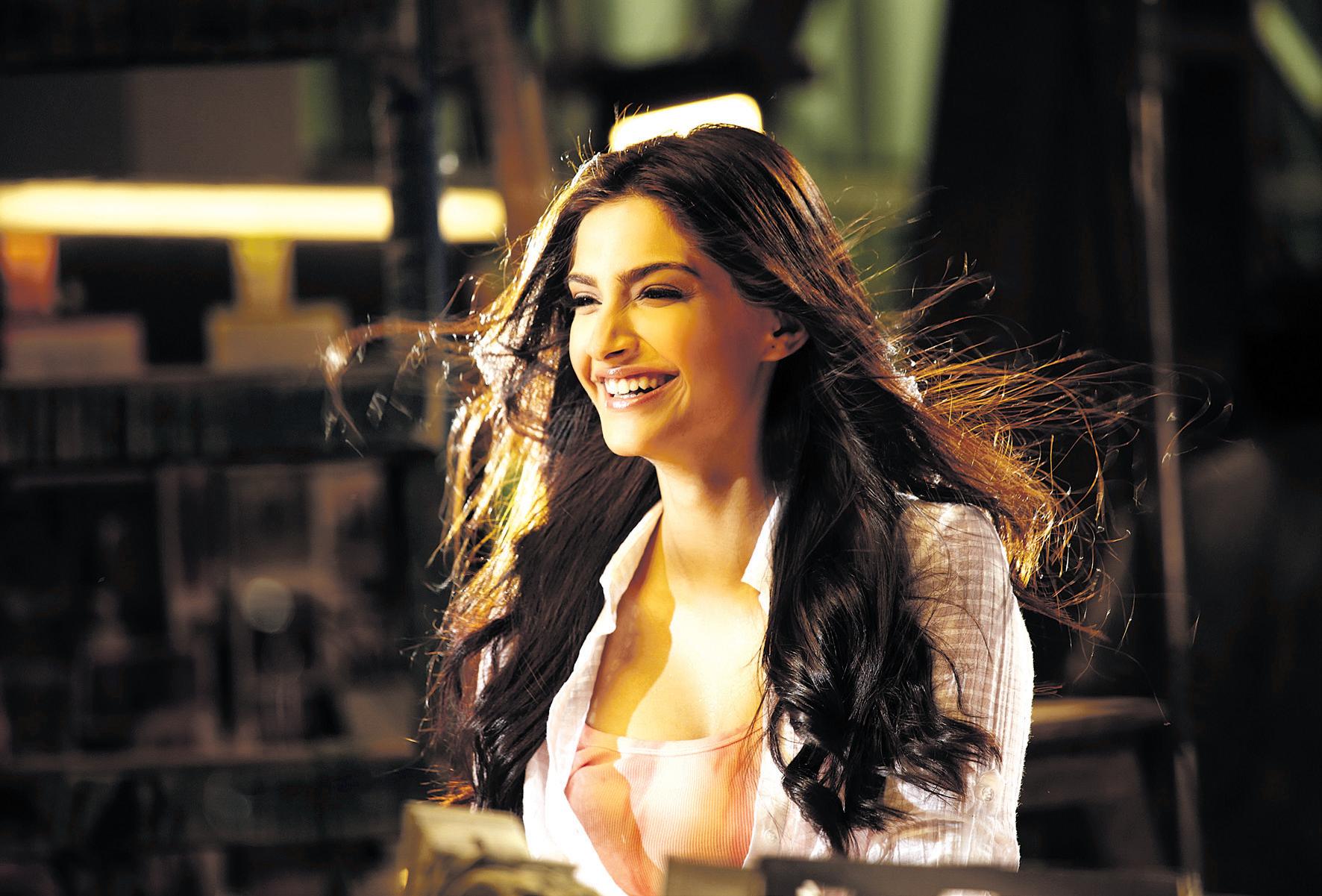
1. Fill in the blanks: Mera joota hain ________. Patloon _________. Sar peh lal topi _________. Phir bhi dil hain ________.
2. What was the name of Basanti’s horse in Sholay?
3. In which Bollywood film did Sylvester Stallone, Whoopi Goldberg, Denise Richards and Holly Valance make a cameo in?
4. Which actor is the only actor to win 8 consecutive FilmFare Awards?
5. Which actor is known for the films Cooli No. 1, Hero No. 1, Aunty No. 1, Beti No. 1 and Anari No. 1?
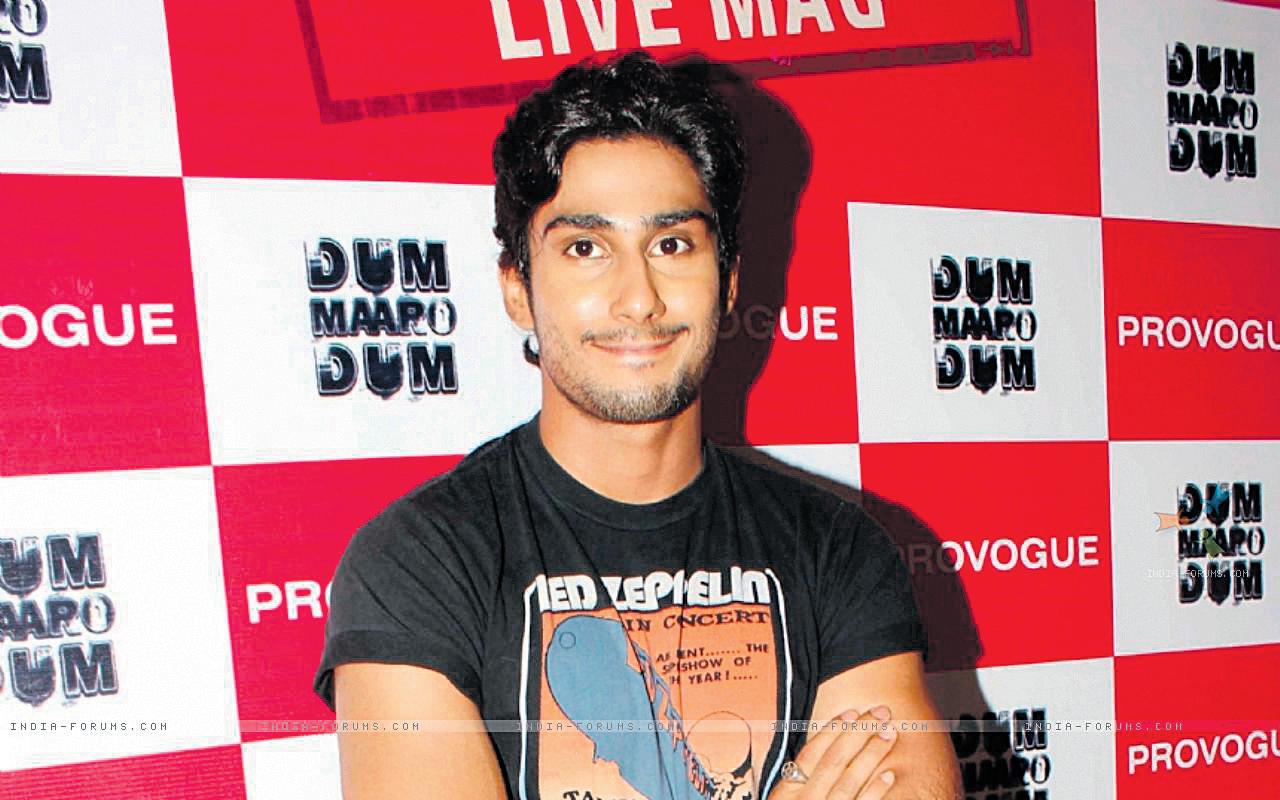
OCTOBER (2) 2011 <> 87 NATIONAL EDITION
www.indianlink.com.au CAPTION CONTEST FakhriNargisWHO?GUESStoAnswer Answers to QUIZZ: 1.
Japani. Englishtani. Russi. Hindustani. 2. Dhanno 3. Kambakkht Ishq 4.
Anupam Kher 5. Govinda
SONAM QUIZZ
RANBIR
PRATEIK
Cine Talk
A fresh, urban rom-com
Film: LoveBreakupsZindagi
Cast: Zayed Khan, Dia Mirza, Cyrus Sahukar, Tisca Chopra

Director: Sahil Sangha
There is only one death in Love Breakups Zindagi (LBZ). And it isn’t the death of our faith in the power of the rom-com to move and engage us.
When during a long wedding festivity in Chandigarh, the affable Beejee (Farida Jalal) quietly passes away, you are suddenly awakened into a world beyond the love and breakups that consumes the zindagi of the average 20-something urban youngster today.
Blessedly, the characters who inhabit debutant director Sahil Sangha’s plot are young, urbane, hip and happening, but not annoying in their shallow concerns. This is the world that the writer, Sanyukta Shaikh Chawla knows inside-out.
Sangha occupies the rom-com territory with confidence, dignity and pride. But luckily, it isn’t the arrogant pride of a filmmaker who thinks he knows it all.
The debutant seems to share our bemusement and curiosity about the characters. He seems to explore their world with inquisitive candour, giving them space to grow even as they groan and whine and dine their way through a series of well-written misadventures that
never end in an embarrassing dead-end. Yes, you know the culmination. You know Jai (Zayed Khan) will get rid of his bossy fiancee and Naina (Dia Mirza) will be out of her suffocating relationship with a man who loves her but not in the way she yearns to be. You know how it will finally turn out. And yet you get involved with the lives of these mismatched pairs looking for love, warmth and togetherness in a fastmoving world of cut-throat dreams.
Sangha lets the lives of his protagonists take their own time to get to know their hearts and mind. He is in no hurry to tell his story. The pace is steady and the flow of events, not quite the rapidfire round in a quiz show. Cinematographer Aseem Bajaj has shot the characters in warm detail. The cities of Delhi, Mumbai and Chandigarh are never accentuated by the visuals. There are questions to be answered on what makes the urban relationship an endangered phenomenon. As the characters explore their own befuddled emotions and their misplaced devotions, the narration acquires its own momentum.
Here’s a director who is unapologetic about letting his characters speak their hearts out. Sangha keeps intrusive devices such as the background score at a bare minimum.
Love has its own reasons. So does this lovely, aesthetic and decent exploration of love and relationships.
The characters speak a language and words that you’ve probably overheard between couples at cafes and in the
the film builds to a foregone conclusion (thank god the hasty reunion at the airport is avoided), there is no apology for having adhered to the rudimentary regulations of the rom-com.
LBZ is a mellow and lingering look at lives that don’t seem borrowed or faked. The film’s title says it all. Happily, this juicy slice of urban life delivers its drama with minimum fuss and optimum insight into how relationships tick and get tweaked in today’s troubled times.
Curiously, there isn’t a hint of sexual intimacy between the protagonists, or for that matter between the protagonists’ friends, played with a casual confidence by a younger Cyrus Sahukar and an older Tisca Chopra, who discover belated love.
The characters convey the warmth of a breakfast meeting conducted in
Losing hearing, gaining soul
Film: Soundtrack

Cast: Rajeev Khandelwal, Soha Ali Khan, Mohan Kapoor
Writer and Director: Neerav Ghosh
Hear this. DJ Raunak loses his hearing ability and gets to hear the voice of his conscience. Great premise for an onscreen human drama? Debutant director Neerav Ghosh, with incredible support from his leading man Rajeev Khandelwal, creates an engrossing defence of anti-hedonism.
Excessive self-indulgence is dumb. It can also make you deaf. So says the film’s well-crafted screenplay. The message is driven home with a refreshing absence of self importance.
A lot of the film’s drama, if not all, is derived from Canadian film It’s All Gone Pete Tong released six years ago. That film’s inspirational thrusts are transferred with fluency and virility into Ghosh’s art attack on the wages of excessive pleasure-pursuit.
Paul Kaye, who had played the lead in the original film, had delivered a pitchperfect loss-of-hearing gain-of-soul performance. Khandelwal goes beyond the exigencies of his character in search of his lost character’s tortured soul.
In the sequences where he comes to terms with his deafness, the actor brings to his face and physique the unmitigated anguish of a man watching himself topple over the edge.
It’s a brilliant performance, by far the best male performance this year. Whether it’s the body language of a wild DJ partying his nights away in a haze of alcohol, or sharing those tender moments with Soha Ali Khan (cute, gentle, sensitive and effective), Khandelwal’s face maps out the character’s tormented flight into terrifying stillness.
Playing a man who watches his life spin out of control, the performance could have easily toppled over the edge. It holds.
The director uses a fabulous soundtrack. There are startling rock ballads punctuating Raunak’s voyage into the damned. Old songs like Yeh jeevan hai iss jeevan ka yehi hai rang-roop or, for a beautifully crafted romantic interlude between Rajiv-Soha
in the park, Khullam khulla pyar karenge hum donon are used to endearing effect.
The narrative moves in three predictable but pulsating sections.
Raunak’s descent into a hedonistic hell, his shattering deafness and, best of all, the redemption that he finds through a haze of self-loathing as he takes flight into a world of idyllic love (a touch of Guru Dutt’s Pyasa in the end when Raunak simply vanishes from the world of ruthless self interest) -- for a first-time director, Ghosh displays remarkable control over his scattered material on his shattered protagonist.
Admittedly the storytelling device (well-known real-life DJs and VJs are roped in to talk about ‘Raunak’) is borrowed from the Canadian film. But what the hell! Nothing in life is original. Not heaven not hell. Not pleasure, not pain, and certainly not art.
The absence of over-sentimentality and the self-mocking humour applied to Raunak’s predicament imbue a wealth of mellow maturity to the storytelling.
Yup, Soundtrack gets it right. In telling the story of a man who stops hearing the world outside to finally start hearing his own inner voice, the film’s strong sense of drama and redemption are
winter sunshine. Zayed and Dia slip so effortlessly into their parts that you wonder what keeps them from reaching the top. Zayed has worked on getting his timing right. He is a revelation. Dia’s empathy with her character’s inner world is visible in her smile and eyes. She is a far better actress than she is made out to be.
There are endearing cameos by Shabana Azmi, Boman Irani and Shah Rukh Khan. But that isn’t the reason why you’d want to see this amiable film. Treating his in-love twosome with genuine warmth, director Sangha displays confidence and sensitivity. Here’s a take on that thing called love that’s urbane, intelligent, sassy and involving.
Subhash K. Jha
with snatches of a music that transports a fairly routine inspirational story to the sphere of a modern moral fable.
As for Khandelwal, his performance is so accomplished that he proves, not for the first time, that he’s among the most engaging actors today. For the money, time and attention, he is the true rock star.
88 <> OCTOBER (2) 2011 INDIAN LINK
Subhash K. Jha
ENTERTAINMENT
Taking action to a new level
Film: Aazaan
Cast: Sachiin Joshi, Candice Boucher, Sarita Choudhary, Aly Khan, Ravi Kissen and Aarya Babbar
Director: Prashant Chadha
As we see rescue operations post a bombing attack being carried out in slow motion, the soundtrack goes almost inert in a show of frozen protest…And you know there and then that Aazaan has something out-of-theordinary to offer to the action genre.
Tackling global terrorism and Islamic isolation as seen through the eyes of a tormented Muslim secret agent, Aazaan heads towards its flaming phases of flash-points with the least amount of fuss or ostentation. The narrative knows all the sign posts.
The screenplay by Shubra Swaroop is gritty and gripping, ensuring that every episode stays a step ahead of the audiences’ expectations. The characters speak a language that belongs to the world of terrorism and anti-terrorism.
And yet the spoken words in various languages including Hebrew and French do not obtrude or impinge on the harmony that the narrative creates in the discordant disembodies world of serial bombing across the world.
Explosive as the theme is, no one is here to have a blast. The most remarkable aspect of the action in Aazaan is the lack of flamboyance. The
hero (debutant Sachiin Joshi, decent and modest) is a one-man army but no super-hero. He bleeds, he hurts, he feels the lashes on his soul of a world hell bent on destroying itself. We feel him feeling all of this, partly because the screenplay doesn’t shy away from emotions when required. Men do cry. But not for long. Really, guns don’t go with violins. There is a touching but distant story about two brothers ideologically separated by extremism in Talibantorn Afghanistan who come together towards the end in a show of strength where the script emerges the real hero.
Post-interval the clenched tactile plot (no comic relief here) introduces a brief romance between the hero and a Caucasian woman, who we are told, practices a very unusual vocation.
Afreen (Candice Boucher, eye-catching) is a sand designer (not to be confused with a sound designer who does a fine job on this film).
Afreen’s little daughter could possibly save the world from a deadly viral terrorism. Don’t ask how. The action moves with quiet dexterity from Morocco to Agra. The Taj Mahal is under threat. Luckily the action genre is safe. The merger of the themes of global terrorism and the personal demons that drive the characters beyond the edge, is achieved with a surprising lack of brouhaha. Though Aazaan is arguably the best-looking action film shot in India, it neither flaunts its resources nor takes the narrative on a world tour just for the heck of it.
Every location from Morocco to Germany to Hong Kong and Poland is
shot by cinematographer Axel Fischer to stunning minimalist effect. What we are looking at is not the countries and cities that the protagonist visits. But the country of the soul where a battle rages between religious and cultural allegiances and a quest to come to terms with a civilization that needs to stop killing in the name of God.
Aazaan takes the action genre in this country to a new level of finesse and restraint. The script is layered, though not quite free of inconsistencies and of questionable moral and political tenets as it would like us to believe.
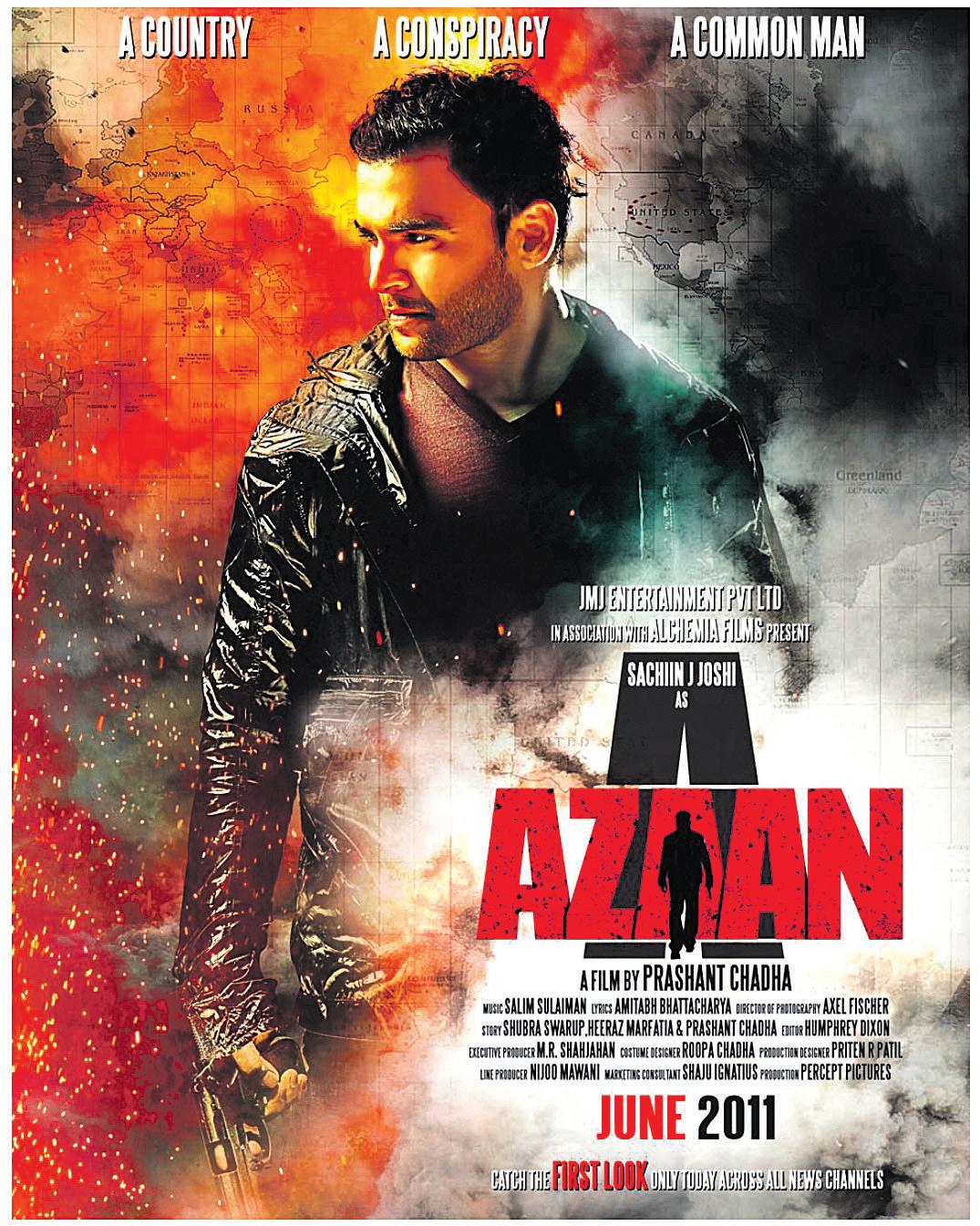
The action is implosive opting for understatement where extravagant mayhem would have been the more obvious choice. The editing (Amitabh Shukla, Humphrey Dixon) is razorsharp. There is no room for humbug in the narrative. Every character that populates the swarming plot has a job to do. It’s done by actors who know their jobs.
The background score by SalimSuleman and the sound design are remarkably bridled.

Debutant Sachiin Joshi knows his limitations as an actor and works his way around them by playing a character who would rather be closer to realism than larger than life. The other performances particularly Aarya Babbar,
Ravi Kissan and Aly Khan too are in keeping with the film’s less-is-more mood. But what on earth is the talented Sarita Choudhary doing in a role that looks like James Bond’s M on steroids.
As for Prashant Chadha’s direction, not for a second does it allow us to feel we’re watching a film that tells us, terrorism is not a formula for entertainment and violence is not an occasion for choreographed splendour. Style and substance come together in an explosive clasp that doesn’t give us a chance to gasp.
Aazaan is not a film which wastes time in self-congratulation after staging one more terrorist explosion. It moves on relentlessly. The world has to be saved. Self-importance is miraculously averted.
Kukunoor brings on a gentle sonnet
Film: Mod
Cast: Ayesha Takia Azmi, Rannvijay Singh, Raghuvir Yadav and Tanvi Azmi
Director: Nagesh Kukunoor
Ahhhhhhh! It’s been a while since one felt that stab in the heart while watching a love story trot towards its somber culmination. Love’s like that. When put on film, it can make you fall in love with the emotion called love, just like it did in Imtiaz Ali’s Jab We Met.
Ayesha Takia brings to this film a kind of inner conviction that makes you want to believe in her faith in the oft-abused emotion. When Ayesha speaks her lines, they don’t sound written in this under-written film about love that has gone into the realm of the surreal.
Veejay turned actor Rannvijay Singh is the nerdy stranger who walks into Ayesha/Aranya’s tranquil life in a scenic soporific hill station that’s threatened, rather crudely, by a construction magnate whom we overhear saying, “The first thing we’ll do is get rid of all the greenery around here.”
Happily for us and the film, such insensitive moments are too far and in
between to make a difference to the gentle tale of a girl who runs a watch repair shop in town where time nearly stands still.
Nagesh Kukunoor and his lovely leading lady are most comfortable with the silences that punctuate life away from the city. The camerawork by Chirantan Das shamelessly creates picture-postcard images all around Aranya’s life and world. The relationships that emerge from the sedate silences of a life lived in an ageless vacuum are woven into a plot which careens between being a fragile fable and a mawkish melodrama.
Caught in that dim dawn sun when the world looks irresistibly innocent and shorn of corruptibility, the goingson in Mod are so evocative of an era that never existed outside the poet’s imagination that we tend to forgive the plotting excesses that mar the second-half of the film.
The finale on the hilly railway station, however, erases the clumsiness of some of the proceedings in the second-hour. And what we are left with is a film of heart-aching beauty, so tender and evocative that in terms of manmade craft it replicates the intricate thread-work of a Kashmiri carpet where very often the design is so nuanced the naked eye can’t see the craftsmanship.
The film has some truly tender supporting performances from Raghuvir Yadav (playing a zany
(always capable of tremendous empathy) and specially Nikhil Ratnaparkhi as Takia’s overweight suitor who in that one sequence where he pleads and threatens Ayesha Takia to marry him, brings so much bridled emotion into the film you are left feeling satiated with the vast amount of talent that this delicately drawn fable-romance pitches forward. Ayesha, of course, presides over the subtle proceedings. With her effortlessly-drawn emotions she
Rannvijay in a complex role that demands various mood swings from the actor, is surprisingly in-charge. Mod is like a gentle sonnet played on a cosy winter morning. It is the tenderest love story in ages with a central performance by Takia that strikes a chord deep in your heart. Mod is a film you want to hold close to your heart.

OCTOBER (2) 2011 <> 89 NATIONAL EDITION
Subhash K. Jha
Subhash K. Jha
www.indianlink.com.au
A must-watch for social networking addicts
Film: MujhseFraaandship
Karoge
Cast: Saqib Saleem, Saba Azad, Tara D’Souza, Nishant Dahiya and Prabal Panjabi
Director: Nupur Aastana
Mujhse Fraaandship Karoge is a sweet teen romance in the times of broadband connections, social networking sites and fake IDs! It explores the pros and cons of the proposed ‘fraaandship’ networking in our lives. It offers food for thought with: “SACH is the key word and face to face connection is the best connection.”

A new era love story, the film revolves around four characters - Vishal Bhatt (Saqib Saleem), Rahul Sareen (Nishant Dahiya), Preity Sen (Saba Azad) and Malvika Kelkar (Tara Dsouza). Set in a college campus, Vishal with pal Hacky (Prabal Panjabi) are up to pranks with fellow classmates. These initial scenes are a direct rip-off from the Hollywood film The Social Network.
Vishal is a good writer who pens
lyrics for rockstar pal Rahul. Girls are crazy about Rahul, but Rahul seems indifferent towards them.
Also on campus is tomboyish Preity Sen with a passion for photography. She happens to be friends with the hot and happening Malvika Kelkar.
Malvika’s id pops up on Rahul’s profile page and since he is disinterested in adding friends on his Facebook, Vishal takes the initiative. But unknown to him Malvika’s id is being operated by friend Preity. And that’s where the complication in the love story begins.
Vishal chats with Preity thinking she is Malvika. And Preity chats with Vishal thinking he is Rahul. They are head over heels in love in their virtual world.
Meanwhile, the college is celebrating its silver jubilee. A photographic documentary is being prepared of the romantic history of the college. Vishal and Preity are forcibly thrown together for the project. The inevitable happens. They are attracted to each other, but they still fantasise about their virtual relationship.
But how long can fake identities sustain the real love? Reality bites when they confront each other.
Nupur Asthana has deftly handled this complicated love story. A bit disoriented at first, the story sets in after the initial hiccups. The first half is nothing to write
home about and the second half gets you hooked.
Mujhse Fraaandship Karoge is a hackneyed love story but excitingly brewed with fresh faces. The film belongs to Saqib Saleem and Saba Azad - faces to watch out for in the long run.
The bright attractive cinematography adds to the visual impact that captures the spirit of a foreign college campus.
The dialogues are witty but at times seem to go a bit off tangent especially during the bar scene between Rahul and Malvika.
Music-wise, Raghu Dixit creates earsplitting commotion on the dance floor. The lyrics by Anvita Dutt are yuppie and unusual. Vishal Dadlani’s coarse vocals gel well with screechy voice of Aditi Singh Sharma and evoke a musical confrontation in Hinglish “hip-hop” melodic mode.
The film tries honestly to create a bond of friendship with its set of urbane viewers and succeeds to a large extent in delivering it. Well worth a dekho.
A night of adventure in Mumbai
Film: MyFriendPinto
Cast: Prateik, Kalki Koechlin, Arjun Mathur, Shruti Seth, Makrand Deshpande, Divya
Dutta
Written and Directed by Raghav Dar
Zindagi khwab hai khwab mein sach hai kya aur bhala jhooth hai kya?
Remember Motilal’s staggering existentialism in 1956’s Jagte Raho?
The same philosophy underlines the key goings-on in My Friend Pinto -- a wispy, nostalgic comedy about a Goan simpleton’s night of zany adventures in the mad bustle of Mumbai during New Year’s Eve.
This isn’t the first film that explores Mumbai by night. From Khwaja Ahmed Abbas’s Bambai Raat Ki Bahon Mein to Sudhir Mishra’s Iss Raat Ki Subah
Nahin, the dark comic side of the city’s underbelly has ceaselessly fascinated Bollywood since long before the term ‘Bollywood’ was invented.
Debutant director Raghav Dar switches on the innovative mode fullblast. The first and most conspicuous component in his comic romp is the director’s sense of fun. He is fearless about the fun quotient as he takes one sumptuous swoop into lives as different from one another as any two families that live in Mumbai can be.
A semi-retired gangster (Makarand Deshpande) and his never-been star-
actress mistress (Divya Dutta), his twin assassin-goons Ajay and Vijay (played by real life Amin and Karim Hajee who were last seen together on screen dancing in a Sufi trance to A.R. Rahman’s devotional number in Jodhaa Akbar), an old taxi-driver and his gambler-son (theatre actor Shakeel Khan making a stellar screen appearance), a lost girl Maggie (Kalki Koechlin) abandoned by her small-time crook boyfriend on the railway station, the competitive couple (Arjun Mathur and Shruti Seth) coping with the sudden appearance of an unwanted guest from Goa, even as they try to cope with the fissures in their own marriage. There are many others. Oh yes, characters pop out of every nook and cranny like rabbits from a hat. Bringing them all together is the Goan Mama’s boy, the simpleton Michael Pinto who we’re informed, with tongue firmly in the scriprwriter’s cheek, is the nephew of Albert ‘jissko bahut gussa aata tha’ (who gets very angry).
The reference to Saeed Mirza’s 1980 cult classic Albert Pinto Ko Gussa Kyon Aata Hai is not lost in the film’s melee of bustling adventures. The film is knowledgeably laden with references to cinema and cinematic devices from the past including a very pointed allusion to a corpse’s journey across Mumbai from Kundan Shah’s Jaane Bhi Do Yaaron.
My Friend Pinto is a very complex script to write and an even more complex act to pull off on screen. Dar manages the chaos created by Michael Pinto’s misadventures across the celebratory streets of Mumbai with fluency and grace.

The awkwardness that we patterns of Kundan Shah’s Jaane Bhi Do Yaaron.
Dar’s directorial debut is endearing in its eccentricity.
When you leave the crazy comic cosmos of Pinto’s world behind, you take away with you a film that is fiercely original in concept and designed to
deliver tongue-in-cheek swipes at all those scared cows of Bollywood that we grew up watching and loving without knowing why we loved them in the first place.
90 <> OCTOBER (2) 2011 INDIAN LINK ENTERTAINMENT www.indianlink.com.au
Troy Ribeiro
Subhash K. Jha
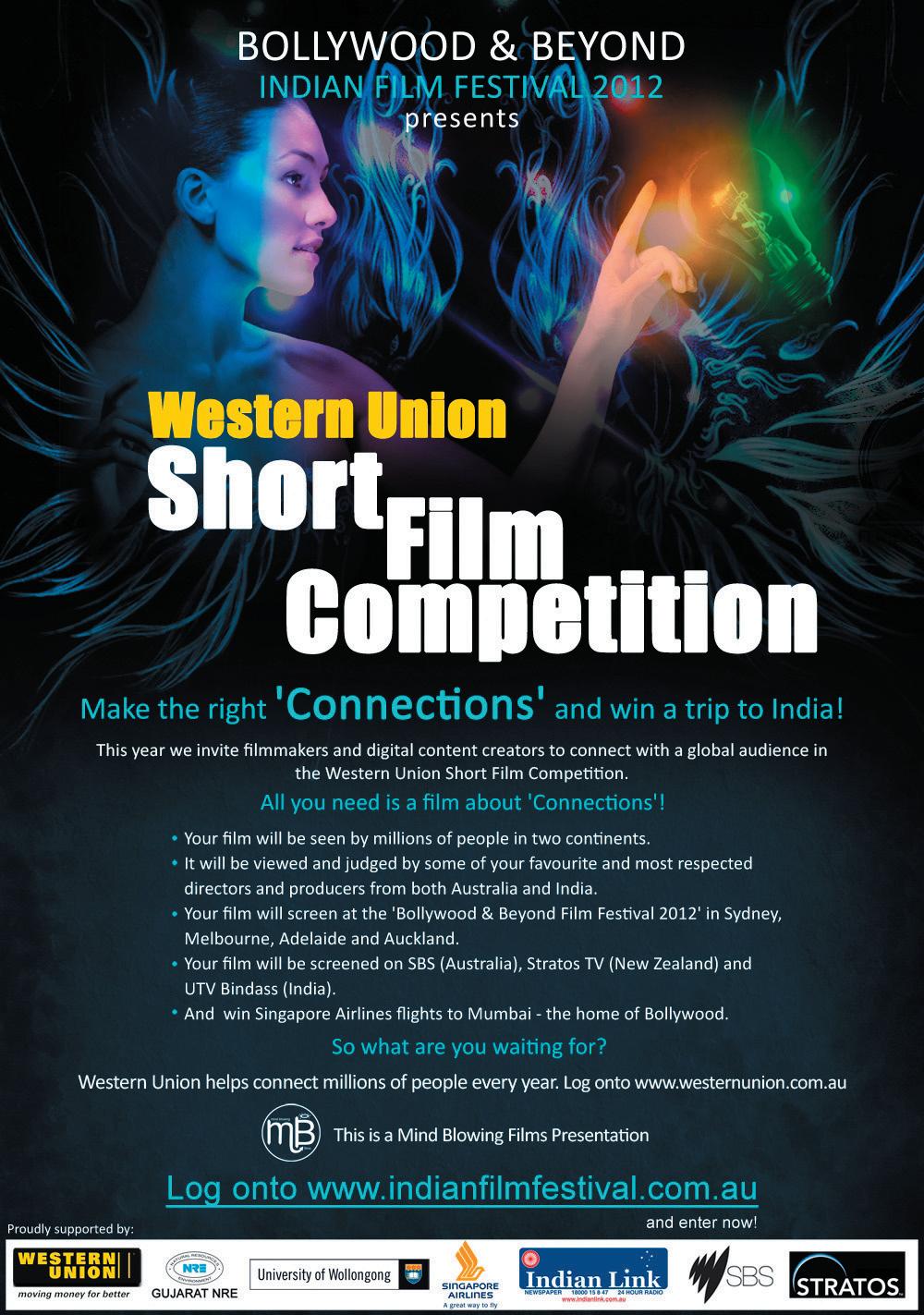
OCTOBER (2) 2011 <> 91 NATIONAL EDITION
Dear Auntyji
I am unhappy and hope you will help me. Last month, my two friends Neelu and Sheelu (yes, I know, these are strange names but they are cousins from Jalandhar) were having lunch with me at Maya. I have known Sheelu and Neelu for the last 20 years and as they were watching Kareena dancing on the screen, they remarked how nice her figure was and that we should do something about our own gola damola figures. I almost choked on my third gulab jamun. Ok, so I am not as svelte as I was when I was 18, but I did not think I was a gola damola. In fact, when I asked Sheelu to explain, she said that each of us could lose 15 kgs to be considered normal. I was silent for the rest of the meal, because yes, Sheelu and Neelu from the back look like two happy elephants waddling along in the sub Saharan desert looking for leafy fronds to chew on but I am nothing like a haathi. From the back, I just look...like....maybe a fat, happy pundit from a temple in Srinagar, but haathi I am not.
But Auntyji, what’s worse is this. Sheelu and Neelu are now dieting and keep telling me how much they have lost - and they tend to tell me this as I am enjoying my rasgullah and boondi ladoo at Maya. Do these two churails hate me, Auntyji? What is the story here? What shall I do?

Auntyji says
Oh, my little gulabo, my little Tuntun, my little haathi mere saathi. Here is what you must do. Go and stand in front of the mirror. Strip down to your underclothes. Now, do you have a definable waist, or has this disappeared under years of abuse from sugary delights? Do you have rolls of fat where your stomach used to be? If you do a little shake, as though you are trying to shake off a piece of something disgusting caught under your chappal, is there a sort of seismic activity across the fat of your body and you can see the ripple effect cascade over your body, like a nightmarish hallucination of the most grotesque kind? Can you see your toes? Does your chest hang down to your belly button? Is your belly button so cavernous that you could insert a child’s hand in there and it would still not reach the bottom? If so, my dear little laddoo, you are bahut moti, a real hathini - and unless you want to end up with obesity related illnesses, I suggest you get on a weight loss program pronto. Sheelu and Neelu are trying to be polite - and they are helping you. So you should be grateful to them. Now, you have already had years of fun with your boondi laddoo and coconut burfi. Now it’s time to acquaint yourself with dal chawal and exercise. PS: in case you’re trying to cling to the last vestige of hope and dignity here, let me be blunt, the only beautiful elephants are those in the wild. Not the two legged kind. So go save yourself. Or else you will become endangered.
Dear Auntyji



Two weekends ago, I was looking for my daughter as we needed to go and see her nani. I sent her a text asking her where she was, and almost immediately I got a reply. The reply was not what I expected. My 18-year-old daughter has a rather plainlooking friend with a somewhat stunning body. Well, Samantha, my daughter’s friend had sent me a photo of her somewhat jawdropping assets. As I stood looking at the photo, somewhat perplexed, my daughter and Samantha burst through the door with horrified looks on their faces. It did not take me long to work out that Sam had sent me the photo in error - using my daughter’s phone and probably trying to be funny to one of their mutual friends. In any case, I had the presence of mind to immediately work all this out, and instead of ignoring this situation - as my wife pointed out I should have done - I told Anjali and Samantha what I thought. I was very polite and kind and quite funny and charming about it, but the girls were absolutely horrified. I told them about the dangers of sexting and told them if they were upset that I had seen the photo, they should be equally upset that other random people could ultimately see it too, and that dignity is an important thing. I thought that I had done the right parental thing. Unfortunately, my wife, when she found out - was quite upset and said that Sam is not our daughter and I should not have said anything and simply deleted the message. What do you think, Auntyji - did I do the wrong thing? I would have forgotten about this incident a long time ago, but my wife seems to have a fixation with this issue.
Auntyji says
Hmm. Your wife is behaving in an unusual manner. I wonder what bee she has in her bonnet. But let’s focus on you for a moment. Let me just say that what you did was absolutely right. You were completely within your rights to speak to the girls and express your parental concerns. As long as you handled the situation with decorum and dignity, and there was no resulting tamasha for which the girls needed therapy afterwards - then you did the absolute right thing. Sam used your daughter’s phone, and sent you - by accident - a photo of her charms. Well, the moment you received the image, you became party to that little natak. But you weren’t the intended recipient - which was probably a good thing. Unless of course that little Samantha is a little pervert who has a crush on you and planned this all along. Let’s assume she is not this conniving. In any case, let’s focus on how you handled it. I am pleased that you left the girls in no doubt about what they were doing. Of course, if Sam had used her own phone to send an image to her own boyfriend or husband or whoever, then it would be none of your business. But in this situation, different rules apply. I hope both the girls learnt an important lesson - so don’t feel bad about what you did. You did your parental duty. Now, about your dear wife. So what is her issue exactly? Have you asked her? Which bit did she not care for? The sending of the image? The use of Anjali’s phone? The unintended recipient? Or the fact that you deleted the image without letting her have a geezer at it? You need to use your charm once again and ask your wife what’s troubling her. Maybe she feels insecure about an 18-year-old sending you an image designed to inspire lascivious thoughts in you. In any case, you have to talk to your wife and ask her what the issues are. Then ask her what she would have done if Anjali had sent one of her disrespectful, gandi images to one of her uncles. What would your wife want uncle to do with the image? Would your wife want Anjali to have a kala mooh in the family? And be called a besharam and behaya behind her back? See what I am getting at?
92 <> OCTOBER (2) 2011 INDIAN LINK
BACKCHAT Do you have a question for Auntyji? Send it in to GPO Box 108 Sydney 2001 or email it to info@indianlink.com.au www.indianlink.com.au
Vexing texting A weighty issue Supermarket for Sale Please call on 0419 600 259 or 02 9667 1878 1 hour from Sydney Takings 20,000 on 7 days Lease 2+5 or ask for new lease 2 scanner machines Rent 830/week Full price $210,000+stock Net Profit $4,500 P/Week > Walk in/walk out > $2,000 net profit/week > Turnover $8000/week > $650 Rent > Very good location > Close to station > Already committed some where else Indian Grocery/ Fruit Shop FOR SALE Please call 02 9622 1630, 0434 484 700 $50,000 inc. stock/ONO Ask Auntyji




OCTOBER (2) 2011 <> 93 NATIONAL EDITION

94 <> OCTOBER (2) 2011 INDIAN LINK

OCTOBER (2) 2011 <> 95 NATIONAL EDITION

96 <> OCTOBER (2) 2011 INDIAN LINK













 BY SHERYL DIXIT
BY SHERYL DIXIT




















 BY RAKA MITRA
BY RAKA MITRA














































 BY RAJNI ANAND LUTHRA
BY RAJNI ANAND LUTHRA





 BY UTTAM MUKHERJEE
BY UTTAM MUKHERJEE
































































































































































 BY PETRA O’NEILL
BY PETRA O’NEILL























































































